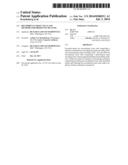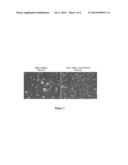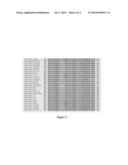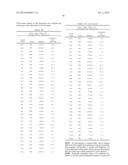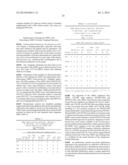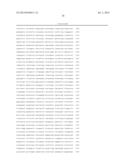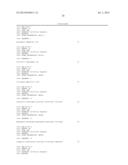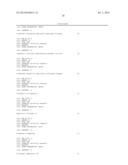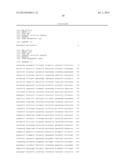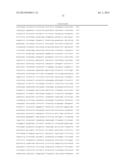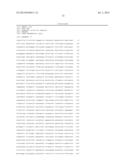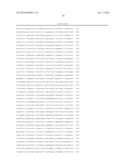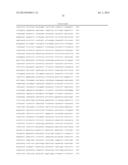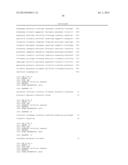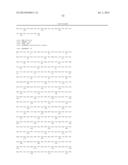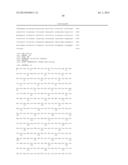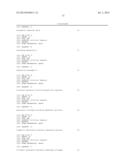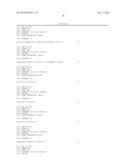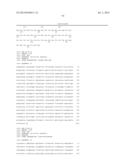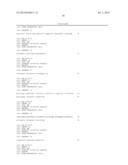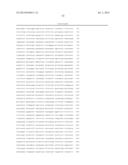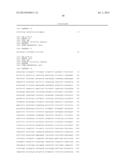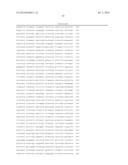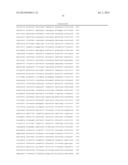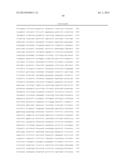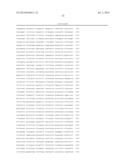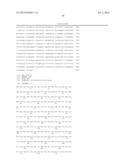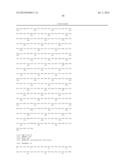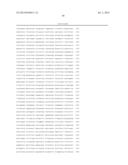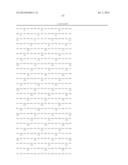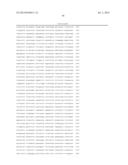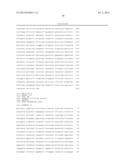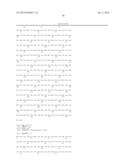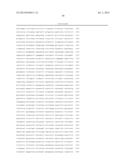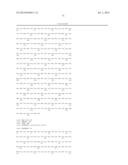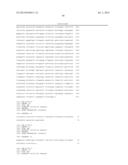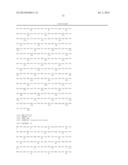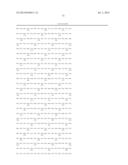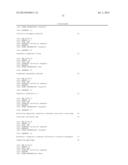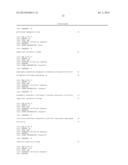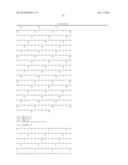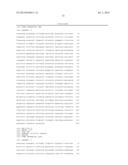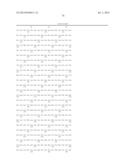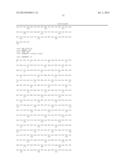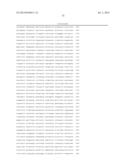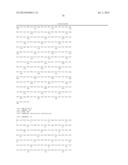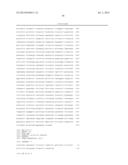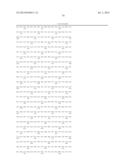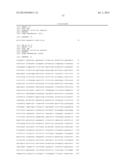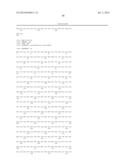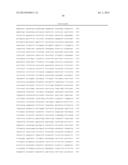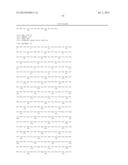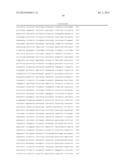Patent application title: RECOMBINANT HOST CELLS AND METHODS FOR PRODUCING BUTANOL
Inventors:
Arthur Leo Kruckeberg (Wilmington, DE, US)
Arthur Leo Kruckeberg (Wilmington, DE, US)
Larry Cameron Anthony (Aston, PA, US)
Larry Cameron Anthony (Aston, PA, US)
Assignees:
Butamax Advanced Biofuels LLC
IPC8 Class: AC12P716FI
USPC Class:
435160
Class name: Containing hydroxy group acyclic butanol
Publication date: 2014-07-03
Patent application number: 20140186911
Abstract:
Provided herein are recombinant yeast cells comprising a deletion or
disruption in an endogenous gene encoding Amn1 and a heterologous gene
encoding Amn1. Also provided are recombinant yeast cells comprising a
heterologous gene encoding Amn1 and an engineered butanol biosynthetic
pathway. Further provided are methods of producing isobutanol comprising
providing the recombinant yeast cells described herein and culturing the
recombinant yeast cells under conditions wherein isobutanol is produced.Claims:
1. A recombinant yeast cell comprising (a) a deletion or disruption in an
endogenous gene encoding Amn1, and optionally (b) a heterologous gene
encoding Amn1.
2. The recombinant yeast cell of claim 1, wherein the recombinant yeast cell further comprises an engineered butanol biosynthetic pathway.
3. The recombinant yeast cell of claim 2, wherein the engineered butanol biosynthetic pathway is selected from the group consisting of: (a) a 1-butanol biosynthetic pathway; (b) a 2-butanol biosynthetic pathway; and (c) an isobutanol biosynthetic pathway.
4. The recombinant yeast cell of claim 1, wherein the yeast cell is a member of a genus of Saccharomyces, Schizosaccharomyces, Hansenula, Candida, Kluyveromyces, Yarrowia, Issatchenkia, or Pichia.
5. The recombinant yeast cell of claim 4, wherein the yeast cell is Saccharomyces cerevisiae.
6. The recombinant yeast cell of claim 1, wherein said yeast cell comprises a heterologous gene encoding AMN1 and is selected from the group consisting of Saccharomyces, Schizosaccharomyces, Hansenula, Candida, Kluyveromyces, Yarrowia, Issatchenkia, and Pichia.
7. The recombinant yeast cell of claim 6, wherein the heterologous gene encoding Amn1 is a Saccharomyces Amn1.
8. The recombinant yeast cell of claim 7, wherein the Saccharomyces Amn1 comprises SEQ ID NO:83.
9. A method for the production of isobutanol comprising: (a) providing a recombinant yeast cell comprising i. an engineered isobutanol biosynthetic pathway, ii. a deletion or disruption in an endogenous gene encoding Amn1, and iii. a heterologous gene encoding Amn1; and (b) culturing the recombinant yeast cell under conditions wherein isobutanol is produced.
10. The method of claim 9, wherein the recombinant yeast cell is selected from the group consisting of Saccharomyces, Schizosaccharomyces, Hansenula, Candida, Kluyveromyces, Yarrowia, Issatchenkia, and Pichia.
11. The method of claim 10, wherein the recombinant yeast cell is Saccharomyces cerevisiae.
12. A recombinant yeast cell comprising a heterologous gene encoding Amn1 and an engineered butanol biosynthetic pathway.
13. The recombinant yeast cell of claim 12, wherein the engineered butanol biosynthetic pathway is selected from the group consisting of: (a) a 1-butanol biosynthetic pathway; (b) a 2-butanol biosynthetic pathway; and (c) an isobutanol biosynthetic pathway.
14. The recombinant yeast cell of claim 12, wherein the yeast cell is a member of a genus of Saccharomyces, Schizosaccharomyces, Hansenula, Candida, Kluyveromyces, Yarrowia, Issatchenkia, or Pichia.
15. The recombinant yeast cell of claim 14, wherein the yeast cell is Saccharomyces cerevisiae.
16. The recombinant yeast cell of claim 12, wherein the heterologous gene encoding AMN1 is selected from a member of a genus of Saccharomyces, Schizosaccharomyces, Hansenula, Candida, Kluyveromyces, Yarrowia, Issatchenkia, or Pichia.
17. The recombinant yeast cell of claim 16, wherein the heterologous gene encoding Amn1 is a Saccharomyces Amn1.
18. The recombinant yeast cell of claim 17, wherein the Saccharomyces Amn1 comprises SEQ ID NO:83.
19. The recombinant yeast cell of claim 12, wherein the recombinant yeast cell further comprises a deletion or disruption in an endogenous gene encoding Amn1.
20. A method for the production of isobutanol comprising: (a) providing a recombinant yeast cell comprising i. an engineered isobutanol biosynthetic pathway, and ii. a heterologous gene encoding Amn1; and (b) culturing the recombinant yeast cell under conditions wherein isobutanol is produced.
21. The method of claim 20, wherein the yeast cell is a member of a genus of Saccharomyces, Schizosaccharomyces, Hansenula, Candida, Kluyveromyces, Yarrowia, Issatchenkia, or Pichia.
22. The method of claim 21, wherein the yeast cell is Saccharomyces cerevisiae.
23. The method of claim 20, wherein the recombinant yeast cell further comprises a deletion or disruption in an endogenous gene encoding Amn1.
Description:
CROSS REFERENCE TO RELATED APPLICATION
[0001] This application claims benefit of priority from U.S. Provisional Application No. 61/747,126, filed Dec. 28, 2012, which is hereby incorporated by reference in its entirety.
REFERENCE TO SEQUENCE LISTING SUBMITTED ELECTRONICALLY
[0002] The content of the electronically submitted sequence listing in ASCII text file (Name: 20131220_CL5884USNP_Sequence Listing; Size: 1,732,216 bytes, and Date of Creation: Dec. 19, 2013) filed with the application is incorporated herein by reference in its entirety.
FIELD OF INVENTION
[0003] The invention relates to the field of industrial microbiology and the fermentative production of butanol and isomers thereof. More specifically, the invention relates to recombinant host cells comprising an engineered butanol biosynthetic pathway, a heterologous gene encoding Amn1, and/or a deletion or disruption in an endogenous gene encoding Amn1.
BACKGROUND
[0004] Butanol is an important industrial chemical, useful as a fuel additive, as a feedstock chemical in the plastics industry, and as a food grade extractant in the food and flavor industry. Each year 10 to 12 billion pounds of butanol are produced by petrochemical means and the need for this commodity chemical will likely increase in the future.
[0005] Methods for the chemical synthesis of isobutanol are known, such as oxo synthesis, catalytic hydrogenation of carbon monoxide (Ullmann's Encyclopedia of Industrial Chemistry, 6th edition, 2003, Wiley-VCH Verlag GmbH and Co., Weinheim, Germany, Vol. 5, pp. 716-719) and Guerbet condensation of methanol with n-propanol (Carlini et al., J. Molec. Catal. A. Chem. 220:215-220, 2004). These processes use starting materials derived from petrochemicals, are generally expensive, and are not environmentally friendly. The production of isobutanol from plant-derived raw materials would minimize green house gas emissions and would represent an advance in the art.
[0006] Isobutanol is produced biologically as a by-product of yeast fermentation or by recombinantly engineered microorganisms modified to express a butanol biosynthetic pathway for producing biobutanol (See e.g., U.S. Pat. No. 7,851,188, incorporated herein by reference in its entirety). As a component of "fusel oil" that forms as a result of the incomplete metabolism of amino acids by fungi, isobutanol is specifically produced from the catabolism of L-valine. After the amine group of L-valine is harvested as a nitrogen source, the resulting a-keto acid is decarboxylated and reduced to isobutanol by enzymes of the so-called Ehrlich pathway (Dickinson et al., J. Biol. Chem. 273:25752-25756, 1998).
[0007] Many strains of yeast, including those incorporating an engineered biosynthetic pathway, display a clumping phenotype, especially when they have been reduced to a haploid state by sporulation. The clumping may interfere with molecular genetics due to formation of colonies by multiple cells. The clumping may reduce the accuracy and reproducibility of biomass determination by optical density (OD), and it can be problematic for certain steps of the fermentation bioprocess (e.g., continuous-flow centrifugations) due to the distinctive properties of cell clumps (e.g., rapid settling). Therefore a means to genetically reduce or eliminate clumping would be useful.
[0008] Improvements and alternatives for the reduction in cell clumping in recombinant yeast strains would facilitate the development of fermentation processes, including butanol production processes and represent an advance in the art.
SUMMARY
[0009] Provided herein are recombinant yeast cells and methods for the production of butanol. In certain embodiments, the recombinant yeast cells comprise (a) a deletion or disruption in an endogenous gene encoding Amn1, (b) a heterologous gene encoding Amn1, or (c) both. In certain embodiments, the recombinant yeast cells comprise (a) a deletion or disruption in an endogenous gene encoding Amn1, and optionally (b) a heterologous gene encoding Amn1. Optionally, the recombinant yeast cell further comprises an engineered butanol biosynthetic pathway.
[0010] In certain embodiments, the recombinant yeast cells comprise (a) a heterologous gene encoding Amn1, and (b) an engineered butanol biosynthetic pathway. The recombinant yeast cell can further comprise a deletion or disruption in an endogenous gene encoding Amn1.
[0011] Also provided are methods for the production of butanol. The methods comprise providing a recombinant yeast cell and culturing the recombinant yeast cell under conditions wherein butanol is produced. The recombinant yeast cell can, for example, comprise (i) an engineered butanol biosynthetic pathway, and (ii) a heterologous gene encoding Amn1. The recombinant yeast cell can, for example, comprise (i) an engineered butanol biosynthetic pathway, (ii) a deletion or disruption in an endogenous gene encoding Amn1, and (iii) a heterologous gene encoding Amn1.
[0012] The engineered butanol biosynthetic pathway can, for example, be selected from the group consisting of (a) a 1-butanol biosynthetic pathway; (b) a 2-butanol biosynthetic pathway; and (c) an isobutanol biosynthetic pathway.
[0013] Optionally, the 1-butanol biosynthetic pathway comprises at least one gene encoding a polypeptide that performs at least one of the following substrate to product conversions: (a) acetyl-CoA to acetoacetyl-CoA, as catalyzed by acetyl-CoA acetyltransferase; (b) acetoacetyl-CoA to 3-hydroxybutyryl-CoA, as catalyzed by 3-hydroxybutyryl-CoA dehydrogenase; (c) 3-hydroxybutyryl-CoA to crotonyl-CoA, as catalyzed by crotonase; (d) crotonyl-CoA to butyryl-CoA, as catalyzed by butyryl-CoA dehydrogenase; (e) butyryl-CoA to butyraldehyde, as catalyzed by butyraldehyde dehydrogenase; and (f) butyraldehyde to 1-butanol, as catalyzed by 1-butanol dehydrogenase.
[0014] Optionally, the 2-butanol biosynthetic pathway comprises at least one gene encoding a polypeptide that performs at least one of the following substrate to product conversions: (a) pyruvate to alpha-acetolactate, as catalyzed by acetolactate synthase; (b) alpha-acetolactate to acetoin, as catalyzed by acetolactate decarboxylase; (c) acetoin to 2,3-butanediol, as catalyzed by butanediol dehydrogenase; (d) 2,3-butanediol to 2-butanone, as catalyzed by butanediol dehydratase; and (e) 2-butanone to 2-butanol, as catalyzed by 2-butanol dehydrogenase.
[0015] Optionally, the isobutanol biosynthetic pathway comprises at least one gene encoding a polypeptide that performs at least one of the following substrate to product conversions: (a) pyruvate to acetolactate, as catalyzed by acetolactate synthase; (b) acetolactate to 2,3-dihydroxyisovalerate, as catalyzed by acetohydroxy acid isomeroreductase; (c) 2,3-dihydroxyisovalerate to α-ketoisovalerate, as catalyzed by dihydroxyacid dehydratase; (d) α-ketoisovalerate to isobutyraldehyde, as catalyzed by a branched chain keto acid decarboxylase; and (e) isobutyraldehyde to isobutanol, as catalyzed by branched-chain alcohol dehydrogenase.
[0016] The recombinant yeast cell can, for example, be selected from a member of a genus of Saccharomyces, Schizosaccharomyces, Hansenula, Candida, Kluyveromyces, Yarrowia, Issatchenkia, or Pichia.
[0017] The heterologous gene encoding Amn1 can, for example, be selected from a member of a genus of Saccharomyces, Schizosaccharomyces, Hansenula, Candida, Kluyveromyces, Yarrowia, Issatchenkia, or Pichia. Optionally, the gene encoding Amn1 is a Saccharomyces AMN1. Optionally, the Saccharomyces Amn1 comprises SEQ ID NO:83.
FIGURE DESCRIPTION
[0018] FIG. 1 shows microscopic images of PNY2115 with the wildtype AMN1 and PNY2121 with the heterologous AMN1 demonstrating that replacement of the wildtype AMN1 with a heterologous AMN1 results in a reduction in the clumpy phenotype of the yeast cells.
[0019] FIG. 2 shows an alignment of Amn1 protein sequences from yeast strains.
DETAILED DESCRIPTION
[0020] Unless defined otherwise, all technical and scientific terms used herein have the same meaning as commonly understood by one of ordinary skill in the art to which this invention belongs. In case of conflict, the present application including the definitions will control. Also, unless otherwise required by context, singular terms shall include pluralities and plural terms shall include the singular. All publications, patents and other references mentioned herein are incorporated by reference in their entireties for all purposes.
[0021] In order to further define this invention, the following terms, abbreviations, and definitions are provided.
[0022] It will be understood that "derived from" with reference to polypeptides disclosed herein encompasses sequences synthesized based on the amino acid sequence of the Amn1 sequences present in the indicated organisms as well as those cloned directly from the genetic material of the organisms.
[0023] As used herein, the terms "comprises," "comprising," "includes," "including," "has," "having," "contains," or "containing," or any other variation thereof, will be understood to imply the inclusion of a stated integer or group of integers but not the exclusion of any other integer or group of integers and are intended to be non-exclusive or open-ended. For example, a composition, a mixture, a process, a method, an article, or an apparatus that comprises a list of elements is not necessarily limited to only those elements but can include other elements not expressly listed or inherent to such composition, mixture, process, method, article, or apparatus. Further, unless expressly stated to the contrary, "or" refers to an inclusive or and not to an exclusive or. For example, a condition A or B is satisfied by any one of the following: A is true (or present) and B is false (or not present), A is false (or not present) and B is true (or present), and both A and B are true (or present).
[0024] As used herein, the term "consists of," or variations such as "consist of" or "consisting of," as used throughout the specification and claims, indicate the inclusion of any recited integer or group of integers, but that no additional integer or group of integers can be added to the specified method, structure, or composition.
[0025] As used herein, the term "consists essentially of," or variations such as "consist essentially of" or "consisting essentially of," as used throughout the specification and claims, indicate the inclusion of any recited integer or group of integers, and the optional inclusion of any recited integer or group of integers that do not materially change the basic or novel properties of the specified method, structure or composition. See M.P.E.P. §2111.03.
[0026] Also, the indefinite articles "a" and "an" preceding an element or component of the invention are intended to be nonrestrictive regarding the number of instances, i.e., occurrences of the element or component. Therefore "a" or "an" should be read to include one or at least one, and the singular word form of the element or component also includes the plural unless the number is obviously meant to be singular.
[0027] The term "invention" or "present invention" as used herein is a non-limiting term and is not intended to refer to any single embodiment of the particular invention but encompasses all possible embodiments as described in the claims as presented or as later amended and supplemented, or in the specification.
[0028] As used herein, the term "about" modifying the quantity of an ingredient or reactant of the invention employed refers to variation in the numerical quantity that can occur, for example, through typical measuring and liquid handling procedures used for making concentrates or solutions in the real world; through inadvertent error in these procedures; through differences in the manufacture, source, or purity of the ingredients employed to make the compositions or to carry out the methods; and the like. The term "about" also encompasses amounts that differ due to different equilibrium conditions for a composition resulting from a particular initial mixture. Whether or not modified by the term "about", the claims include equivalents to the quantities. In one embodiment, the term "about" means within 10% of the reported numerical value, or within 5% of the reported numerical value.
[0029] The term "butanol biosynthetic pathway" as used herein refers to the enzymatic pathway to produce 1-butanol, 2-butanol, or isobutanol.
[0030] The term "1-butanol biosynthetic pathway" refers to the enzymatic pathway to produce 1-butanol. A "1-butanol biosynthetic pathway" can refer to an enzyme pathway to produce 1-butanol from acetyl-coenzyme A (acetyl-CoA). For example, 1-butanol biosynthetic pathways are disclosed in U.S. Patent Application Publication No. 2008/0182308 and International Publication No. WO 2007/041269, which are incorporated by reference herein.
[0031] The term "2-butanol biosynthetic pathway" refers to the enzymatic pathway to produce 2-butanol. A "2-butanol biosynthetic pathway" can refer to an enzyme pathway to produce 2-butanol from pyruvate. For example, 2-butanol biosynthetic pathways are disclosed in U.S. Pat. No. 8,206,970; U.S. Patent Application Publication No. 2007/0292927; International Publication Nos. WO 2007/130518 and WO 2007/130521, which are incorporated by reference herein.
[0032] The term "isobutanol biosynthetic pathway" refers to the enzymatic pathway to produce isobutanol. An "isobutanol biosynthetic pathway" can refer to an enzyme pathway to produce isobutanol from pyruvate. For example, isobutanol biosynthetic pathways are disclosed in U.S. Pat. No. 7,851,188; U.S. Pat. No. 7,993,889; U.S. Application Publication No. 2007/0092957; and International Publication No. WO 2007/050671, which are incorporated by reference herein. From time to time "isobutanol biosynthetic pathway" is used synonymously with "isobutanol production pathway".
[0033] The term "butanol" as used herein refers to 2-butanol, 1-butanol, isobutanol or mixtures thereof. Isobutanol is also known as 2-methyl-1-propanol. Butanol may be biologically-derived butanol.
[0034] A recombinant host cell comprising an "engineered alcohol production pathway" (such as an engineered butanol or isobutanol production pathway) refers to a host cell containing a modified pathway that produces alcohol in a manner different than that normally present in the host cell. Such differences include production of an alcohol not typically produced by the host cell, or increased or more efficient production.
[0035] The term "heterologous biosynthetic pathway" as used herein refers to an enzyme pathway to produce a product in which at least one of the enzymes is not endogenous to the host cell containing the biosynthetic pathway.
[0036] The term "extractant" as used herein refers to one or more organic solvents which can be used to extract butanol from a fermentation broth.
[0037] The term "effective isobutanol productivity" as used herein refers to the total amount in grams of isobutanol produced per gram of cells.
[0038] The term "effective titer" as used herein, refers to the total amount of a particular alcohol (e.g. butanol) produced by fermentation per liter of fermentation medium. The total amount of butanol includes: (i) the amount of butanol in the fermentation medium; (ii) the amount of butanol recovered from the organic extractant; and (iii) the amount of butanol recovered from the gas phase, if gas stripping is used.
[0039] The term "effective rate" as used herein, refers to the total amount of butanol produced by fermentation per liter of fermentation medium per hour of fermentation.
[0040] The term "effective yield" as used herein, refers to the amount of butanol produced per unit of fermentable carbon substrate consumed by the biocatalyst.
[0041] The term "separation" as used herein is synonymous with "recovery" and refers to removing a chemical compound from an initial mixture to obtain the compound in greater purity or at a higher concentration than the purity or concentration of the compound in the initial mixture.
[0042] The term "aqueous phase," as used herein, refers to the aqueous phase of a biphasic mixture obtained by contacting a fermentation broth with a water-immiscible organic extractant. In an embodiment of a process described herein that includes fermentative extraction, the term "fermentation broth" then specifically refers to the aqueous phase in biphasic fermentative extraction.
[0043] The term "organic phase," as used herein, refers to the non-aqueous phase of a biphasic mixture obtained by contacting a fermentation broth with a water-immiscible organic extractant.
[0044] The terms "PDC-," "PDC knockout," or "PDC-KO" as used herein refer to a cell that has a genetic modification to inactivate or reduce expression of a gene encoding pyruvate decarboxylase (PDC) so that the cell substantially or completely lacks pyruvate decarboxylase enzyme activity. If the cell has more than one expressed (active) PDC gene, then each of the active PDC genes can be inactivated or have minimal expression thereby producing a PDC- cell.
[0045] The term "polynucleotide" is intended to encompass a singular nucleic acid as well as plural nucleic acids, and refers to a nucleic acid molecule or construct, e.g., messenger RNA (mRNA) or plasmid DNA (pDNA). A polynucleotide can contain the nucleotide sequence of the full-length cDNA sequence, or a fragment thereof, including the untranslated 5' and 3' sequences and the coding sequences. The polynucleotide can be composed of any polyribonucleotide or polydeoxyribonucleotide, which can be unmodified RNA or DNA or modified RNA or DNA. For example, polynucleotides can be composed of single- and double-stranded DNA, DNA that is a mixture of single- and double-stranded regions, single- and double-stranded RNA, and RNA that is mixture of single- and double-stranded regions, hybrid molecules comprising DNA and RNA that can be single-stranded or, more typically, double-stranded or a mixture of single- and double-stranded regions. "Polynucleotide" embraces chemically, enzymatically, or metabolically modified forms.
[0046] A polynucleotide sequence can be referred to as "isolated," in which it has been removed from its native environment. For example, a heterologous polynucleotide encoding a polypeptide or polypeptide fragment having Amn1 activity contained in a vector is considered isolated for the purposes of the present invention. Further examples of an isolated polynucleotide include recombinant polynucleotides maintained in heterologous host cells or purified (partially or substantially) polynucleotides in solution. Isolated polynucleotides or nucleic acids according to the present invention further include such molecules produced synthetically. An isolated polynucleotide fragment in the form of a polymer of DNA can be comprised of one or more segments of cDNA, genomic DNA or synthetic DNA.
[0047] The term "acetolactate synthase" refers to an enzyme that catalyzes the conversion of pyruvate to acetolactate and CO2. Acetolactate has two stereoisomers ((R) and (S)); the enzyme prefers the (S)-isomer, which is made by biological systems. Certain acetolactate synthases are known by the EC number 2.2.1.6 (Enzyme Nomenclature 1992, Academic Press, San Diego). These enzymes are available from a number of sources, including, but not limited to, Bacillus subtilis (GenBank Nos: CAB15618, Z99122, NCBI (National Center for Biotechnology Information) amino acid sequence, NCBI nucleotide sequence, respectively), CAB07802.1 (e.g., SEQ ID NO:85), Klebsiella pneumoniae (GenBank Nos: AAA25079, M73842 and Lactococcus lactis (GenBank Nos: AAA25161, L16975). A suitable acetolactate synthase can comprise SEQ ID NO:85 from Bacillus subtilis.
[0048] The term "ketol-acid reductoisomerase" (abbreviated "KARI"), and "acetohydroxy acid isomeroreductase" will be used interchangeably and refer to enzymes capable of catalyzing the reaction of (S)-acetolactate to 2,3-dihydroxyisovalerate. Example KARI enzymes may be classified as EC number EC 1.1.1.86 (Enzyme Nomenclature 1992, Academic Press, San Diego). As used herein the term "Class I ketol-acid reductoisomerase enzyme" means the short form that typically has between 330 and 340 amino acid residues, and is distinct from the long form, called class II, that typically has approximately 490 residues. These enzymes are available from a number of sources, including, but not limited to E. coli (GenBank Accession Number NC--000913 REGION: 3955993.3957468), Vibrio cholerae (GenBank Accession Number NC--002505 REGION: 157441.158925), Pseudomonas aeruginosa, (GenBank Accession Number NC--002516, REGION: 5272455.5273471), Pseudomonas fluorescens (GenBank Accession Number NC--004129 REGION: 6017379.6018395) (SEQ ID NO:86) and variants thereof, Lactococcus lactis (SEQ ID NO: 88), and Anerostipes caccae (SEQ ID NO: 87) and variants thereof, e.g., KARI variant K9JB4P (SEQ ID NO: 80)). KARI enzymes are described for example, in U.S. Pat. Nos. 7,910,342 and 8,129,162; U.S. Publication No. 2010/0197519; International Publication No. WO 2012/129555; and U.S. application Ser. No. 14/038,455, filed on Sep. 26, 2013, all of which are herein incorporated by reference in their entireties.
[0049] The terms "acetohydroxy acid dehydratase" and "dihydroxyacid dehydratase (DHAD)" refers to an enzyme that catalyzes the conversion of 2,3-dihydroxyisovalerate to α-ketoiso-valerate. Certain acetohydroxy acid dehydratases are known by the EC number 4.2.1.9. These enzymes are available from a vast array of microorganisms, including, but not limited to, E. coli (GenBank Nos: YP--026248, NC--000913, S. cerevisiae (GenBank Nos: NP--012550, NC--001142), M. maripaludis (GenBank Nos: CAF29874, BX957219), B. subtilis (GenBank Nos: CAB14105, Z99115), Lactococcus lactis (SEQ ID NO: 90), and Streptococcus mutans (SEQ ID NO: 89) and variants thereof.
[0050] The term "branched-chain α-keto acid decarboxylase" refers to an enzyme that catalyzes the conversion of α-ketoisovalerate to isobutyraldehyde and CO2. Certain branched-chain α-keto acid decarboxylases are known by the EC number 4.1.1.72 and are available from a number of sources, including, but not limited to, Lactococcus lactis (GenBank Nos: AAS49166, AY548760; CAG34226, AJ746364), Salmonella typhimurium (GenBank Nos: NP-461346, NC-003197), Clostridium acetobutylicum (GenBank Nos: NP-149189, NC-001988), Macrococcus caseolyticus (SEQ ID NO:93), and Listeria grayi. Suitable branched-chain α-keto acid decarboxylases can comprise SEQ ID NO:91 from Lactococcus lactis and SEQ ID NO:92 from Listeria grayi.
[0051] The term "branched-chain alcohol dehydrogenase" refers to an enzyme that catalyzes the conversion of isobutyraldehyde to isobutanol. Certain branched-chain alcohol dehydrogenases are known by the EC number 1.1.1.265, but can also be classified under other alcohol dehydrogenases (specifically, EC 1.1.1.1 or 1.1.1.2). These enzymes utilize NADH (reduced nicotinamide adenine dinucleotide) and/or NADPH as electron donor and are available from a number of sources, including, but not limited to, S. cerevisiae (GenBank Nos: NP--010656, NC--001136; NP--014051, NC--001145), E. coli (GenBank No: NP--417484), C. acetobutylicum (GenBank Nos: NP--349892, NC--003030), B. indica, and A. xylosoxidans. Suitable branched-chain alcohol dehydrogenases can include SEQ ID NO: 94 from Achromobacter xyloxidans, SEQ ID NO: 95 from horse liver, and SEQ ID NO: 96 from Beijerinckia indica.
[0052] The term "branched-chain keto acid dehydrogenase" refers to an enzyme that catalyzes the conversion of α-ketoisovalerate to isobutyryl-CoA (isobutyryl-cofactor A), using NAD.sup.+ (nicotinamide adenine dinucleotide) as electron acceptor. Certain branched-chain keto acid dehydrogenases are known by the EC number 1.2.4.4. These branched-chain keto acid dehydrogenases comprise four subunits, and sequences from all subunits are available from a vast array of microorganisms, including, but not limited to, B. subtilis (GenBank Nos: CAB14336, Z99116; CAB14335, Z99116; CAB14334, Z99116; and CAB14337, Z99116) and Pseudomonas putida (GenBank Nos: AAA65614, M57613; AAA65615, M57613; AAA65617, M57613; and AAA65618, M57613).
[0053] As used herein, "aldehyde dehydrogenase activity" refers to any polypeptide having a biological function of an aldehyde dehydrogenase, including the examples provided herein. Such polypeptides include a polypeptide that catalyzes the oxidation (dehydrogenation) of aldehydes. Such polypeptides include a polypeptide that catalyzes the conversion of isobutyraldehyde to isobutyric acid. Such polypeptides also include a polypeptide that corresponds to Enzyme Commission Numbers EC 1.2.1.3, EC 1.2.1.4 or EC 1.2.1.5. Such polypeptides can be determined by methods well known in the art and disclosed herein.
[0054] As used herein, "aldehyde oxidase activity" refers to any polypeptide having a biological function of an aldehyde oxidase, including the examples provided herein. Such polypeptides include a polypeptide that catalyzes carboxylic acids from aldehydes. Such polypeptides include a polypeptide that catalyzes the conversion of isobutyraldehyde to isobutyric acid. Such polypeptides also include a polypeptide that corresponds to Enzyme Commission Number EC 1.2.3.1. Such polypeptides can be determined by methods well known in the art and disclosed herein.
[0055] As used herein, "pyruvate decarboxylase activity" refers to the activity of any polypeptide having a biological function of a pyruvate decarboxylase enzyme, including the examples provided herein. Such polypeptides include a polypeptide that catalyzes the conversion of pyruvate to acetaldehyde. Such polypeptides also include a polypeptide that corresponds to Enzyme Commission Number 4.1.1.1. Such polypeptides can be determined by methods well known in the art and disclosed herein. A polypeptide having pyruvate decarboxylate activity can be, by way of example, PDC1, PDC5, PDC6, or any combination thereof.
[0056] As used herein, "acetolactate reductase activity" refers to the activity of any polypeptide having the ability to catalyze the conversion of acetolactate to DHMB. Such polypeptides can be determined by methods well known in the art and disclosed herein.
[0057] As used herein, "DHMB" refers to 2,3-dihydroxy-2-methyl butyrate. DHMB includes "fast DHMB," which has the 2S, 3S configuration, and "slow DHMB," which has the 2S, 3R configurate. See Kaneko et al., Phytochemistry 39: 115-120 (1995), which is herein incorporated by reference in its entirety and refers to fast DHMB as angliceric acid and slow DHMB as tigliceric acid.
[0058] The term "acetyl-CoA acetyltransferase" refers to any polypeptide having a biological function of an acetyl-CoA acetyltransferase. Such polypeptides include a polypeptide that catalyzes the conversion of two molecules of acetyl-CoA to acetoacetyl-CoA and coenzyme A (CoA). Example acetyl-CoA acetyltransferases are acetyl-CoA acetyltransferases with substrate preferences (reaction in the forward direction) for a short chain acyl-CoA and acetyl-CoA and are classified as E.C. 2.3.1.9; although, enzymes with a broader substrate range (E.C. 2.3.1.16) will be functional as well. Acetyl-CoA acetyltransferases are available from a number of sources, for example, Escherichia coli (GenBank Nos: NP--416728 and NC--000913), Clostridium acetobutylicum (GenBank Nos: NP--349476.1, NC--003030, NP--149242 and NC--001988, Bacillus subtilis (GenBank Nos: NP--390297 and NC--000964), and Saccharomyces cerevisiae (GenBank Nos: NP--015297 and NC--001148).
[0059] The term "3-hydroxybutyryl-CoA dehydrogenase" refers to any polypeptide having a biological function of a 3-hydroxybutyryl-CoA dehydrogenase. Such polypeptides include a polypeptide that catalyzes the conversion of acetoacetyl-CoA to 3-hydroxybutyryl-CoA. Example 3-hydroxybutyryl-CoA dehydrogenases may be reduced nicotinamide adenine dinucleotide (NADH)-dependent, with a substrate preference for (S)-3-hydroxybutyryl-CoA or (R)-3-hydroxybutyryl-CoA. Examples may be classified as E.C. 1.1.1.35 and E.C. 1.1.1.30, respectively. Additionally, 3-hydroxybutyryl-CoA dehydrogenases may be reduced nicotinamide adenine dinucleotide phosphate (NADPH)-dependent, with a substrate preference for (S)-3-hydroxybutyryl-CoA or (R)-3-hydroxybutyryl-CoA and are classified as E.C. 1.1.1.157 and E.C. 1.1.1.36, respectively. 3-Hydroxybutyryl-CoA dehydrogenases are available from a number of sources, for example, C. acetobutylicum (GenBank Nos: NP--349314 and NC--003030), B. subtilis (GenBank Nos: AAB09614 and U29084), Ralstonia eutropha (GenBank Nos:YP--294481 and NC--007347), and Alcaligenes eutrophus (GenBank Nos: AAA21973 and J04987).
[0060] The term "crotonase" refers to any polypeptide having a biological function of acrotonase. Such polypeptides include a polypeptide that catalyzes the conversion of 3-hydroxybutyryl-CoA to crotonyl-CoA and H2O. Example crotonases may have a substrate preference for (S)-3-hydroxybutyryl-CoA or (R)-3-hydroxybutyryl-CoA and may be classified as E.C. 4.2.1.17 and E.C. 4.2.1.55, respectively. Crotonases are available from a number of sources, for example, E. coli (GenBank Nos: NP--415911 and NC--000913), C. acetobutylicum (GenBank Nos: NP--349318 and NC--003030), B. subtilis (GenBank Nos: CAB13705 and Z99113), and Aeromonas caviae (GenBank Nos: BAA21816 and D88825).
[0061] The term "butyryl-CoA dehydrogenase" refers to any polypeptide having a biological function of a butyryl-CoA dehydrogenase. Such polypeptides include a polypeptide that catalyzes the conversion of crotonyl-CoA to butyryl-CoA. Example butyryl-CoA dehydrogenases may be NADH-dependent, NADPH-dependent, or flavin dependent and may be classified as E.C. 1.3.1.44, E.C. 1.3.1.38, and E.C. 1.3.99.2, respectively. Butyryl-CoA dehydrogenases are available from a number of sources, for example, C. acetobutylicum (GenBank Nos: NP--347102 and NC--003030), Euglena gracilis (GenBank Nos: quadrature5EU90 and AY741582), Streptomyces collinus (GenBank Nos: AAA92890 and U37135), and Streptomyces coelicolor (GenBank Nos: CAA22721 and AL939127). The term "butyraldehyde dehydrogenase" refers to any polypeptide having a biological function of a butyraldehyde dehydrogenase. Such polypeptides include a polypeptide that catalyzes the conversion of butyryl-CoA to butyraldehyde, using NADH or NADPH as cofactor. Butyraldehyde dehydrogenases with a preference for NADH are known as E.C. 1.2.1.57 and are available from, for example, Clostridium beijerinckii (GenBank Nos: AAD31841 and AF157306) and C. acetobutylicum (GenBank Nos: NP--149325 and NC--001988).
[0062] The term "transaminase" refers to an enzyme that catalyzes the conversion of α-ketoisovalerate to L-valine, using either alanine or glutamate as amine donor. Example transaminases are known by the EC numbers 2.6.1.42 and 2.6.1.66. These enzymes are available from a number of sources. Examples of sources for alanine-dependent enzymes include, but are not limited to, E. coli (GenBank Nos: YP--026231, NC--000913) and Bacillus licheniformis (GenBank Nos: YP--093743, NC--006322). Examples of sources for glutamate-dependent enzymes include, but are not limited to, E. coli (GenBank Nos: YP--026247, NC--000913), S. cerevisiae (GenBank Nos: NP--012682, NC--001142) and Methanobacterium thermoautotrophicum (GenBank Nos: NP--276546, NC--000916).
[0063] The term "valine dehydrogenase" refers to an enzyme that catalyzes the conversion of α-ketoisovalerate to L-valine, using NAD(P)H as electron donor and ammonia as amine donor. Example valine dehydrogenases are known by the EC numbers 1.4.1.8 and 1.4.1.9 and are available from a number of sources, including, but not limited to, Streptomyces coelicolor (GenBank Nos: NP--628270, NC--003888) and B. subtilis (GenBank Nos: CAB14339, Z99116).
[0064] The term "valine decarboxylase" refers to an enzyme that catalyzes the conversion of L-valine to isobutylamine and CO2. Example valine decarboxylases are known by the EC number 4.1.1.14. These enzymes are found in Streptomycetes, such as for example, Streptomyces viridifaciens (GenBank Nos: AAN10242, AY116644).
[0065] The term "omega transaminase" refers to an enzyme that catalyzes the conversion of isobutylamine to isobutyraldehyde using a suitable amino acid as amine donor. Example omega transaminases are known by the EC number 2.6.1.18 and are available from a number of sources, including, but not limited to, Alcaligenes denitrificans (AAP92672, AY330220), Ralstonia eutropha (GenBank Nos: YP--294474, NC--007347), Shewanella oneidensis (GenBank Nos: NP--719046, NC--004347), and P. putida (GenBank Nos: AAN66223, AE016776).
[0066] The term "isobutyryl-CoA mutase" refers to an enzyme that catalyzes the conversion of butyryl-CoA to isobutyryl-CoA. This enzyme uses coenzyme B12 as cofactor. Example isobutyryl-CoA mutases are known by the EC number 5.4.99.13. These enzymes are found in a number of Streptomycetes.
[0067] The term "acetolactate decarboxylase" refers to a polypeptide (or polypeptides) having an enzyme activity that catalyzes the conversion of alpha-acetolactate to acetoin. Acetolactate decarboxylases are known as EC 4.1.1.5 and are available, for example, from Bacillus subtilis (GenBank Nos: AAA22223, L04470), Klebsiella terrigena (GenBank Nos: AAA25054, L04507) and Klebsiella pneumoniae (GenBank Nos: AAU43774, AY722056).
[0068] The term "acetoin aminase" or "acetoin transaminase" refers to a polypeptide (or polypeptides) having an enzyme activity that catalyzes the conversion of acetoin to 3-amino-2-butanol. An example acetoin aminase, also known as amino alcohol dehydrogenase, is described by Ito et al. (U.S. Pat. No. 6,432,688). Another example is the amine:pyruvate aminotransferase (also called amine:pyruvate transaminase) described by Shin and Kim (J. Org. Chem. 67:2848-2853 (2002)).
[0069] The term "aminobutanol phosphate phospho-lyase," also called "amino alcohol O-phosphate lyase," refers to a polypeptide (or polypeptides) having an enzyme activity that catalyzes the conversion of 3-amino-2-butanol O-phosphate to 2-butanone. U.S. Pat. Pub. No. 2007-0259410 describes an aminobutanol phosphate phospho-lyase from the Erwinia carotovora subsp. atroseptica.
[0070] The term "aminobutanol kinase" refers to a polypeptide (or polypeptides) having an enzyme activity that catalyzes the conversion of 3-amino-2-butanol to 3-amino-2-butanol O-phosphate. Aminobutanol kinase may utilize ATP as the phosphate donor. U.S. Pat. Pub. No. 20070259410 describes an amino alcohol kinase of Erwinia carotovora subsp. atroseptica.
[0071] The term "butanediol dehydrogenase" also known as "acetoin reductase" refers to a polypeptide (or polypeptides) having an enzyme activity that catalyzes the conversion of acetoin to 2,3-butanediol. Butanediol dehydrogenases are a subset of the broad family of alcohol dehydrogenases. Butanediol dehydrogenase enzymes may have specificity for production of (R)- or (S)-stereochemistry in the alcohol product. Example (S)-specific butanediol dehydrogenases are known as EC 1.1.1.76 and are available, for example, from Klebsiella pneumoniae (GenBank Nos: BBA13085, D86412). Example (R)-specific butanediol dehydrogenases are known as EC 1.1.1.4 and are available, for example, from Bacillus cereus (GenBank Nos. NP--830481, NC--004722, AAP07682, AE017000), and Lactococcus lactis (GenBank Nos. AAK04995, AE006323).
[0072] The term "butanediol dehydratase," also known as "diol dehydratase" or "propanediol dehydratase" refers to a polypeptide (or polypeptides) having an enzyme activity that catalyzes the conversion of 2,3-butanediol to 2-butanone. Butanediol dehydratase may utilize the cofactor adenosyl cobalamin (vitamin B 12). Adenosyl cobalamin-dependent enzymes are known as EC 4.2.1.28 and are available, for example, from Klebsiella oxytoca (GenBank Nos: BAA08099 (alpha subunit), D45071; BAA08100 (beta subunit), D45071; and BBA08101 (gamma subunit), D45071 (Note all three subunits are required for activity)), and Klebsiella pneumoniae (GenBank Nos: AAC98384 (alpha subunit), AF102064; GenBank Nos: AAC98385 (beta subunit), AF102064, GenBank Nos: AAC98386 (gamma subunit), AF102064). Other suitable diol dehydratases include, but are not limited to, B 12-dependent diol dehydratases available from Salmonella typhimurium (GenBank Nos: AAB84102 (large subunit), AF026270; GenBank Nos: AAB84103 (medium subunit), AF026270; GenBank Nos: AAB84104 (small subunit), AF026270); and Lactobacillus collinoides (GenBank Nos: CAC82541 (large subunit), AJ297723; GenBank Nos: CAC82542 (medium subunit); AJ297723; GenBank Nos: CAD01091 (small subunit), AJ297723); and enzymes from Lactobacillus brevis (particularly strains CNRZ 734 and CNRZ 735, Speranza et al., supra), and nucleotide sequences that encode the corresponding enzymes. Methods of diol dehydratase gene isolation are well known in the art (e.g., U.S. Pat. No. 5,686,276).
[0073] The term "glycerol dehydratase" refers to a polypeptide (or polypeptides) having an enzyme activity that catalyzes the conversion of glycerol to 3-hydroxypropionaldehyde. Adenosyl cobalamin-dependent glycerol dehydratases are known as EC 4.2.1.30. The glycerol dehydratases of EC 4.2.1.30 are similar to the diol dehydratases in sequence and in having three subunits. The glycerol dehydratases can also be used to convert 2,3-butanediol to 2-butanone. Some examples of glycerol dehydratases of EC 4.2.1.30 include those from Klebsiella pneumoniae; from Clostridium pasteurianum (GenBank Nos: 3360389 (alpha subunit), 3360390 (beta subunit), and 3360391 (gamma subunit)); from Escherichia blattae (GenBank Nos: 60099613 (alpha subunit), 57340191 (beta subunit), and 57340192 (gamma subunit)); and from Citrobacter freundii (GenBank Nos: 1169287 (alpha subunit), 1229154 (beta subunit), and 1229155 (gamma subunit)). Note that all three subunits are required for activity.
[0074] As used herein, "reduced activity" refers to any measurable decrease in a known biological activity of a polypeptide when compared to the same biological activity of the polypeptide prior to the change resulting in the reduced activity. Such a change can include a modification of a polypeptide or a polynucleotide encoding a polypeptide as described herein. A reduced activity of a polypeptide disclosed herein can be determined by methods well known in the art and disclosed herein.
[0075] As used herein, "eliminated activity" refers to the complete abolishment of a known biological activity of a polypeptide when compared to the same biological activity of the polypeptide prior to the change resulting in the eliminated activity. Such a change can include a modification of a polypeptide or a polynucleotide encoding a polypeptide as described herein. An eliminated activity includes a biological activity of a polypeptide that is not measurable when compared to the same biological activity of the polypeptide prior to the change resulting in the eliminated activity. An eliminated activity of a polypeptide disclosed herein can be determined by methods well known in the art and disclosed herein.
[0076] The term "carbon substrate" or "fermentable carbon substrate" refers to a carbon source capable of being metabolized by host organisms of the present invention and particularly carbon sources selected from the group consisting of monosaccharides, oligosaccharides, polysaccharides, and one-carbon substrates or mixtures thereof. Non-limiting examples of carbon substrates are provided herein and include, but are not limited to, monosaccharides, disaccharides, oligosaccharides, polysaccharides, ethanol, lactate, succinate, glycerol, carbon dioxide, methanol, glucose, fructose, sucrose, xylose, arabinose, dextrose, amino acids, or mixtures thereof. Other carbon substrates can include ethanol, lactate, succinate, or glycerol.
[0077] "Fermentation broth" as used herein means the mixture of water, sugars (fermentable carbon sources), dissolved solids (if present), microorganisms producing alcohol, product alcohol and all other constituents of the material in which product alcohol is being made by the reaction of sugars to alcohol, water and carbon dioxide (CO2) by the microorganisms present. From time to time, as used herein the term "fermentation medium" and "fermented mixture" can be used synonymously with "fermentation broth".
[0078] "Biomass" as used herein refers to a natural product containing a hydrolysable starch that provides a fermentable sugar, including any cellulosic or lignocellulosic material and materials comprising cellulose, and optionally further comprising hemicellulose, lignin, starch, oligosaccharides, disaccharides, and/or monosaccharides. Biomass can also comprise additional components, such as protein and/or lipids. Biomass can be derived from a single source, or biomass can comprise a mixture derived from more than one source. For example, biomass can comprise a mixture of corn cobs and corn stover, or a mixture of grass and leaves. Biomass includes, but is not limited to, bioenergy crops, agricultural residues, municipal solid waste, industrial solid waste, sludge from paper manufacture, yard waste, wood, and forestry waste. Examples of biomass include, but are not limited to, corn grain, corn cobs, crop residues such as corn husks, corn stover, grasses, wheat, rye, wheat straw, barley, barley straw, hay, rice straw, switchgrass, waste paper, sugar cane bagasse, sorghum, soy, components obtained from milling of grains, trees, branches, roots, leaves, wood chips, sawdust, shrubs and bushes, vegetables, fruits, flowers, animal manure, and mixtures thereof.
[0079] "Feedstock" as used herein, means a feed in a fermentation process, the feed containing a fermentable carbon source with or without undissolved solids, and where applicable, the feed containing the fermentable carbon source before or after the fermentable carbon source has been liberated from starch or obtained from the breakdown of complex sugars by further processing such as by liquefaction, saccharification, or other process. Feedstock includes or is derived from a biomass. Suitable feedstocks include, but are not limited to, rye, wheat, corn, corn mash, cane, cane mash, barley, cellulosic material, lignocellulosic material, or mixtures thereof. Where reference is made to "feedstock oil," it will be appreciated that the term encompasses the oil produced from a given feedstock.
[0080] The term "aerobic conditions" as used herein means growth conditions in the presence of oxygen.
[0081] The term "microaerobic conditions" as used herein means growth conditions with low levels of oxygen (i.e., below normal atmospheric oxygen levels).
[0082] The term "anaerobic conditions" as used herein means growth conditions in the absence of oxygen.
[0083] The term "isolated nucleic acid molecule", "isolated nucleic acid fragment" and "genetic construct" will be used interchangeably and will mean a polymer of RNA or DNA that is single- or double-stranded, optionally containing synthetic, non-natural or altered nucleotide bases. An isolated nucleic acid fragment in the form of a polymer of DNA can be comprised of one or more segments of cDNA, genomic DNA or synthetic DNA.
[0084] The term "amino acid" refers to the basic chemical structural unit of a protein or polypeptide. The following abbreviations are used herein to identify specific amino acids:
TABLE-US-00001 TABLE 1 Amino acids and abbreviations thereof. Three-Letter One-Letter Amino Acid Abbreviation Abbreviation Alanine Ala A Arginine Arg R Asparagine Asn N Aspartic acid Asp D Cysteine Cys C Glutamine Gln Q Glutamic acid Glu E Glycine Gly G Histidine His H Isoleucine Ile I Leucine Leu L Lysine Lys K Methionine Met M Phenylalanine Phe F Proline Pro P Serine Ser S Threonine Thr T Tryptophan Trp W Tyrosine Tyr Y Valine Val V
[0085] The term "gene" refers to a nucleic acid fragment that is capable of being expressed as a specific protein, optionally including regulatory sequences preceding (5' non-coding sequences) and following (3' non-coding sequences) the coding sequence. "Native gene" refers to a gene as found in nature with its own regulatory sequences. "Chimeric gene" refers to any gene that is not a native gene, comprising regulatory and coding sequences that are not found together in nature. Accordingly, a chimeric gene can comprise regulatory sequences and coding sequences that are derived from different sources, or regulatory sequences and coding sequences derived from the same source, but arranged in a manner different than that found in nature. "Endogenous gene" refers to a native gene in its natural location in the genome of a microorganism. A "foreign" gene refers to a gene not normally found in the host microorganism, but that is introduced into the host microorganism by gene transfer. Foreign genes can comprise native genes inserted into a non-native microorganism, or chimeric genes. A "transgene" is a gene that has been introduced into the genome by a transformation procedure.
[0086] As used herein, "native" refers to the form of a polynucleotide, gene, or polypeptide as found in nature with its own regulatory sequences, if present.
[0087] As used herein the term "coding sequence" or "coding region" refers to a DNA sequence that encodes for a specific amino acid sequence.
[0088] As used herein, "endogenous" refers to the native form of a polynucleotide, gene or polypeptide in its natural location in the organism or in the genome of an organism. "Endogenous polynucleotide" includes a native polynucleotide in its natural location in the genome of an organism. "Endogenous gene" includes a native gene in its natural location in the genome of an organism. "Endogenous polypeptide" includes a native polypeptide in its natural location in the organism transcribed and translated from a native polynucleotide or gene in its natural location in the genome of an organism.
[0089] The term "heterologous" when used in reference to a polynucleotide, a gene, or a polypeptide refers to a polynucleotide, gene, or polypeptide not normally found in the host organism. "Heterologous" also includes a native coding region, or portion thereof, that is reintroduced into the source organism in a form that is different from the corresponding native gene, e.g., not in its natural location in the organism's genome. The heterologous polynucleotide or gene can be introduced into the host organism by, e.g., gene transfer. A heterologous gene can include a native coding region with non-native regulatory regions that is reintroduced into the native host. For example, a heterologous gene can include a native coding region that is a portion of a chimeric gene including non-native regulatory regions that is reintroduced into the native host. "Heterologous polypeptide" includes a native polypeptide that is reintroduced into the source organism in a form that is different from the corresponding native polypeptide. A "heterologous" polypeptide or polynucleotide can also include an engineered polypeptide or polynucleotide that comprises a difference from the "native" polypeptide or polynucleotide, e.g., a point mutation within the endogenous polynucleotide can result in the production of a "heterologous" polypeptide. As used herein a "chimeric gene," a "foreign gene," and a "transgene," can all be examples of "heterologous" genes.
[0090] A "transgene" is a gene that has been introduced into the genome by a transformation procedure.
[0091] As used herein, the term "modification" refers to a change in a polynucleotide disclosed herein that results in reduced or eliminated activity of a polypeptide encoded by the polynucleotide, as well as a change in a polypeptide disclosed herein that results in reduced or eliminated activity of the polypeptide. Such changes can be made by methods well known in the art, including, but not limited to, deleting, mutating (e.g., spontaneous mutagenesis, random mutagenesis, mutagenesis caused by mutator genes, or transposon mutagenesis), substituting, inserting, down-regulating, altering the cellular location, altering the state of the polynucleotide or polypeptide (e.g., methylation, phosphorylation or ubiquitination), removing a cofactor, introduction of an antisense RNA/DNA, introduction of an interfering RNA/DNA, chemical modification, covalent modification, irradiation with UV or X-rays, homologous recombination, mitotic recombination, promoter replacement methods, and/or combinations thereof. Guidance in determining which nucleotides or amino acid residues can be modified, can be found by comparing the sequence of the particular polynucleotide or polypeptide with that of homologous polynucleotides or polypeptides, e.g., yeast or bacterial, and maximizing the number of modifications made in regions of high homology (conserved regions) or consensus sequences.
[0092] The term "recombinant genetic expression element" refers to a nucleic acid fragment that expresses one or more specific proteins, including regulatory sequences preceding (5' non-coding sequences) and following (3' termination sequences) coding sequences for the proteins. A chimeric gene is a recombinant genetic expression element. The coding regions of an operon can form a recombinant genetic expression element, along with an operably linked promoter and termination region.
[0093] "Regulatory sequences" refers to nucleotide sequences located upstream (5' non-coding sequences), within, or downstream (3' non-coding sequences) of a coding sequence, and which influence the transcription, RNA processing or stability, or translation of the associated coding sequence. Regulatory sequences can include promoters, enhancers, operators, repressors, transcription termination signals, translation leader sequences, introns, polyadenylation recognition sequences, RNA processing site, effector binding site and stem-loop structure.
[0094] The term "promoter" refers to a nucleic acid sequence capable of controlling the expression of a coding sequence or functional RNA. In general, a coding sequence is located 3' to a promoter sequence. Promoters can be derived in their entirety from a native gene, or be composed of different elements derived from different promoters found in nature, or even comprise synthetic nucleic acid segments. It is understood by those skilled in the art that different promoters can direct the expression of a gene in different tissues or cell types, or at different stages of development, or in response to different environmental or physiological conditions. Promoters which cause a gene to be expressed in most cell types at most times are commonly referred to as "constitutive promoters". "Inducible promoters," on the other hand, cause a gene to be expressed when the promoter is induced or turned on by a promoter-specific signal or molecule. It is further recognized that since in most cases the exact boundaries of regulatory sequences have not been completely defined, DNA fragments of different lengths can have identical promoter activity. For example, it will be understood that "FBA1 promoter" can be used to refer to a fragment derived from the promoter region of the FBA1 gene.
[0095] The term "terminator" as used herein refers to DNA sequences located downstream of a coding sequence. This includes polyadenylation recognition sequences and other sequences encoding regulatory signals capable of affecting mRNA processing or gene expression. The polyadenylation signal is usually characterized by affecting the addition of polyadenylic acid tracts to the 3' end of the mRNA precursor. The 3' region can influence the transcription, RNA processing or stability, or translation of the associated coding sequence. It is recognized that since in most cases the exact boundaries of regulatory sequences have not been completely defined, DNA fragments of different lengths can have identical terminator activity. For example, it will be understood that "CYC1 terminator" can be used to refer to a fragment derived from the terminator region of the CYC1 gene.
[0096] The term "operably linked" refers to the association of nucleic acid sequences on a single nucleic acid fragment so that the function of one is affected by the other. For example, a promoter is operably linked with a coding sequence when it is capable of effecting the expression of that coding sequence (i.e., that the coding sequence is under the transcriptional control of the promoter). Coding sequences can be operably linked to regulatory sequences in sense or antisense orientation.
[0097] The term "expression", as used herein, refers to the transcription and stable accumulation of sense (mRNA) or antisense RNA derived from the nucleic acid fragment of the invention. Expression can also refer to translation of mRNA into a polypeptide.
[0098] The term "overexpression," as used herein, refers to expression that is higher than endogenous expression of the same or related gene. A heterologous gene is overexpressed if its expression is higher than that of a comparable endogenous gene.
[0099] The term overexpression refers to an increase in the level of nucleic acid or protein in a host cell. Thus, overexpression can result from increasing the level of transcription or translation of an endogenous sequence in a host cell or can result from the introduction of a heterologous sequence into a host cell. Overexpression can also result from increasing the stability of a nucleic acid or protein sequence.
[0100] As used herein the term "transformation" refers to the transfer of a nucleic acid fragment into the genome of a host microorganism, resulting in genetically stable inheritance. Host microorganisms containing the transformed nucleic acid fragments are referred to as "transgenic" or "recombinant" or "transformed" microorganisms.
[0101] The terms "plasmid," "vector," and "cassette" refer to an extra chromosomal element often carrying genes which are not part of the central metabolism of the cell, and usually in the form of circular double-stranded DNA fragments. Such elements can be autonomously replicating sequences, genome integrating sequences, phage or nucleotide sequences, linear or circular, of a single- or double-stranded DNA or RNA, derived from any source, in which a number of nucleotide sequences have been joined or recombined into a unique construction which is capable of introducing a promoter fragment and DNA sequence for a selected gene product along with appropriate 3' untranslated sequence into a cell. "Transformation cassette" refers to a specific vector containing a foreign gene and having elements in addition to the foreign gene that facilitates transformation of a particular host cell. "Expression cassette" refers to a specific vector containing a foreign gene and having elements in addition to the foreign gene that allow for enhanced expression of that gene in a foreign host.
[0102] As used herein the term "codon degeneracy" refers to the nature in the genetic code permitting variation of the nucleotide sequence without affecting the amino acid sequence of an encoded polypeptide. The skilled artisan is well aware of the "codon-bias" exhibited by a specific host cell in usage of nucleotide codons to specify a given amino acid. Therefore, when synthesizing a gene for improved expression in a host cell, it is desirable to design the gene such that its frequency of codon usage approaches the frequency of preferred codon usage of the host cell.
[0103] The term "codon-optimized" as it refers to genes or coding regions of nucleic acid molecules for transformation of various hosts, refers to the alteration of codons in the gene or coding regions of the nucleic acid molecules to reflect the typical codon usage of the host organism without altering the polypeptide encoded by the DNA. Such optimization includes replacing at least one, or more than one, or a significant number, of codons with one or more codons that are more frequently used in the genes of that organism.
[0104] Deviations in the nucleotide sequence that comprise the codons encoding the amino acids of any polypeptide chain allow for variations in the sequence coding for the gene. Since each codon consists of three nucleotides, and the nucleotides comprising DNA are restricted to four specific bases, there are 64 possible combinations of nucleotides, 61 of which encode amino acids (the remaining three codons encode signals ending translation). The "genetic code" which shows which codons encode which amino acids is reproduced herein as Table 2A. As a result, many amino acids are designated by more than one codon. For example, the amino acids alanine and proline are coded for by four triplets, serine and arginine by six, whereas tryptophan and methionine are coded by just one triplet. This degeneracy allows for DNA base composition to vary over a wide range without altering the amino acid sequence of the proteins encoded by the DNA.
TABLE-US-00002 TABLE 2A The Standard Genetic Code T C A G T TTT Phe (F) TCT Ser (S) TAT Tyr (Y) TGT Cys (C) TTC Phe (F) TCC Ser (S) TAC Tyr (Y) TGC TTA Leu (L) TCA Ser (S) TAA Stop TGA Stop TTG Leu (L) TCG Ser (S) TAG Stop TGG Trp (W) C CTT Leu (L) CCT Pro (P) CAT His (H) CGT Arg (R) CTC Leu (L) CCC Pro (P) CAC His (H) CGC Arg (R) CTA Leu (L) CCA Pro (P) CAA Gln (Q) CGA Arg (R) CTG Leu (L) CCG Pro (P) CAG Gln (Q) CGG Arg (R) A ATT Ile (I) ACT Thr (T) AAT Asn (N) AGT Ser (S) ATC Ile (I) ACC Thr (T) AAC Asn (N) AGC Ser (S) ATA Ile (I) ACA Thr (T) AAA Lys (K) AGA Arg (R) ATG Met (M) ACG Thr (T) AAG Lys (K) AGG Arg (R) G GTT Val (V) GCT Ala (A) GAT Asp (D) GGT Gly (G) GTC Val (V) GCC Ala (A) GAC Asp (D) GGC Gly (G) GTA Val (V) GCA Ala (A) GAA Glu (E) GGA Gly (G) GTG Val (V) GCG Ala (A) GAG Glu (E) GGG Gly (G)
[0105] Many organisms display a bias for use of particular codons to code for insertion of a particular amino acid in a growing peptide chain. Codon preference, or codon bias, differences in codon usage between organisms, is afforded by degeneracy of the genetic code, and is well documented among many organisms. Codon bias often correlates with the efficiency of translation of messenger RNA (mRNA), which is in turn believed to be dependent on, inter alia, the properties of the codons being translated and the availability of particular transfer RNA (tRNA) molecules. The predominance of selected tRNAs in a cell is generally a reflection of the codons used most frequently in peptide synthesis. Accordingly, genes can be tailored for optimal gene expression in a given organism based on codon optimization.
[0106] Given the large number of gene sequences available for a wide variety of animal, plant and microbial species, it is possible to calculate the relative frequencies of codon usage. Codon usage tables are readily available, for example, at the "Codon Usage Database" available at www.kazusa.or.jp/codon/ (visited Mar. 20, 2008), and these tables can be adapted in a number of ways. See Nakamura, Y., et al. Nucl. Acids Res. 28:292 (2000). Codon usage tables for yeast, calculated from GenBank Release 128.0 [15 Feb. 2002], are reproduced below as Table 2B. This table uses mRNA nomenclature, and so instead of thymine (T) which is found in DNA, the tables use uracil (U) which is found in RNA. Table 2B has been adapted so that frequencies are calculated for each amino acid, rather than for all 64 codons.
TABLE-US-00003 TABLE 2B Codon Usage Table for Saccharomyces cerevisiae Frequency Amino per Acid Codon Number thousand Phe UUU 170666 26.1 Phe UUC 120510 18.4 Leu UUA 170884 26.2 Leu UUG 177573 27.2 Leu CUU 80076 12.3 Leu CUC 35545 5.4 Leu CUA 87619 13.4 Leu CUG 68494 10.5 Ile AUU 196893 30.1 Ile AUC 112176 17.2 Ile AUA 116254 17.8 Met AUG 136805 20.9 Val GUU 144243 22.1 Val GUC 76947 11.8 Val GUA 76927 11.8 Val GUG 70337 10.8 Ser UCU 153557 23.5 Ser UCC 92923 14.2 Ser UCA 122028 18.7 Ser UCG 55951 8.6 Ser AGU 92466 14.2 Ser AGC 63726 9.8 Pro CCU 88263 13.5 Pro CCC 44309 6.8 Pro CCA 119641 18.3 Pro CCG 34597 5.3 Thr ACU 132522 20.3 Thr ACC 83207 12.7 Thr ACA 116084 17.8 Thr ACG 52045 8.0 Ala GCU 138358 21.2 Ala GCC 82357 12.6 Ala GCA 105910 16.2 Ala GCG 40358 6.2 Tyr UAU 122728 18.8 Tyr UAC 96596 14.8 His CAU 89007 13.6 His CAC 50785 7.8 Gln CAA 178251 27.3 Gln CAG 79121 12.1 Asn AAU 233124 35.7 Asn AAC 162199 24.8 Lys AAA 273618 41.9 Lys AAG 201361 30.8 Asp GAU 245641 37.6 Asp GAC 132048 20.2 Glu GAA 297944 45.6 Glu GAG 125717 19.2 Cys UGU 52903 8.1 Cys UGC 31095 4.8 Trp UGG 67789 10.4 Arg CGU 41791 6.4 Arg CGC 16993 2.6 Arg CGA 19562 3.0 Arg CGG 11351 1.7 Arg AGA 139081 21.3 Arg AGG 60289 9.2 Gly GGU 156109 23.9 Gly GGC 63903 9.8 Gly GGA 71216 10.9 Gly GGG 39359 6.0 Stop UAA 6913 1.1 Stop UAG 3312 0.5 Stop UGA 4447 0.7
[0107] By utilizing this or similar tables, one of ordinary skill in the art can apply the frequencies to any given polypeptide sequence, and produce a nucleic acid fragment of a codon-optimized coding region which encodes the polypeptide, but which uses codons optimal for a given species.
[0108] Randomly assigning codons at an optimized frequency to encode a given polypeptide sequence, can be done manually by calculating codon frequencies for each amino acid, and then assigning the codons to the polypeptide sequence randomly. Additionally, various algorithms and computer software programs are readily available to those of ordinary skill in the art. For example, the "EditSeq" function in the Lasergene Package, available from DNAstar, Inc., Madison, Wis., the backtranslation function in the VectorNTI Suite, available from InforMax, Inc., Bethesda, Md., and the "backtranslate" function in the GCG-Wisconsin Package, available from Accelrys, Inc., San Diego, Calif. In addition, various resources are publicly available to codon-optimize coding region sequences, e.g., the "backtranslation" function at www.entelechon.com/bioinformatics/backtranslation.php?lang=eng (visited Apr. 15, 2008) and the "backtranseq" function available at http://bioinfo.pbi.nrc.ca:8090/EMBOSS/index.html (visited Jul. 9, 2002). Constructing a rudimentary algorithm to assign codons based on a given frequency can also easily be accomplished with basic mathematical functions by one of ordinary skill in the art.
[0109] Codon-optimized coding regions can be designed by various methods known to those skilled in the art including software packages such as "synthetic gene designer" (userpages.umbc.edu/˜wug1/codon/sgd/, visited Mar. 19, 2012).
[0110] A polynucleotide or nucleic acid fragment is "hybridizable" to another nucleic acid fragment, such as a cDNA, genomic DNA, or RNA molecule, when a single-stranded form of the nucleic acid fragment can anneal to the other nucleic acid fragment under the appropriate conditions of temperature and solution ionic strength. Hybridization and washing conditions are well known and exemplified in Sambrook, J., Fritsch, E. F. and Maniatis, T. Molecular Cloning: A Laboratory Manual, 2nd ed., Cold Spring Harbor Laboratory: Cold Spring Harbor, N.Y. (1989), particularly Chapter 11 and Table 11.1 therein (entirely incorporated herein by reference). The conditions of temperature and ionic strength determine the "stringency" of the hybridization. Stringency conditions can be adjusted to screen for moderately similar fragments (such as homologous sequences from distantly related organisms), to highly similar fragments (such as genes that duplicate functional enzymes from closely related organisms). Post hybridization washes determine stringency conditions. One set of conditions uses a series of washes starting with 6×SSC, 0.5% SDS at room temperature for 15 min, then repeated with 2×SSC, 0.5% SDS at 45° C. for 30 min, and then repeated twice with 0.2×SSC, 0.5% SDS at 50° C. for 30 min. Another set of stringent conditions uses higher temperatures in which the washes are identical to those above except for the temperature of the final two 30 min washes in 0.2×SSC, 0.5% SDS was increased to 60° C. Another set of highly stringent conditions uses two final washes in 0.1×SSC, 0.1% SDS at 65° C. An additional set of stringent conditions include hybridization at 0.1×SSC, 0.1% SDS, 65° C. and washes with 2×SSC, 0.1% SDS followed by 0.1×SSC, 0.1% SDS, for example.
[0111] Hybridization requires that the two nucleic acids contain complementary sequences, although depending on the stringency of the hybridization, mismatches between bases are possible. The appropriate stringency for hybridizing nucleic acids depends on the length of the nucleic acids and the degree of complementation, variables well known in the art. The greater the degree of similarity or homology between two nucleotide sequences, the greater the value of Tm for hybrids of nucleic acids having those sequences. The relative stability (corresponding to higher Tm) of nucleic acid hybridizations decreases in the following order: RNA:RNA, DNA:RNA, DNA:DNA. For hybrids of greater than 100 nucleotides in length, equations for calculating Tm have been derived (see Sambrook et al., supra, 9.50 9.51). For hybridizations with shorter nucleic acids, i.e., oligonucleotides, the position of mismatches becomes more important, and the length of the oligonucleotide determines its specificity (see Sambrook et al., supra, 11.7 11.8). In one embodiment the length for a hybridizable nucleic acid is at least about 10 nucleotides. In one embodiment, a minimum length for a hybridizable nucleic acid is at least about 15 nucleotides; at least about 20 nucleotides; or the length is at least about 30 nucleotides. Furthermore, the skilled artisan will recognize that the temperature and wash solution salt concentration can be adjusted as necessary according to factors such as length of the probe.
[0112] As used herein, the term "polypeptide" is intended to encompass a singular "polypeptide" as well as plural "polypeptides," and refers to a molecule composed of monomers (amino acids) linearly linked by amide bonds (also known as peptide bonds). The term "polypeptide" refers to any chain or chains of two or more amino acids, and does not refer to a specific length of the product. Thus, "peptides," "dipeptides," "tripeptides," "oligopeptides," "protein," "amino acid chain," or any other term used to refer to a chain or chains of two or more amino acids, are included within the definition of "polypeptide," and the term "polypeptide" can be used instead of, or interchangeably with any of these terms. A polypeptide can be derived from a natural biological source or produced by recombinant technology, but is not necessarily translated from a designated nucleic acid sequence. It can be generated in any manner, including by chemical synthesis.
[0113] By an "isolated" polypeptide or a fragment, variant, or derivative thereof is intended a polypeptide that is not in its natural milieu. No particular level of purification is required. For example, an isolated polypeptide can be removed from its native or natural environment. Recombinantly produced polypeptides and proteins expressed in host cells are considered isolated for purposed of the invention, as are native or recombinant polypeptides which have been separated, fractionated, or partially or substantially purified by any suitable technique.
[0114] As used herein, the terms "variant" and "mutant" are synonymous and refer to a polypeptide differing from a specifically recited polypeptide by one or more amino acid insertions, deletions, mutations, and substitutions, created using, e.g., recombinant DNA techniques, such as mutagenesis. Guidance in determining which amino acid residues can be replaced, added, or deleted without abolishing activities of interest, can be found by comparing the sequence of the particular polypeptide with that of homologous polypeptides, e.g., yeast or bacterial, and minimizing the number of amino acid sequence changes made in regions of high homology (conserved regions) or by replacing amino acids with consensus sequences.
[0115] "Engineered polypeptide" as used herein refers to a polypeptide that is synthetic, i.e., differing in some manner from a polypeptide found in nature.
[0116] Alternatively, recombinant polynucleotide variants encoding these same or similar polypeptides can be synthesized or selected by making use of the "redundancy" in the genetic code. Various codon substitutions, such as silent changes which produce various restriction sites, can be introduced to optimize cloning into a plasmid or viral vector for expression. Mutations in the polynucleotide sequence can be reflected in the polypeptide or domains of other peptides added to the polypeptide to modify the properties of any part of the polypeptide. For example, mutations can be used to reduce or eliminate expression of a target protein and include, but are not limited to, deletion of the entire gene or a portion of the gene, inserting a DNA fragment into the gene (in either the promoter or coding region) so that the protein is not expressed or expressed at lower levels, introducing a mutation into the coding region which adds a stop codon or frame shift such that a functional protein is not expressed, and introducing one or more mutations into the coding region to alter amino acids so that a non-functional or a less enzymatically active protein is expressed.
[0117] Amino acid "substitutions" can be the result of replacing one amino acid with another amino acid having similar structural and/or chemical properties, i.e., conservative amino acid replacements, or they can be the result of replacing one amino acid with an amino acid having different structural and/or chemical properties, i.e., non-conservative amino acid replacements. "Conservative" amino acid substitutions can be made on the basis of similarity in polarity, charge, solubility, hydrophobicity, hydrophilicity, or the amphipathic nature of the residues involved. For example, nonpolar (hydrophobic) amino acids include alanine, leucine, isoleucine, valine, proline, phenylalanine, tryptophan, and methionine; polar neutral amino acids include glycine, serine, threonine, cysteine, tyrosine, asparagine, and glutamine; positively charged (basic) amino acids include arginine, lysine, and histidine; and negatively charged (acidic) amino acids include aspartic acid and glutamic acid. Alternatively, "non-conservative" amino acid substitutions can be made by selecting the differences in polarity, charge, solubility, hydrophobicity, hydrophilicity, or the amphipathic nature of any of these amino acids. "Insertions" or "deletions" can be within the range of variation as structurally or functionally tolerated by the recombinant proteins. The variation allowed can be experimentally determined by systematically making insertions, deletions, or substitutions of amino acids in a polypeptide molecule using recombinant DNA techniques and assaying the resulting recombinant variants for activity.
[0118] A "substantial portion" of an amino acid or nucleotide sequence is that portion comprising enough of the amino acid sequence of a polypeptide or the nucleotide sequence of a gene to putatively identify that polypeptide or gene, either by manual evaluation of the sequence by one skilled in the art, or by computer-automated sequence comparison and identification using algorithms such as BLAST (Altschul, S. F., et al., J. Mol. Biol., 215:403-410 (1993)). In general, a sequence of ten or more contiguous amino acids or thirty or more nucleotides is necessary in order to putatively identify a polypeptide or nucleic acid sequence as homologous to a known protein or gene. Moreover, with respect to nucleotide sequences, gene specific oligonucleotide probes comprising 20-30 contiguous nucleotides can be used in sequence-dependent methods of gene identification (e.g., Southern hybridization) and isolation (e.g., in situ hybridization of bacterial colonies or bacteriophage plaques). In addition, short oligonucleotides of 12-15 bases can be used as amplification primers in PCR in order to obtain a particular nucleic acid fragment comprising the primers. Accordingly, a "substantial portion" of a nucleotide sequence comprises enough of the sequence to specifically identify and/or isolate a nucleic acid fragment comprising the sequence. The instant specification teaches the complete amino acid and nucleotide sequence encoding particular proteins. The skilled artisan, having the benefit of the sequences as reported herein, can now use all or a substantial portion of the disclosed sequences for purposes known to those skilled in this art. Accordingly, the instant invention comprises the complete sequences as reported in the accompanying Sequence Listing, as well as substantial portions of those sequences as defined above.
[0119] The term "complementary" is used to describe the relationship between nucleotide bases that are capable of hybridizing to one another. For example, with respect to DNA, adenine is complementary to thymine and cytosine is complementary to guanine, and with respect to RNA, adenine is complementary to uracil and cytosine is complementary to guanine.
[0120] The term "percent identity", as known in the art, is a relationship between two or more polypeptide sequences or two or more polynucleotide sequences, as determined by comparing the sequences. In the art, "identity" also means the degree of sequence relatedness between polypeptide or polynucleotide sequences, as the case may be, as determined by the match between strings of such sequences. "Identity" and "similarity" can be readily calculated by known methods, including but not limited to those described in: 1.) Computational Molecular Biology (Lesk, A. M., Ed.) Oxford University: NY (1988); 2.) Biocomputing: Informatics and Genome Projects (Smith, D. W., Ed.) Academic: NY (1993); 3.) Computer Analysis of Sequence Data, Part I (Griffin, A. M., and Griffin, H. G., Eds.) Humania: NJ (1994); 4.) Sequence Analysis in Molecular Biology (von Heinje, G., Ed.) Academic (1987); and 5.) Sequence Analysis Primer (Gribskov, M. and Devereux, J., Eds.) Stockton: NY (1991).
[0121] Methods to determine identity are designed to give the best match between the sequences tested. Methods to determine identity and similarity are codified in publicly available computer programs. Sequence alignments and percent identity calculations can be performed using the MegAlign® program of the LASERGENE bioinformatics computing suite (DNASTAR Inc., Madison, Wis.). Multiple alignments of the sequences are performed using the "Clustal method of alignment" which encompasses several varieties of the algorithm including the "Clustal V method of alignment" corresponding to the alignment method labeled Clustal V (described by Higgins and Sharp, CABIOS. 5:151-153 (1989); Higgins, D. G. et al., Comput. Appi. Biosci., 8:189-191 (1992)) and found in the MegAlign® program of the LASERGENE bioinformatics computing suite (DNASTAR Inc.). For multiple alignments, the default values correspond to GAP PENALTY=10 and GAP LENGTH PENALTY=10. Default parameters for pairwise alignments and calculation of percent identity of protein sequences using the Clustal method are KTUPLE=1, GAP PENALTY=3, WINDOW=5 and DIAGONALS SAVED=5. For nucleic acids these parameters are KTUPLE=2, GAP PENALTY=5, WINDOW=4 and DIAGONALS SAVED=4. After alignment of the sequences using the Clustal V program, it is possible to obtain a "percent identity" by viewing the "sequence distances" table in the same program. Additionally the "Clustal W method of alignment" is available and corresponds to the alignment method labeled Clustal W (described by Higgins and Sharp, CABIOS. 5:151-153 (1989); Higgins, D. G. et al., Comput. Appl. Biosci. 8:189-191 (1992)) and found in the MegAlign® v6.1 program of the LASERGENE bioinformatics computing suite (DNASTAR Inc.). Default parameters for multiple alignment (GAP PENALTY=10, GAP LENGTH PENALTY=0.2, Delay Divergen Seqs (%)=30, DNA Transition Weight=0.5, Protein Weight Matrix=Gonnet Series, DNA Weight Matrix=IUB). After alignment of the sequences using the Clustal W program, it is possible to obtain a "percent identity" by viewing the "sequence distances" table in the same program.
[0122] It is well understood by one skilled in the art that many levels of sequence identity are useful in identifying polypeptides, such as from other species, wherein such polypeptides have the same or similar function or activity, or in describing the corresponding polynucleotides. Useful examples of percent identities include, but are not limited to: 55%, 60%, 65%, 70%, 75%, 80%, 85%, 90%, or 95%, or any integer percentage from 55% to 100% can be useful in describing the present invention, such as 55%, 56%, 57%, 58%, 59%, 60%, 61%, 62%, 63%, 64%, 65%, 66%, 67%, 68%, 69%, 70%, 71%, 72%, 73%, 74%, 75%, 76%, 77%, 78%, 79%, 80%, 81%, 82%, 83%, 84%, 85%, 86%, 87%, 88%, 89%, 90%, 91%, 92%, 93%, 94%, 95%, 96%, 97%, 98% or 99%. Suitable polynucleotide fragments not only have the above homologies but typically comprise a polynucleotide having at least 50 nucleotides, at least 100 nucleotides, at least 150 nucleotides, at least 200 nucleotides, or at least 250 nucleotides. Further, suitable polynucleotide fragments having the above homologies encode a polypeptide having at least 50 amino acids, at least 100 amino acids, at least 150 amino acids, at least 200 amino acids, or at least 250 amino acids.
[0123] The term "sequence analysis software" refers to any computer algorithm or software program that is useful for the analysis of nucleotide or amino acid sequences. "Sequence analysis software" can be commercially available or independently developed. Typical sequence analysis software will include, but is not limited to: 1.) the GCG suite of programs (Wisconsin Package Version 9.0, Genetics Computer Group (GCG), Madison, Wis.); 2.) BLASTP, BLASTN, BLASTX (Altschul et al., J. Mol. Biol., 215:403-410 (1990)); 3.) DNASTAR (DNASTAR, Inc. Madison, Wis.); 4.) Sequencher (Gene Codes Corporation, Ann Arbor, Mich.); and 5.) the FASTA program incorporating the Smith-Waterman algorithm (W. R. Pearson, Comput. Methods Genome Res., [Proc. Int. Symp.] (1994), Meeting Date 1992, 111-20. Editor(s): Suhai, Sandor. Plenum: New York, N.Y.). Within the context of this application it will be understood that where sequence analysis software is used for analysis, that the results of the analysis will be based on the "default values" of the program referenced, unless otherwise specified. As used herein "default values" will mean any set of values or parameters that originally load with the software when first initialized.
[0124] Standard recombinant DNA and molecular cloning techniques are well known in the art and are described by Sambrook, J., Fritsch, E. F. and Maniatis, T., Molecular Cloning: A Laboratory Manual, Second Edition, Cold Spring Harbor Laboratory Press, Cold Spring Harbor, N.Y. (1989) (hereinafter "Maniatis"); and by Silhavy, T. J., Bennan, M. L. and Enquist, L. W., Experiments with Gene Fusions, Cold Spring Harbor Laboratory Press, Cold Spring Harbor, N.Y. (1984); and by Ausubel, F. M. et al., Current Protocols in Molecular Biology, published by Greene Publishing Assoc. and Wiley-Interscience (1987). Additional methods are found in Methods in Enzymology, Volume 194, Guide to Yeast Genetics and Molecular and Cell Biology (Part A, 2004, Christine Guthrie and Gerald R. Fink (Eds.), Elsevier Academic Press, San Diego, Calif.). Other molecular tools and techniques are described herein and/or are known in the art and include splicing by overlapping extension polymerase chain reaction (PCR) (Yu, et al. (2004) Fungal Genet. Biol. 41:973-981), positive selection for mutations at the URA3 locus of Saccharomyces cerevisiae (Boeke, J. D. et al. (1984) Mol. Gen. Genet. 197, 345-346; M A Romanos, et al. Nucleic Acids Res. 1991 Jan. 11; 19(1): 187), the cre-lox site-specific recombination system as well as mutant lox sites and FLP substrate mutations (Sauer, B. (1987) Mol Cell Biol 7: 2087-2096; Senecoff, et al. (1988) Journal of Molecular Biology, Volume 201, Issue 2, Pages 405-421; Albert, et al. (1995) The Plant Journal. Volume 7, Issue 4, pages 649-659), "seamless" gene deletion (Akada, et al. (2006) Yeast; 23(5):399-405), and gap repair methodology (Ma et al., Genetics 58:201-216; 1981).
Amn1
[0125] Many strains of yeast display a clumping phenotype, for example, when they have been reduced to a haploid state by sporulation. The clumping can reduce the accuracy and reproducibility of biomass determination (cell density) by optical density (OD), and it can be problematic for certain steps of fermentation bioprocesses (e.g., continuous-flow centrifugations) due to the distinctive properties of the cell clumps (e.g., rapid settling). Therefore a means to genetically reduce or eliminate clumping would be useful.
[0126] The "clumping" phenotype has been shown to be due to the allele of the AMN1 gene in affected strains (Yvert et al., Nat. Genet. 35:57-64 (2003)). Strains with a different allele do not clump. The AMN1 gene of yeast encodes a protein that can be involved in the separation of daughter cells from mother cells during the process of mitosis. AMN1 is required for progression through checkpoints in mitosis (e.g., regulatory steps that ensure accurate chromosome replication and segregation by preventing progression through the cell cycle until conditions are suitable, e.g., until DNA replication is complete). Null mutants of AMN1 are viable, but are annotated as decreased in vegetative growth and competitive fitness, having abnormal nuclear and cellular morphology. Therefore, a strategy to affect the non-clumping phenotype without causing any of the deleterious effects of a null mutation would be desired.
[0127] Provided herein are recombinant yeast cells that address the clumping phenotype and methods for the production of fermentation products (e.g., butanol) from the provided recombinant yeast cells.
[0128] In certain embodiments, the recombinant yeast cells comprise (a) a deletion or disruption in an endogenous gene encoding Amn1, and (b) a heterologous gene encoding Amn1. Optionally, the recombinant yeast cell further comprises an engineered butanol biosynthetic pathway.
[0129] In certain embodiments, the recombinant yeast cells comprise (a) a heterologous gene encoding Amn1, and (b) an engineered butanol biosynthetic pathway. The recombinant yeast cell can further comprise a deletion or disruption in an endogenous gene encoding Amn1.
[0130] Also provided are methods for the production of butanol. The methods comprise providing a recombinant yeast cell and contacting the recombinant yeast cell with a carbon substrate under conditions wherein the butanol is produced. The recombinant yeast cell can, for example, comprise (i) an engineered butanol biosynthetic pathway, and (ii) a heterologous gene encoding Amn1. The recombinant yeast cell can, for example, comprise (i) an engineered butanol biosynthetic pathway, (ii) a deletion or disruption in an endogenous gene encoding Amn1, and (iii) a heterologous gene encoding Amn1.
[0131] The engineered butanol biosynthetic pathway can, for example, be selected from the group consisting of (a) a 1-butanol biosynthetic pathway; (b) a 2-butanol biosynthetic pathway; and (c) an isobutanol biosynthetic pathway.
[0132] Optionally, the 1-butanol biosynthetic pathway comprises at least one gene encoding a polypeptide that performs at least one of the following substrate to product conversions: (a) acetyl-CoA to acetoacetyl-CoA, as catalyzed by acetyl-CoA acetyltransferase; (b) acetoacetyl-CoA to 3-hydroxybutyryl-CoA, as catalyzed by 3-hydroxybutyryl-CoA dehydrogenase; (c) 3-hydroxybutyryl-CoA to crotonyl-CoA, as catalyzed by crotonase; (d) crotonyl-CoA to butyryl-CoA, as catalyzed by butyryl-CoA dehydrogenase; (e) butyryl-CoA to butyraldehyde, as catalyzed by butyraldehyde dehydrogenase; and (f) butyraldehyde to 1-butanol, as catalyzed by 1-butanol dehydrogenase.
[0133] Optionally, the 2-butanol biosynthetic pathway comprises at least one gene encoding a polypeptide that performs at least one of the following substrate to product conversions: (a) pyruvate to alpha-acetolactate, as catalyzed by acetolactate synthase; (b) alpha-acetolactate to acetoin, as catalyzed by acetolactate decarboxylase; (c) acetoin to 2,3-butanediol, as catalyzed by butanediol dehydrogenase; (d) 2,3-butanediol to 2-butanone, as catalyzed by butanediol dehydratase; and (e) 2-butanone to 2-butanol, as catalyzed by 2-butanol dehydrogenase.
[0134] Optionally, the isobutanol biosynthetic pathway comprises at least one gene encoding a polypeptide that performs at least one of the following substrate to product conversions: (a) pyruvate to acetolactate, as catalyzed by acetolactate synthase; (b) acetolactate to 2,3-dihydroxyisovalerate, as catalyzed by acetohydroxy acid isomeroreductase; (c) 2,3-dihydroxyisovalerate to α-ketoisovalerate, as catalyzed by dihydroxyacid dehydratase; (d) α-ketoisovalerate to isobutyraldehyde, as catalyzed by a branched chain keto acid decarboxylase; and (e) isobutyraldehyde to isobutanol, as catalyzed by branched-chain alcohol dehydrogenase.
[0135] The recombinant yeast cell can, for example, be selected from a member of a genus of Saccharomyces, Schizosaccharomyces, Hansenula, Candida, Kluyveromyces, Yarrowia, Issatchenkia, or Pichia.
[0136] The heterologous gene encoding Amn1 can, for example, be selected from a member of a genus of Saccharomyces, Schizosaccharomyces, Hansenula, Candida, Kluyveromyces, Yarrowia, Issatchenkia, or Pichia. Optionally, the gene encoding Amn1 is a Saccharomyces Amn1. Optionally, the Saccharomyces Amn1 comprises SEQ ID NO:83. The heterologous gene encoding Amn1 can be selected from a yeast of a different genus than the recombinant yeast host cell. Optionally, the heterologous gene encoding Amn1 can be selected from a yeast in the same genus as the recombinant yeast host cell. Optionally, the heterologous gene encoding Amn1 comprises a single amino acid difference from the endogenous Amn1 gene, e.g., the heterologous gene encoding Amn1 can comprise an aspartic acid to valine substitution at position 368 of SEQ ID NO: 84.
[0137] The heterologous gene encoding Amn1 can, for example, be made by engineering a mutation into the endogenous gene encoding Amn1 in the recombinant host cell. Thus, recombinant host cells comprising one or more mutations in the endogenous gene encoding Amn1 that reduce or eliminate the clumping phenotype are contemplated herein. For example, the heterologous Amn1 can be made by engineering a mutation in the endogenous gene encoding Amn1 to change an aspartic acid to a valine at position 368 of SEQ ID NO: 84. Methods for mutating and for confirming the mutation in endogenous genes in yeast are known in the art. Methods for determining whether a mutation in the endogenous gene encoding Amn1 reduces or eliminates the clumping phenotype are known in the art and are described herein.
Recombinant Microorganisms
[0138] The genetic manipulations of a recombinant host cell disclosed herein can be performed using standard genetic techniques and screening and can be made in any host cell that is suitable to genetic manipulation (Methods in Yeast Genetics, 2005, Cold Spring Harbor Laboratory Press, Cold Spring Harbor, N.Y., pp. 201-202).
[0139] In embodiments, a recombinant host cell disclosed herein can be any yeast or fungi host useful for genetic modification and recombinant gene expression, including a recombinant host cell that can be a member of the genera Issatchenkia, Zygosaccharomyces, Schizosaccharomyces, Dekkera, Torulopsis, Brettanomyces, Torulaspora, Hanseniaspora, Kluveromyces, Yarrowia, and some species of Candida. In some embodiments, the host cell is Saccharomyces cerevisiae. S. cerevisiae yeast are known in the art and are available from a variety of sources, including, but not limited to, American Type Culture Collection (Rockville, Md.), Centraalbureau voor Schimmelcultures (CBS) Fungal Biodiversity Centre, LeSaffre, Gert Strand AB, Ferm Solutions, North American Bioproducts, Martrex, and Lallemand. S. cerevisiae include, but are not limited to, BY4741, CEN.PK 113-7D, Ethanol Red® yeast, Ferm Pro® yeast, Bio-Ferm® XR yeast, Gert Strand Prestige Batch Turbo alcohol yeast, Gert Strand Pot Distillers yeast, Gert Strand Distillers Turbo yeast, FerMax® Green yeast, FerMax® Gold yeast, Thermosacc® yeast, BG-1, PE-2, CAT-1, CBS7959, CBS7960, and CBS7961.
[0140] In some embodiments, the microorganism may be immobilized or encapsulated. For example, the microorganism may be immobilized or encapsulated using alginate, calcium alginate, or polyacrylamide gels, or through the induction of biofilm formation onto a variety of high surface area support matrices such as diatomite, celite, diatomaceous earth, silica gels, plastics, or resins. In some embodiments, ISPR may be used in combination with immobilized or encapsulated microorganisms. This combination may improve productivity such as specific volumetric productivity, metabolic rate, product alcohol yields, and tolerance to product alcohol. In addition, immobilization and encapsulation may minimize the effects of the process conditions such as shearing on the microorganisms.
[0141] Biosynthetic pathways for the production of isobutanol that may be used include those as described by Donaldson et al. in U.S. Pat. No. 7,851,188; U.S. Pat. No. 7,993,388; and International Publication No. WO 2007/050671, which are incorporated herein by reference.
[0142] In one embodiment, the isobutanol biosynthetic pathway comprises the following substrate to product conversions:
[0143] a) pyruvate to acetolactate, which may be catalyzed, for example, by acetolactate synthase;
[0144] b) the acetolactate from step a) to 2,3-dihydroxyisovalerate, which may be catalyzed, for example, by acetohydroxy acid reductoisomerase;
[0145] c) the 2,3-dihydroxyisovalerate from step b) to α-ketoisovalerate, which may be catalyzed, for example, by dihydroxyacid dehydratase;
[0146] d) the α-ketoisovalerate from step c) to isobutyraldehyde, which may be catalyzed, for example, by a branched-chain α-keto acid decarboxylase; and,
[0147] e) the isobutyraldehyde from step d) to isobutanol, which may be catalyzed, for example, by a branched-chain alcohol dehydrogenase.
[0148] In another embodiment, the isobutanol biosynthetic pathway comprises the following substrate to product conversions:
[0149] a) pyruvate to acetolactate, which may be catalyzed, for example, by acetolactate synthase;
[0150] b) the acetolactate from step a) to 2,3-dihydroxyisovalerate, which may be catalyzed, for example, by ketol-acid reductoisomerase;
[0151] c) the 2,3-dihydroxyisovalerate from step b) to α-ketoisovalerate, which may be catalyzed, for example, by dihydroxyacid dehydratase;
[0152] d) the α-ketoisovalerate from step c) to valine, which may be catalyzed, for example, by transaminase or valine dehydrogenase;
[0153] e) the valine from step d) to isobutylamine, which may be catalyzed, for example, by valine decarboxylase;
[0154] f) the isobutylamine from step e) to isobutyraldehyde, which may be catalyzed by, for example, omega transaminase; and,
[0155] g) the isobutyraldehyde from step f) to isobutanol, which may be catalyzed, for example, by a branched-chain alcohol dehydrogenase.
[0156] In another embodiment, the isobutanol biosynthetic pathway comprises the following substrate to product conversions:
[0157] a) pyruvate to acetolactate, which may be catalyzed, for example, by acetolactate synthase;
[0158] b) the acetolactate from step a) to 2,3-dihydroxyisovalerate, which may be catalyzed, for example, by acetohydroxy acid reductoisomerase;
[0159] c) the 2,3-dihydroxyisovalerate from step b) to α-ketoisovalerate, which may be catalyzed, for example, by acetohydroxy acid dehydratase;
[0160] d) the α-ketoisovalerate from step c) to isobutyryl-CoA, which may be catalyzed, for example, by branched-chain keto acid dehydrogenase;
[0161] e) the isobutyryl-CoA from step d) to isobutyraldehyde, which may be catalyzed, for example, by acylating aldehyde dehydrogenase; and,
[0162] f) the isobutyraldehyde from step e) to isobutanol, which may be catalyzed, for example, by a branched-chain alcohol dehydrogenase.
[0163] Biosynthetic pathways for the production of 1-butanol that may be used include those described in U.S. Patent Application Publication No. 2008/0182308 and WO2007/041269, which are incorporated herein by reference.
[0164] In one embodiment, the 1-butanol biosynthetic pathway comprises the following substrate to product conversions:
[0165] a) acetyl-CoA to acetoacetyl-CoA, which may be catalyzed, for example, by acetyl-CoA acetyltransferase;
[0166] b) the acetoacetyl-CoA from step a) to 3-hydroxybutyryl-CoA, which may be catalyzed, for example, by 3-hydroxybutyryl-CoA dehydrogenase;
[0167] c) the 3-hydroxybutyryl-CoA from step b) to crotonyl-CoA, which may be catalyzed, for example, by crotonase;
[0168] d) the crotonyl-CoA from step c) to butyryl-CoA, which may be catalyzed, for example, by butyryl-CoA dehydrogenase;
[0169] e) the butyryl-CoA from step d) to butyraldehyde, which may be catalyzed, for example, by butyraldehyde dehydrogenase; and,
[0170] f) the butyraldehyde from step e) to 1-butanol, which may be catalyzed, for example, by butanol dehydrogenase.
[0171] Biosynthetic pathways for the production of 2-butanol that may be used include those described by Donaldson et al. in U.S. Pat. No. 8,206,970; U.S. Patent Application Publication Nos. 2007/0292927 and 2009/0155870; International Publication Nos. WO 2007/130518 and WO 2007/130521, all of which are incorporated herein by reference.
[0172] In one embodiment, the 2-butanol biosynthetic pathway comprises the following substrate to product conversions:
[0173] a) pyruvate to alpha-acetolactate, which may be catalyzed, for example, by acetolactate synthase;
[0174] b) the alpha-acetolactate from step a) to acetoin, which may be catalyzed, for example, by acetolactate decarboxylase;
[0175] c) the acetoin from step b) to 3-amino-2-butanol, which may be catalyzed, for example, acetoin aminase;
[0176] d) the 3-amino-2-butanol from step c) to 3-amino-2-butanol phosphate, which may be catalyzed, for example, by aminobutanol kinase;
[0177] e) the 3-amino-2-butanol phosphate from step d) to 2-butanone, which may be catalyzed, for example, by aminobutanol phosphate phosphorylase; and,
[0178] f) the 2-butanone from step e) to 2-butanol, which may be catalyzed, for example, by butanol dehydrogenase.
[0179] In another embodiment, the 2-butanol biosynthetic pathway comprises the following substrate to product conversions:
[0180] a) pyruvate to alpha-acetolactate, which may be catalyzed, for example, by acetolactate synthase;
[0181] b) the alpha-acetolactate from step a) to acetoin, which may be catalyzed, for example, by acetolactate decarboxylase;
[0182] c) the acetoin to 2,3-butanediol from step b), which may be catalyzed, for example, by butanediol dehydrogenase;
[0183] d) the 2,3-butanediol from step c) to 2-butanone, which may be catalyzed, for example, by dial dehydratase; and,
[0184] e) the 2-butanone from step d) to 2-butanol, which may be catalyzed, for example, by butanol dehydrogenase.
[0185] Biosynthetic pathways for the production of 2-butanone that may be used include those described in U.S. Pat. No. 8,206,970 and U.S. Patent Application Publication Nos. 2007/0292927 and 2009/0155870, which are incorporated herein by reference.
[0186] In one embodiment, the 2-butanone biosynthetic pathway comprises the following substrate to product conversions:
[0187] a) pyruvate to alpha-acetolactate, which may be catalyzed, for example, by acetolactate synthase;
[0188] b) the alpha-acetolactate from step a) to acetoin, which may be catalyzed, for example, by acetolactate decarboxylase;
[0189] c) the acetoin from step b) to 3-amino-2-butanol, which may be catalyzed, for example, acetoin aminase;
[0190] d) the 3-amino-2-butanol from step c) to 3-amino-2-butanol phosphate, which may be catalyzed, for example, by aminobutanol kinase; and,
[0191] e) the 3-amino-2-butanol phosphate from step d) to 2-butanone, which may be catalyzed, for example, by aminobutanol phosphate phosphorylase.
[0192] In another embodiment, the 2-butanone biosynthetic pathway comprises the following substrate to product conversions:
[0193] a) pyruvate to alpha-acetolactate, which may be catalyzed, for example, by acetolactate synthase;
[0194] b) the alpha-acetolactate from step a) to acetoin which may be catalyzed, for example, by acetolactate decarboxylase;
[0195] c) the acetoin from step b) to 2,3-butanediol, which may be catalyzed, for example, by butanediol dehydrogenase;
[0196] d) the 2,3-butanediol from step c) to 2-butanone, which may be catalyzed, for example, by diol dehydratase.
Expression of a Butanol Biosynthetic Pathway in Saccharomyces cerevisiae
[0197] Methods for gene expression in Saccharomyces cerevisiae are known in the art (e.g., Methods in Enzymology, Volume 194, Guide to Yeast Genetics and Molecular and Cell Biology, Part A, 2004, Christine Guthrie and Gerald R. Fink, eds., Elsevier Academic Press, San Diego, Calif.). Expression of genes in yeast typically requires a promoter, followed by the gene of interest, and a transcriptional terminator. A number of yeast promoters, including those used in the Examples herein, can be used in constructing expression cassettes for genes encoding an isobutanol biosynthetic pathway, including, but not limited to constitutive promoters FBA, GPD, ADH1, and GPM, and the inducible promoters GAL 1, GAL 10, and CUP 1. Suitable transcriptional terminators include, but are not limited to FBAt, GPDt, GPMt, ERG10t, GAL1t, CYC1, and ADH1. For example, suitable promoters, transcriptional terminators, and the genes of an isobutanol biosynthetic pathway may be cloned into E. coli-yeast shuttle vectors and transformed into yeast cells as described in U.S. App. Pub. No. 2010/0129886. These vectors allow strain propagation in both E. coli and yeast strains. Typically the vector contains a selectable marker and sequences allowing autonomous replication or chromosomal integration in the desired host. Typically used plasmids in yeast are shuttle vectors pRS423, pRS424, pRS425, and pRS426 (American Type Culture Collection, Rockville, Md.), which contain an E. coli replication origin (e.g., pMB1), a yeast 2μ origin of replication, and a marker for nutritional selection. The selection markers for these four vectors are His3 (vector pRS423), Trpl (vector pRS424), Leu2 (vector pRS425) and Ura3 (vector pRS426). Construction of expression vectors with genes encoding polypeptides of interest may be performed by either standard molecular cloning techniques in E. coli or by the gap repair recombination method in yeast.
[0198] The gap repair cloning approach takes advantage of the highly efficient homologous recombination in yeast. Typically, a yeast vector DNA is digested (e.g., in its multiple cloning site) to create a "gap" in its sequence. A number of insert DNAs of interest are generated that contain a ≧21 bp sequence at both the 5' and the 3' ends that sequentially overlap with each other, and with the 5' and 3' terminus of the vector DNA. For example, to construct a yeast expression vector for "Gene X`, a yeast promoter and a yeast terminator are selected for the expression cassette. The promoter and terminator are amplified from the yeast genomic DNA, and Gene X is either PCR amplified from its source organism or obtained from a cloning vector comprising Gene X sequence. There is at least a 21 bp overlapping sequence between the 5' end of the linearized vector and the promoter sequence, between the promoter and Gene X, between Gene X and the terminator sequence, and between the terminator and the 3' end of the linearized vector. The "gapped" vector and the insert DNAs are then co-transformed into a yeast strain and plated on the medium containing the appropriate compound mixtures that allow complementation of the nutritional selection markers on the plasmids. The presence of correct insert combinations can be confirmed by PCR mapping using plasmid DNA prepared from the selected cells. The plasmid DNA isolated from yeast (usually low in concentration) can then be transformed into an E. coli strain, e.g. TOP10, followed by mini preps and restriction mapping to further verify the plasmid construct. Finally the construct can be verified by sequence analysis.
[0199] Like the gap repair technique, integration into the yeast genome also takes advantage of the homologous recombination system in yeast. Typically, a cassette containing a coding region plus control elements (promoter and terminator) and auxotrophic marker is PCR-amplified with a high-fidelity DNA polymerase using primers that hybridize to the cassette and contain 40-70 base pairs of sequence homology to the regions 5' and 3' of the genomic area where insertion is desired. The PCR product is then transformed into yeast and plated on medium containing the appropriate compound mixtures that allow selection for the integrated auxotrophic marker. For example, to integrate "Gene X" into chromosomal location "Y," the promoter-coding region X-terminator construct is PCR amplified from a plasmid DNA construct and joined to an autotrophic marker (such as URA3) by either SOE PCR or by common restriction digests and cloning. The full cassette, containing the promoter-coding 43steri-terminator-URA3 region, is PCR amplified with primer sequences that contain 40-70 bp of homology to the regions 5' and 3' of location "Y" on the yeast chromosome. The PCR product is transformed into yeast and selected on growth media lacking uracil. Transformants can be verified either by colony PCR or by direct sequencing of chromosomal DNA.
Growth for Production
[0200] Recombinant host cells disclosed herein are contacted with suitable carbon substrates, typically in fermentation media. Additional carbon substrates may include, but are not limited to, monosaccharides such as fructose, oligosaccharides such as lactose, maltose, galactose, or sucrose, polysaccharides such as starch or cellulose or mixtures thereof and unpurified mixtures from renewable feedstocks such as cheese whey permeate, cornsteep liquor, sugar beet molasses, and barley malt. Other carbon substrates may include ethanol, lactate, succinate, or glycerol.
[0201] Additionally the carbon substrate may also be one-carbon substrates such as carbon dioxide, or methanol for which metabolic conversion into key biochemical intermediates has been demonstrated. In addition to one and two carbon substrates, methylotrophic organisms are also known to utilize a number of other carbon containing compounds such as methylamine, glucosamine and a variety of amino acids for metabolic activity. For example, methylotrophic yeasts are known to utilize the carbon from methylamine to form trehalose or glycerol (Bellion et al., Microb. Growth C1 Compd., [Int. Symp.], 7th (1993), 415-32, Editor(s): Murrell, J. Collin; Kelly, Don P. Publisher: Intercept, Andover, UK). Similarly, various species of Candida will metabolize alanine or oleic acid (Sulter et al., Arch. Microbiol. 153:485-489 (1990)). Hence it is contemplated that the source of carbon utilized in the present invention may encompass a wide variety of carbon containing substrates and will only be limited by the choice of organism.
[0202] Although it is contemplated that all of the above mentioned carbon substrates and mixtures thereof are suitable in the present invention, in some embodiments, the carbon substrates are glucose, fructose, and sucrose, or mixtures of these with C5 sugars such as xylose and/or arabinose for yeasts cells modified to use C5 sugars. Sucrose may be derived from renewable sugar sources such as sugar cane, sugar beets, cassava, sweet sorghum, and mixtures thereof. Glucose and dextrose may be derived from renewable grain sources through saccharification of starch based feedstocks including grains such as corn, wheat, rye, barley, oats, and mixtures thereof. In addition, fermentable sugars may be derived from renewable cellulosic or lignocellulosic biomass through processes of pretreatment and saccharification, as described, for example, in U.S. Patent Application Publication No. 2007/0031918 A1, which is herein incorporated by reference. Biomass, when used in reference to carbon substrate, refers to any cellulosic or lignocellulosic material and includes materials comprising cellulose, and optionally further comprising hemicellulose, lignin, starch, oligosaccharides and/or monosaccharides. Biomass may also comprise additional components, such as protein and/or lipid. Biomass may be derived from a single source, or biomass can comprise a mixture derived from more than one source; for example, biomass may comprise a mixture of corn cobs and corn stover, or a mixture of grass and leaves. Biomass includes, but is not limited to, bioenergy crops, agricultural residues, municipal solid waste, industrial solid waste, sludge from paper manufacture, yard waste, wood and forestry waste. Examples of biomass include, but are not limited to, corn grain, corn cobs, crop residues such as corn husks, corn stover, grasses, wheat, wheat straw, barley, barley straw, hay, rice straw, switchgrass, waste paper, sugar cane bagasse, sorghum, soy, components obtained from milling of grains, trees, branches, roots, leaves, wood chips, sawdust, shrubs and bushes, vegetables, fruits, flowers, animal manure, and mixtures thereof.
[0203] In addition to an appropriate carbon source, fermentation media must contain suitable minerals, salts, cofactors, buffers and other components, known to those skilled in the art, suitable for the growth of the cultures and promotion of an enzymatic pathway described herein.
Culture Conditions
[0204] Typically cells are grown at a temperature in the range of about 20° C. to about 40° C. in an appropriate medium. Suitable growth media in the present invention are common commercially prepared media such as Luria Bertani (LB) broth, Sabouraud Dextrose (SD) broth, Yeast Medium (YM) broth, or broth that includes yeast nitrogen base, ammonium sulfate, and dextrose (as the carbon/energy source) or YPD Medium, a blend of peptone, yeast extract, and dextrose in optimal proportions for growing most Saccharomyces cerevisiae strains. Other defined or synthetic growth media may also be used, and the appropriate medium for growth of the particular microorganism will be known by one skilled in the art of microbiology or fermentation science. The use of agents known to modulate catabolite repression directly or indirectly, e.g., cyclic adenosine 2':3'-monophosphate, may also be incorporated into the fermentation medium.
[0205] Suitable pH ranges for the fermentation are between about pH 5.0 to about pH 9.0. In one embodiment, about pH 6.0 to about pH 8.0 is used for the initial condition. Suitable pH ranges for the fermentation of yeast are typically between about pH 3.0 to about pH 9.0. In one embodiment, about pH 5.0 to about pH 8.0 is used for the initial condition. Suitable pH ranges for the fermentation of other microorganisms are between about pH 3.0 to about pH 7.5. In one embodiment, about pH 4.5 to about pH 6.5 is used for the initial condition.
[0206] Fermentations may be performed under aerobic or anaerobic conditions. In one embodiment, anaerobic or microaerobic conditions are used for fermentations.
Industrial Batch and Continuous Fermentations
[0207] Butanol, or other products, may be produced using a batch method of fermentation. A classical batch fermentation is a closed system where the composition of the medium is set at the beginning of the fermentation and not subject to artificial alterations during the fermentation. A variation on the standard batch system is the fed-batch system. Fed-batch fermentation processes are also suitable in the present invention and comprise a typical batch system with the exception that the substrate is added in increments as the fermentation progresses. Fed-batch systems are useful when catabolite repression is apt to inhibit the metabolism of the cells and where it is desirable to have limited amounts of substrate in the media. Batch and fed-batch fermentations are common and well known in the art and examples may be found in Thomas D. Brock in Biotechnology: A Textbook of Industrial Microbiology, Second Edition (1989) Sinauer Associates, Inc., Sunderland, Mass., or Deshpande, Mukund V., Appl. Biochem. Biotechnol., 36:227, (1992), herein incorporated by reference.
[0208] Butanol, or other products, may also be produced using continuous fermentation methods. Continuous fermentation is an open system where a defined fermentation medium is added continuously to a bioreactor and an equal amount of conditioned media is removed simultaneously for processing. Continuous fermentation generally maintains the cultures at a constant high density where cells are primarily in log phase growth. Continuous fermentation allows for the modulation of one factor or any number of factors that affect cell growth or end product concentration. Methods of modulating nutrients and growth factors for continuous fermentation processes as well as techniques for maximizing the rate of product formation are well known in the art of industrial microbiology and a variety of methods are detailed by Brock, supra.
[0209] It is contemplated that the production of butanol, or other products, may be practiced using batch, fed-batch or continuous processes and that any known mode of fermentation would be suitable. Additionally, it is contemplated that cells may be immobilized on a substrate as whole cell catalysts and subjected to fermentation conditions for butanol production.
Methods for Butanol Isolation from the Fermentation Medium
[0210] Bioproduced butanol may be isolated from the fermentation medium using methods known in the art for ABE fermentations (see, e.g., Durre, Appl. Microbiol. Biotechnol. 49:639-648 (1998), Groot et al., Process. Biochem. 27:61-75 (1992), and references therein). For example, solids may be removed from the fermentation medium by centrifugation, filtration, decantation, or the like. The butanol may be isolated from the fermentation medium using methods such as distillation, azeotropic distillation, liquid-liquid extraction, adsorption, gas stripping, membrane evaporation, or pervaporation.
[0211] Because butanol forms a low boiling point, azeotropic mixture with water, distillation can be used to separate the mixture up to its azeotropic composition. Distillation may be used in combination with the processes described herein to obtain separation around the azeotrope. Methods that may be used in combination with distillation to isolate and purify butanol include, but are not limited to, decantation, liquid-liquid extraction, adsorption, and membrane-based techniques. Additionally, butanol may be isolated using azeotropic distillation using an entrainer (see, e.g., Doherty and Malone, Conceptual Design of Distillation Systems, McGraw Hill, New York, 2001).
[0212] The butanol-water mixture forms a heterogeneous azeotrope so that distillation may be used in combination with decantation to isolate and purify the isobutanol. In this method, the butanol containing fermentation broth is distilled to near the azeotropic composition. Then, the azeotropic mixture is condensed, and the butanol is separated from the fermentation medium by decantation, wherein the butanol can be contacted with an agent to reduce the activity of the one or more carboxylic acids. The decanted aqueous phase may be returned to the first distillation column as reflux or to a separate stripping column. The butanol-rich decanted organic phase may be further purified by distillation in a second distillation column.
[0213] The butanol can also be isolated from the fermentation medium using liquid-liquid extraction in combination with distillation. In this method, the butanol is extracted from the fermentation broth using liquid-liquid extraction with a suitable solvent. The butanol-containing organic phase is then distilled to separate the butanol from the solvent.
[0214] Distillation in combination with adsorption can also be used to isolate butanol from the fermentation medium. In this method, the fermentation broth containing the butanol is distilled to near the azeotropic composition and then the remaining water is removed by use of an adsorbent, such as molecular sieves (Aden et al., Lignocellulosic Biomass to Ethanol Process Design and Economics Utilizing Co-Current Dilute Acid Prehydrolysis and Enzymatic Hydrolysis for Corn Stover, Report NREL/TP-510-32438, National Renewable Energy Laboratory, June 2002).
[0215] Additionally, distillation in combination with pervaporation may be used to isolate and purify the butanol from the fermentation medium. In this method, the fermentation broth containing the butanol is distilled to near the azeotropic composition, and then the remaining water is removed by pervaporation through a hydrophilic membrane (Guo et al., J. Membr. Sci. 245, 199-210 (2004)).
[0216] In situ product removal (ISPR) (also referred to as extractive fermentation) can be used to remove butanol (or other fermentative alcohol) from the fermentation vessel as it is produced, thereby allowing the microorganism to produce butanol at high yields. One method for ISPR for removing fermentative alcohol that has been described in the art is liquid-liquid extraction. In general, with regard to butanol fermentation, for example, the fermentation medium, which includes the microorganism, is contacted with an organic extractant at a time before the butanol concentration reaches a toxic level. The organic extractant and the fermentation medium form a biphasic mixture. The butanol partitions into the organic extractant phase, decreasing the concentration in the aqueous phase containing the microorganism, thereby limiting the exposure of the microorganism to the inhibitory butanol.
[0217] Liquid-liquid extraction can be performed, for example, according to the processes described in U.S. Patent Appl. Pub. No. 2009/0305370, the disclosure of which is hereby incorporated in its entirety. U.S. Patent Appl. Pub. No. 2009/0305370 describes methods for producing and recovering butanol from a fermentation broth using liquid-liquid extraction, the methods comprising the step of contacting the fermentation broth with a water immiscible extractant to form a two-phase mixture comprising an aqueous phase and an organic phase. Typically, the extractant can be an organic extractant selected from the group consisting of saturated, mono-unsaturated, poly-unsaturated (and mixtures thereof) C12 to C22 fatty alcohols, C12 to C22 fatty acids, esters of C12 to C22 fatty acids, C12 to C22 fatty aldehydes, and mixtures thereof. The extractant(s) for ISPR can be non-alcohol extractants. The ISPR extractant can be an exogenous organic extractant such as oleyl alcohol, behenyl alcohol, cetyl alcohol, lauryl alcohol, myristyl alcohol, stearyl alcohol, 1-undecanol, oleic acid, lauric acid, myristic acid, stearic acid, methyl myristate, methyl oleate, undecanal, lauric aldehyde, 20-methylundecanal, and mixtures thereof.
[0218] In some embodiments, an alcohol ester can be formed by contacting the alcohol in a fermentation medium with an organic acid (e.g., fatty acids) and a catalyst capable of 49sterifying the alcohol with the organic acid. In such embodiments, the organic acid can serve as an ISPR extractant into which the alcohol esters partition. The organic acid can be supplied to the fermentation vessel and/or derived from the biomass supplying fermentable carbon fed to the fermentation vessel. Lipids present in the feedstock can be catalytically hydrolyzed to organic acid, and the same catalyst (e.g., enzymes) can esterify the organic acid with the alcohol. Carboxylic acids that are produced during the fermentation can additionally be esterified with the alcohol produced by the same or a different catalyst. The catalyst can be supplied to the feedstock prior to fermentation, or can be supplied to the fermentation vessel before or contemporaneously with the supplying of the feedstock. When the catalyst is supplied to the fermentation vessel, alcohol esters can be obtained by hydrolysis of the lipids into organic acid and substantially simultaneous esterification of the organic acid with butanol present in the fermentation vessel. Organic acid and/or native oil not derived from the feedstock can also be fed to the fermentation vessel, with the native oil being hydrolyzed into organic acid. Any organic acid not esterified with the alcohol can serve as part of the ISPR extractant. The extractant containing alcohol esters can be separated from the fermentation medium, and the alcohol can be recovered from the extractant. The extractant can be recycled to the fermentation vessel. Thus, in the case of butanol production, for example, the conversion of the butanol to an ester reduces the free butanol concentration in the fermentation medium, shielding the microorganism from the toxic effect of increasing butanol concentration. In addition, unfractionated grain can be used as feedstock without separation of lipids therein, since the lipids can be catalytically hydrolyzed to organic acid, thereby decreasing the rate of build-up of lipids in the ISPR extractant.
[0219] In situ product removal can be carried out in a batch mode or a continuous mode. In a continuous mode of in situ product removal, product is continually removed from the reactor. In a batchwise mode of in situ product removal, a volume of organic extractant is added to the fermentation vessel and the extractant is not removed during the process. For in situ product removal, the organic extractant can contact the fermentation medium at the start of the fermentation forming a biphasic fermentation medium. Alternatively, the organic extractant can contact the fermentation medium after the microorganism has achieved a desired amount of growth, which can be determined by measuring the optical density of the culture. Further, the organic extractant can contact the fermentation medium at a time at which the product alcohol level in the fermentation medium reaches a preselected level. In the case of butanol production according to some embodiments of the present invention, the organic acid extractant can contact the fermentation medium at a time before the butanol concentration reaches a toxic level, so as to esterify the butanol with the organic acid to produce butanol esters and consequently reduce the concentration of butanol in the fermentation vessel. The ester-containing organic phase can then be removed from the fermentation vessel (and separated from the fermentation broth which constitutes the aqueous phase) after a desired effective titer of the butanol esters is achieved. In some embodiments, the ester-containing organic phase is separated from the aqueous phase after fermentation of the available fermentable sugar in the fermentation vessel is substantially complete.
Confirmation of Isobutanol Production
[0220] The presence and/or concentration of isobutanol in the culture medium can be determined by a number of methods known in the art (see, for example, U.S. Pat. No. 7,851,188, incorporated by reference). For example, a specific high performance liquid chromatography (HPLC) method utilizes a Shodex SH-1011 column with a Shodex SHG guard column, both may be purchased from Waters Corporation (Milford, Mass.), with refractive index (RI) detection. Chromatographic separation is achieved using 0.01 M H2SO4 as the mobile phase with a flow rate of 0.5 mL/min and a column temperature of 50° C. Isobutanol has a retention time of 46.6 min under the conditions used.
[0221] Alternatively, gas chromatography (GC) methods are available. For example, a specific GC method utilizes an HP-INNOWax column (30 m×0.53 mm id, 1 μm film thickness, Agilent Technologies, Wilmington, Del.), with a flame ionization detector (FID). The carrier gas is helium at a flow rate of 4.5 mL/min, measured at 150° C. with constant head pressure; injector split is 1:25 at 200° C.; oven temperature is 45° C. for 1 min, 45 to 220° C. at 10° C./min, and 220° C. for 5 min; and FID detection is employed at 240° C. with 26 mL/min helium makeup gas. The retention time of isobutanol is 4.5 min.
Modifications
[0222] Functional deletion of the pyruvate decarboxylase gene has been used to increase the availability of pyruvate for utilization in biosynthetic product pathways. For example, U.S. Application Publication No. US 2007/0031950 A1 discloses a yeast strain with a disruption of one or more pyruvate decarboxylase genes and expression of a D-lactate dehydrogenase gene, which is used for production of D-lactic acid. U.S. Application Publication No. US 2005/0059136 A1 discloses glucose tolerant two carbon source independent (GCSI) yeast strains with no pyruvate decarboxylase activity, which may have an exogenous lactate dehydrogenase gene. Nevoigt and Stahl (Yeast 12:1331-1337 (1996)) describe the impact of reduced pyruvate decarboxylase and increased NAD-dependent glycerol-3-phosphate dehydrogenase in Saccharomyces cerevisiae on glycerol yield. U.S. Appl. Pub. No. 2009/0305363 discloses increased conversion of pyruvate to acetolactate by engineering yeast for expression of a cytosol-localized acetolactate synthase and substantial elimination of pyruvate decarboxylase activity.
[0223] Examples of additional modifications that may be useful in cells provided herein include modifications to reduce glycerol-3-phosphate dehydrogenase activity and/or disruption in at least one gene encoding a polypeptide having pyruvate decarboxylase activity or a disruption in at least one gene encoding a regulatory element controlling pyruvate decarboxylase gene expression as described in U.S. Patent Appl. Pub. No. 2009/0305363 (incorporated herein by reference), modifications to a host cell that provide for increased carbon flux through an Entner-Doudoroff Pathway or reducing equivalents balance as described in U.S. Patent Appl. Pub. No. 2010/0120105 (incorporated herein by reference). Other modifications include integration of at least one polynucleotide encoding a polypeptide that catalyzes a step in a pyruvate-utilizing biosynthetic pathway. Other modifications include at least one deletion, mutation, and/or substitution in an endogenous polynucleotide encoding a polypeptide having acetolactate reductase activity as described in U.S. application Ser. No. 13/428,585, filed Mar. 23, 2012, incorporated herein by reference. In embodiments, the polypeptide having acetolactate reductase activity is YMR226C of Saccharomyces cerevisae or a homolog thereof. Additional modifications include a deletion, mutation, and/or substitution in an endogenous polynucleotide encoding a polypeptide having aldehyde dehydrogenase and/or aldehyde oxidase activity U.S. application Ser. No. 13/428,585, filed Mar. 23, 2012, incorporated herein by reference. In embodiments, the polypeptide having aldehyde dehydrogenase activity is ALD6 from Saccharomyces cerevisiae or a homolog thereof. A genetic modification which has the effect of reducing glucose repression wherein the yeast production host cell is pdc- is described in U.S. Appl. Publ No. US 2011/0124060.
[0224] WIPO publication number WO/2001/103300 discloses recombinant host cells comprising (a) at least one heterologous polynucleotide encoding a polypeptide having dihydroxy-acid dehydratase activity; and (b)(i) at least one deletion, mutation, and/or substitution in an endogenous gene encoding a polypeptide affecting Fe--S cluster biosynthesis; and/or (ii) at least one heterologous polynucleotide encoding a polypeptide affecting Fe--S cluster biosynthesis. In embodiments, the polypeptide affecting Fe--S cluster biosynthesis is encoded by AFT1, AFT2, FRA2, GRX3, or CCC1. In embodiments, the polypeptide affecting Fe--S cluster biosynthesis is constitutive mutant AFT1 L99A, AFT1 L102A, AFT1 C291F, or AFT1 C293F.
[0225] Additionally, host cells may comprise heterologous polynucleotides encoding a polypeptide with phosphoketolase activity and/or a heterologous polynucleotide encoding a polypeptide with phosphotransacetylase activity.
EXAMPLES
Construction of Strain PNY2115
[0226] Saccharomyces cerevisiae strain PNY0827 is used as the host cell for further genetic manipulation for PNY2115. PNY0827 refers to a strain derived from Saccharomyces cerevisiae which has been deposited at the ATCC under the Budapest Treaty on Sep. 22, 2011 at the American Type Culture Collection, Patent Depository 10801 University Boulevard, Manassas, Va. 20110-2209 and has the patent deposit designation PTA-12105.
Deletion of URA3 and Sporulation into Haploids
[0227] In order to delete the endogenous URA3 coding region, a deletion cassette was PCR-amplified from pLA54 (SEQ ID NO: 1) which contains a P.sub.TEF1-kanMX4-TEF1t cassette flanked by loxP sites to allow homologous recombination in vivo and subsequent removal of the KANMX4 marker. PCR was done by using Phusion High Fidelity PCR Master Mix (New England BioLabs; Ipswich, Mass.) and primers BK505 (SEQ ID NO: 2) and BK506 (SEQ ID NO: 3). The URA3 portion of each primer was derived from the 5' region 180 bp upstream of the URA3 ATG and 3' region 78 bp downstream of the coding region such that integration of the kanMX4 cassette results in replacement of the URA3 coding region. The PCR product was transformed into PNY0827 using standard genetic techniques (Methods in Yeast Genetics, 2005, Cold Spring Harbor Laboratory Press, Cold Spring Harbor, N.Y., pp. 201-202) and transformants were selected on YEP medium supplemented 2% glucose and 100 μg/ml Geneticin at 30° C. Transformants were screened by colony PCR with primers LA468 (SEQ ID NO: 4) and LA492 (SEQ ID NO: 5) to verify presence of the integration cassette. A heterozygous diploid was obtained: NYLA98, which has the genotype MATa/α URA3/ura3::loxP-kanMX4-loxP. To obtain haploids, NYLA98 was sporulated using standard methods (Codon A C, Gasent-Ramirez J M, Benitez T. Factors which affect the frequency of sporulation and tetrad formation in Saccharomyces cerevisiae baker's yeast. Appl Environ Microbiol. 1995 PMID: 7574601). Tetrads were dissected using a micromanipulator and grown on rich YPE medium supplemented with 2% glucose. Tetrads containing four viable spores were patched onto synthetic complete medium lacking uracil supplemented with 2% glucose, and the mating type was verified by multiplex colony PCR using primers AK109-1 (SEQ ID NO: 6), AK109-2 (SEQ ID NO: 7), and AK109-3 (SEQ ID NO: 8). The resulting identified haploid strain called NYLA103, which has the genotype: MATα ura3Δ::loxP-kanMX4-loxP, and NYLA106, which has the genotype: MATa ura3Δ::loxP-kanMX4-loxP.
Deletion of His3
[0228] To delete the endogenous HIS3 coding region, a scarless deletion cassette was used. The four fragments for the PCR cassette for the scarless HIS3 deletion were amplified using Phusion High Fidelity PCR Master Mix (New England BioLabs; Ipswich, Mass.) and CEN.PK 113-7D genomic DNA as template, prepared with a Gentra Puregene Yeast/Bact kit (Qiagen; Valencia, Calif.). HIS3 Fragment A was amplified with primer oBP452 (SEQ ID NO: 9) and primer oBP453 (SEQ ID NO: 10), containing a 5' tail with homology to the 5' end of HIS3 Fragment B. HIS3 Fragment B was amplified with primer oBP454 (SEQ ID NO: 11), containing a 5' tail with homology to the 3' end of HIS3 Fragment A, and primer oBP455 (SEQ ID NO: 12) containing a 5' tail with homology to the 5' end of HIS3 Fragment U. HIS3 Fragment U was amplified with primer oBP456 (SEQ ID NO: 13), containing a 5' tail with homology to the 3' end of HIS3 Fragment B, and primer oBP457 (SEQ ID NO: 14), containing a 5' tail with homology to the 5' end of HIS3 Fragment C. HIS3 Fragment C was amplified with primer oBP458 (SEQ ID NO: 15), containing a 5' tail with homology to the 3' end of HIS3 Fragment U, and primer oBP459 (SEQ ID NO: 16). PCR products were purified with a PCR Purification kit (Qiagen). HIS3 Fragment AB was created by overlapping PCR by mixing HIS3 Fragment A and HIS3 Fragment B and amplifying with primers oBP452 (SEQ ID NO: 9) and oBP455 (SEQ ID NO: 12). HIS3 Fragment UC was created by overlapping PCR by mixing HIS3 Fragment U and HIS3 Fragment C and amplifying with primers oBP456 (SEQ ID NO: 13) and oBP459 (SEQ ID NO: 16). The resulting PCR products were purified on an agarose gel followed by a Gel Extraction kit (Qiagen). The HIS3 ABUC cassette was created by overlapping PCR by mixing HIS3 Fragment AB and HIS3 Fragment UC and amplifying with primers oBP452 (SEQ ID NO: 9) and oBP459 (SEQ ID NO: 16). The PCR product was purified with a PCR Purification kit (Qiagen). Competent cells of NYLA106 were transformed with the HIS3 ABUC PCR cassette and were plated on synthetic complete medium lacking uracil supplemented with 2% glucose at 30° C. Transformants were screened to verify correct integration by replica plating onto synthetic complete medium lacking histidine and supplemented with 2% glucose at 30° C. Genomic DNA preps were made to verify the integration by PCR using primers oBP460 (SEQ ID NO: 17) and LA135 (SEQ ID NO: 18) for the 5' end and primers oBP461 (SEQ ID NO: 19) and LA92 (SEQ ID NO: 20) for the 3' end. The URA3 marker was recycled by plating on synthetic complete medium supplemented with 2% glucose and 5-FOA at 30° C. following standard protocols. Marker removal was confirmed by patching colonies from the 5-FOA plates onto SD-URA medium to verify the absence of growth. The resulting identified strain, called PNY2003 has the genotype: MATa ura3Δ::loxP-kanMX4-loxP his3Δ.
Deletion of PDC1
[0229] To delete the endogenous PDC1 coding region, a deletion cassette was PCR-amplified from pLA59 (SEQ ID NO: 21), which contains a URA3 marker flanked by degenerate loxP sites to allow homologous recombination in vivo and subsequent removal of the URA3 marker. PCR was done by using Phusion High Fidelity PCR Master Mix (New England BioLabs; Ipswich, Mass.) and primers LA678 (SEQ ID NO: 22) and LA679 (SEQ ID NO: 23). The PDC1 portion of each primer was derived from the 5' region 50 bp downstream of the PDC1 start codon and 3' region 50 bp upstream of the stop codon such that integration of the URA3 cassette results in replacement of the PDC1 coding region but leaves the first 50 bp and the last 50 bp of the coding region. The PCR product was transformed into PNY2003 using standard genetic techniques and transformants were selected on synthetic complete medium lacking uracil and supplemented with 2% glucose at 30° C. Transformants were screened to verify correct integration by colony PCR using primers LA337 (SEQ ID NO: 24), external to the 5' coding region and LA135 (SEQ ID NO: 18), an internal primer to URA3. Positive transformants were then screened by colony PCR using primers LA692 (SEQ ID NO: 25) and LA693 (SEQ ID NO: 26), internal to the PDC1 coding region. The URA3 marker was recycled by transforming with pLA34 (SEQ ID NO: 27) containing the CRE recombinase under the GAL1 promoter and plated on synthetic complete medium lacking histidine and supplemented with 2% glucose at 30° C. Transformants were plated on rich medium supplemented with 0.5% galactose to induce the recombinase. Marker removal was confirmed by patching colonies to synthetic complete medium lacking uracil and supplemented with 2% glucose to verify absence of growth. The resulting identified strain, called PNY2008 has the genotype: MATa ura3Δ::loxP-kanMX4-loxP his3Δ pdc1Δ::loxP71/66.
Deletion of PDC5
[0230] To delete the endogenous PDC5 coding region, a deletion cassette was PCR-amplified from pLA59 (SEQ ID NO: 21), which contains a URA3 marker flanked by degenerate loxP sites to allow homologous recombination in vivo and subsequent removal of the URA3 marker. PCR was done by using Phusion High Fidelity PCR Master Mix (New England BioLabs; Ipswich, Mass.) and primers LA722 (SEQ ID NO: 28) and LA733 (SEQ ID NO: 29). The PDC5 portion of each primer was derived from the 5' region 50 bp upstream of the PDC5 start codon and 3' region 50 bp downstream of the stop codon such that integration of the URA3 cassette results in replacement of the entire PDC5 coding region. The PCR product was transformed into PNY2008 using standard genetic techniques and transformants were selected on synthetic complete medium lacking uracil and supplemented with 1% ethanol at 30° C. Transformants were screened to verify correct integration by colony PCR using primers LA453 (SEQ ID NO: 30), external to the 5' coding region and LA135 (SEQ ID NO: 18), an internal primer to URA3. Positive transformants were then screened by colony PCR using primers LA694 (SEQ ID NO: 31) and LA695 (SEQ ID NO: 32), internal to the PDC5 coding region. The URA3 marker was recycled by transforming with pLA34 (SEQ ID NO: 27) containing the CRE recombinase under the GAL1 promoter and plated on synthetic complete medium lacking histidine and supplemented with 1% ethanol at 30° C. Transformants were plated on rich YEP medium supplemented with 1% ethanol and 0.5% galactose to induce the recombinase. Marker removal was confirmed by patching colonies to synthetic complete medium lacking uracil and supplemented with 1% ethanol to verify absence of growth. The resulting identified strain, called PNY2009 has the genotype: MATa ura3Δ::loxP-kanMX4-loxP his3Δpdc1Δ.::loxP71/66 pdc5Δ::loxP71/66.
Deletion of FRA2
[0231] The FRA2 deletion was designed to delete 250 nucleotides from the 3' end of the coding sequence, leaving the first 113 nucleotides of the FRA2 coding sequence intact. An in-frame stop codon was present 7 nucleotides downstream of the deletion. The four fragments for the PCR cassette for the scarless FRA2 deletion were amplified using Phusion High Fidelity PCR Master Mix (New England BioLabs; Ipswich, Mass.) and CEN.PK 113-7D genomic DNA as template, prepared with a Gentra Puregene Yeast/Bact kit (Qiagen; Valencia, Calif.). FRA2 Fragment A was amplified with primer oBP594 (SEQ ID NO: 33) and primer oBP595 (SEQ ID NO: 34), containing a 5' tail with homology to the 5' end of FRA2 Fragment B. FRA2 Fragment B was amplified with primer oBP596 (SEQ ID NO: 35), containing a 5' tail with homology to the 3' end of FRA2 Fragment A, and primer oBP597 (SEQ ID NO: 36), containing a 5' tail with homology to the 5' end of FRA2 Fragment U. FRA2 Fragment U was amplified with primer oBP598 (SEQ ID NO: 37), containing a 5' tail with homology to the 3' end of FRA2 Fragment B, and primer oBP599 (SEQ ID NO: 38), containing a 5' tail with homology to the 5' end of FRA2 Fragment C. FRA2 Fragment C was amplified with primer oBP600 (SEQ ID NO: 39), containing a 5' tail with homology to the 3' end of FRA2 Fragment U, and primer oBP601 (SEQ ID NO: 40). PCR products were purified with a PCR Purification kit (Qiagen). FRA2 Fragment AB was created by overlapping PCR by mixing FRA2 Fragment A and FRA2 Fragment B and amplifying with primers oBP594 (SEQ ID NO: 33) and oBP597 (SEQ ID NO: 36). FRA2 Fragment UC was created by overlapping PCR by mixing FRA2 Fragment U and FRA2 Fragment C and amplifying with primers oBP598 (SEQ ID NO: 37) and oBP601 (SEQ ID NO: 40). The resulting PCR products were purified on an agarose gel followed by a Gel Extraction kit (Qiagen). The FRA2 ABUC cassette was created by overlapping PCR by mixing FRA2 Fragment AB and FRA2 Fragment UC and amplifying with primers oBP594 (SEQ ID NO: 33) and oBP601 (SEQ ID NO: 40). The PCR product was purified with a PCR Purification kit (Qiagen).
[0232] To delete the endogenous FRA2 coding region, the scarless deletion cassette obtained above was transformed into PNY2009 using standard techniques and plated on synthetic complete medium lacking uracil and supplemented with 1% ethanol. Genomic DNA preps were made to verify the integration by PCR using primers oBP602 (SEQ ID NO: 41) and LA135 (SEQ ID NO: 18) for the 5' end, and primers oBP602 (SEQ ID NO: 41) and oBP603 (SEQ ID NO: 42) to amplify the whole locus. The URA3 marker was recycled by plating on synthetic complete medium supplemented with 1% ethanol and 5-FOA (5-Fluoroorotic Acid) at 30° C. following standard protocols. Marker removal was confirmed by patching colonies from the 5-FOA plates onto synthetic complete medium lacking uracil and supplemented with 1% ethanol to verify the absence of growth. The resulting identified strain, PNY2037, has the genotype: MATa ura3Δ::loxP-kanMX4-loxP his3Δ pdc1Δ::loxP71/66 pdc5Δ::loxP71/66 fra2Δ.
Addition of Native 2 Micron Plasmid
[0233] The loxP71-URA3-loxP66 marker was PCR-amplified using Phusion DNA polymerase (New England BioLabs; Ipswich, Mass.) from pLA59 (SEQ ID NO: 29), and transformed along with the LA811×817 (SEQ ID NOs: 43, 44) and LA812×818 (SEQ ID NOs: 45, 46) 2-micron plasmid fragments (amplified from the native 2-micron plasmid from CEN.PK 113-7D; Centraalbureau voor Schimmelcultures (CBS) Fungal Biodiversity Centre) into strain PNY2037 on SE-URA plates at 30° C. The resulting strain PNY2037 2μ::loxP71-URA3-loxP66 was transformed with pLA34 (pRS423::cre) (also called, pLA34) (SEQ ID NO: 27) and selected on SE-HIS-URA plates at 30° C. Transformants were patched onto YP-1% galactose plates and allowed to grow for 48 hrs at 30° C. to induce Cre recombinase expression. Individual colonies were then patched onto SE-URA, SE-HIS, and YPE plates to confirm URA3 marker removal. The resulting identified strain, PNY2050, has the genotype: MATa ura3Δ::loxP-kanMX4-loxP, his3Δ pdc1Δ:: loxP71/66 pdc5Δ::loxP71/66 fra2Δ 2-micron.
Construction of PNY2115 from PNY2050
[0234] Construction of PNY2115 [MATa ura3Δ::loxP his3Δ pdc5Δ::loxP66/71 fra2Δ 2-micron plasmid (CEN.PK2) pdc1Δ::P[PDC1]-ALS|alsS_Bs-CYC1t-loxP71/66 pdc6Δ::(UAS)PGK1-P[FBA1]-KIVD|Lg(y)-TDH3t-loxP71/66 adh1Δ::P[ADH1]-ADH|Bi(y)-ADHt-loxP71/66 fra2Δ::P[ILV5]-ADH|Bi(y)-ADHt-loxP71/66 gpd2Δ::loxP71/66] from PNY2050 was as follows.
Pdc1Δ::P[PDC1]-ALS|alsS_Bs-CYC1 t-loxP71/66
[0235] To integrate alsS into the pdc1Δ::loxP66/71 locus of PNY2050 using the endogenous PDC 1 promoter, An integration cassette was PCR-amplified from pLA71 (SEQ ID NO: 52), which contains the gene acetolactate synthase from the species Bacillus subtilis with a FBA1 promoter and a CYC1 terminator, and a URA3 marker flanked by degenerate loxP sites to allow homologous recombination in vivo and subsequent removal of the URA3 marker. PCR was done by using KAPA HiFi and primers 895 (SEQ ID NO: 55) and 679 (SEQ ID NO: 56). The PDC1 portion of each primer was derived from 60 bp of the upstream of the coding sequence and 50 bp that are 53 bp upstream of the stop codon. The PCR product was transformed into PNY2050 using standard genetic techniques and transformants were selected on synthetic complete media lacking uracil and supplemented with 1% ethanol at 30° C. Transformants were screened to verify correct integration by colony PCR using primers 681 (SEQ ID NO: 57), external to the 3' coding region and 92 (SEQ ID NO: 58), internal to the URA3 gene. Positive transformants were then prepped for genomic DNA and screened by PCR using primers N245 (SEQ ID NO: 59) and N246 (SEQ ID NO: 60). The URA3 marker was recycled by transforming with pLA34 (SEQ ID NO: 27) containing the CRE recombinase under the GAL1 promoter and plated on synthetic complete media lacking histidine and supplemented with 1% ethanol at 30° C. Transformants were plated on rich media supplemented with 1% ethanol and 0.5% galactose to induce the recombinase. Marker removal was confirmed by patching colonies to synthetic complete media lacking uracil and supplemented with 1% ethanol to verify absence of growth. The resulting identified strain, called PNY2090 has the genotype MATa ura3Δ::loxP, his3Δ, pdc1Δ::loxP71/66, pdc5Δ::loxP71/66 fra2Δ 2-micron pdc1Δ::P[PDC1]-ALS|alsS_Bs-CYC1t-loxP71/66.
Pdc6Δ::(UAS)PGK1-P[FBA1]-KIVD|Lg(y)-TDH3t-loxP71/66
[0236] To delete the endogenous PDC6 coding region, an integration cassette was PCR-amplified from pLA78 (SEQ ID NO: 53), which contains the kivD gene from the species Listeria grayi with a hybrid FBA1 promoter and a TDH3 terminator, and a URA3 marker flanked by degenerate loxP sites to allow homologous recombination in vivo and subsequent removal of the URA3 marker. PCR was done by using KAPA HiFi and primers 896 (SEQ ID NO: 61) and 897 (SEQ ID NO: 62). The PDC6 portion of each primer was derived from 60 bp upstream of the coding sequence and 59 bp downstream of the coding region. The PCR product was transformed into PNY2090 using standard genetic techniques and transformants were selected on synthetic complete media lacking uracil and supplemented with 1% ethanol at 30° C. Transformants were screened to verify correct integration by colony PCR using primers 365 (SEQ ID NO: 63) and 366 (SEQ ID NO: 64), internal primers to the PDC6 gene. Transformants with an absence of product were then screened by colony PCR N638 (SEQ ID NO: 65), external to the 5' end of the gene, and 740 (SEQ ID NO: 66), internal to the FBA1 promoter. Positive transformants were than the prepped for genomic DNA and screened by PCR with two external primers to the PDC6 coding sequence. Positive integrants would yield a 4720 bp product, while PDC6 wild type transformants would yield a 2130 bp product. The URA3 marker was recycled by transforming with pLA34 containing the CRE recombinase under the GAL1 promoter and plated on synthetic complete media lacking histidine and supplemented with 1% ethanol at 30° C. Transformants were plated on rich media supplemented with 1% ethanol and 0.5% galactose to induce the recombinase. Marker removal was confirmed by patching colonies to synthetic complete media lacking uracil and supplemented with 1% ethanol to verify absence of growth. The resulting identified strain is called PNY2093 and has the genotype MATa ura3Δ::loxP his3Δ pdc5Δ::loxP71/66 fra2Δ 2-micron pdc1Δ::P[PDC1]-ALS|alsS_Bs-CYC1t-loxP71/66 pdc6Δ::(UAS)PGK1-P[FBA1]-KIVD|Lg(y)-TDH3t-loxP71/66.
Adh1Δ::P[ADH1]-ADH|Bi(y)-ADHt-loxP71/66
[0237] To delete the endogenous ADH1 coding region and integrate BiADH using the endogenous ADH1 promoter, an integration cassette was PCR-amplified from pLA65 (SEQ ID NO: 54), which contains the alcohol dehydrogenase from the species Beijerinckii with an ILV5 promoter and a ADH1 terminator, and a URA3 marker flanked by degenerate loxP sites to allow homologous recombination in vivo and subsequent removal of the URA3 marker. PCR was done by using KAPA HiFi and primers 856 (SEQ ID NO: 67) and 857 (SEQ ID NO: 68). The ADH1 portion of each primer was derived from the 5' region 50 bp upstream of the ADH1 start codon and the last 50 bp of the coding region. The PCR product was transformed into PNY2093 using standard genetic techniques and transformants were selected on synthetic complete media lacking uracil and supplemented with 1% ethanol at 30° C. Transformants were screened to verify correct integration by colony PCR using primers BK415 (SEQ ID NO: 69), external to the 5' coding region and N1092 (SEQ ID NO: 70), internal to the BiADH gene. Positive transformants were then screened by colony PCR using primers 413 (SEQ ID NO: 97), external to the 3' coding region, and 92 (SEQ ID NO: 58), internal to the URA3 marker. The URA3 marker was recycled by transforming with pLA34 (SEQ ID NO: 27) containing the CRE recombinase under the GAL 1 promoter and plated on synthetic complete media lacking histidine and supplemented with 1% ethanol at 30° C. Transformants were plated on rich media supplemented with 1% ethanol and 0.5% galactose to induce the recombinase. Marker removal was confirmed by patching colonies to synthetic complete media lacking uracil and supplemented with 1% ethanol to verify absence of growth. The resulting identified strain, called PNY2101 has the genotype MATa ura3Δ::loxP his3Δ pdc5Δ::loxP71/66 fra2Δ 2-micron pdc1Δ::P[PDC1]-ALS|alsS_Bs-CYC1t-loxP71/66 pdc6Δ::(UAS)PGK1-P[FBA1]-KIVD|Lg(y)-TDH3t-loxP71/66 adh1Δ::P[ADH1]-ADH|Bi(y)-ADHt-loxP71/66.
Fra2Δ::P[ILV5]-ADH|Bi(y)-ADHt-loxP71/66
[0238] To integrate BiADH into the fra2Δ locus of PNY2101, an integration cassette was PCR-amplified from pLA65 (SEQ ID NO: 54), which contains the alcohol dehydrogenase from the species Beijerinckii indica with an ILV5 promoter and an ADH1 terminator, and a URA3 marker flanked by degenerate loxP sites to allow homologous recombination in vivo and subsequent removal of the URA3 marker. PCR was done by using KAPA HiFi and primers 906 (SEQ ID NO: 71) and 907 (SEQ ID NO: 72). The FRA2 portion of each primer was derived from the first 60 bp of the coding sequence starting at the ATG and 56 bp downstream of the stop codon. The PCR product was transformed into PNY2101 using standard genetic techniques and transformants were selected on synthetic complete media lacking uracil and supplemented with 1% ethanol at 30° C. Transformants were screened to verify correct integration by colony PCR using primers 667 (SEQ ID NO: 73), external to the 5' coding region and 749 (SEQ ID NO: 74), internal to the ILV5 promoter. The URA3 marker was recycled by transforming with pLA34 (SEQ ID NO: 27) containing the CRE recombinase under the GAL1 promoter and plated on synthetic complete media lacking histidine and supplemented with 1% ethanol at 30° C. Transformants were plated on rich media supplemented with 1% ethanol and 0.5% galactose to induce the recombinase. Marker removal was confirmed by patching colonies to synthetic complete media lacking uracil and supplemented with 1% ethanol to verify absence of growth. The resulting identified strain, called PNY2110 has the genotype MATa ura3Δ::loxP his3Δ pdc5Δ::loxP66/71 2-micron pdc1Δ::P[PDC1]-ALS|alsS_Bs-CYC1t-loxP71/66 pdc6Δ:UAS)PGK1-P[FBA1]-KIVD|Lg(y)-TDH3t-loxP71/66 adh1Δ::P[ADH1]-ADH|Bi(y)-ADHt-loxP71/66 fra2Δ::P[ILV5]-ADH|Bi(y)-ADHt-loxP71/66.
GPD2 Deletion
[0239] To delete the endogenous GPD2 coding region, a deletion cassette was PCR amplified from pLA59 (SEQ ID NO: 21), which contains a URA3 marker flanked by degenerate loxP sites to allow homologous recombination in vivo and subsequent removal of the URA3 marker. PCR was done by using KAPA HiFi and primers LA512 (SEQ ID NO: 47) and LA513 (SEQ ID NO: 48). The GPD2 portion of each primer was derived from the 5' region 50 bp upstream of the GPD2 start codon and 3' region 50 bp downstream of the stop codon such that integration of the URA3 cassette results in replacement of the entire GPD2 coding region. The PCR product was transformed into PNY2110 using standard genetic techniques and transformants were selected on synthetic complete medium lacking uracil and supplemented with 1% ethanol at 30° C. Transformants were screened to verify correct integration by colony PCR using primers LA516 (SEQ ID NO: 49) external to the 5' coding region and LA135 (SEQ ID NO: 18), internal to URA3. Positive transformants were then screened by colony PCR using primers LA514 (SEQ ID NO: 50) and LA515 (SEQ ID NO: 51), internal to the GPD2 coding region. The URA3 marker was recycled by transforming with pLA34 (SEQ ID NO: 27) containing the CRE recombinase under the GAL1 promoter and plated on synthetic complete medium lacking histidine and supplemented with 1% ethanol at 30° C. Transformants were plated on rich medium supplemented with 1% ethanol and 0.5% galactose to induce the recombinase. Marker removal was confirmed by patching colonies to synthetic complete medium lacking uracil and supplemented with 1% ethanol to verify absence of growth. The resulting identified strain, called PNY2115, has the genotype MATa ura3Δ::loxP his3Δ pdc5Δ::loxP66/71 fra2Δ 2-micron pdc1Δ::P[PDC1]-ALS|alsS_Bs-CYC1t-loxP71/66 pdc6Δ::(UAS)PGK1-P[FBA1]-KIVD|Lg(y)-TDH3t-loxP71/66 adh1Δ::P[ADH1]-ADH|Bi(y)-ADHt-loxP71/66 fra2Δ::P[ILV5]-ADH|Bi(y)-ADHt-loxP71/66 gpd2Δ::loxP71/66.
Creation of PNY2121 from PNY2115
[0240] PNY2121 was constructed from PNY2115 by replacing the native AMN1 gene with a codon optimized verison of the ortholog from CEN.PK. Integration construct used is further described below.
[0241] To replace the endogenous copy of AMN1 with a codon-optimized version of the AMN1 gene from CEN.PK2, an integration cassette containing the CEN.PK AMN1 promoter, AMN1(y) gene (SEQ ID NO: 75), and CEN.PK AMN1 terminator was assembled by SOE PCR and subcloned into the shuttle vector pLA59 (SEQ ID NO: 21). The AMN1(y) gene was ordered from DNA 2.0 with codon-optimization for S. cerevisiae. The completed pLA67 plasmid (SEQ ID NO: 76) contained: pUC19 vector backbone sequence containing an E. coli replication origin and ampicillin resistance gene URA3 selection marker flanked by loxP71 and loxP66 sites PAMN1(CEN.PK)-AMN1(y)-termAMN1(CEN.PK) expression cassette
[0242] PCR amplification of the AMN1(y)-loxP7'-URA3-loxP66 cassette was done by using KAPA HiFi from Kapa Biosystems, Woburn, Mass. and primers LA712 (SEQ ID NO: 77) and LA746 (SEQ ID NO: 78). The PCR product was transformed into PNY2115 using standard genetic techniques and transformants were selected on synthetic complete medium lacking uracil and supplemented with 1% ethanol at 30° C. Transformants were observed under magnification for the absence of clumping with respect to the control (PNY2115) (FIG. 1). The URA3 marker was recycled by transforming with pJT254 (SEQ ID NO: 79) containing the CRE recombinase under the GAL1 promoter and plating on synthetic complete medium lacking histidine and supplemented with 1% ethanol at 30° C. Transformants were grown in rich medium supplemented with 1% ethanol to derepress the recombinase. Marker removal was confirmed for single colony isolates by patching to synthetic complete medium lacking uracil and supplemented with 1% ethanol to verify absence of growth. Loss of the recombinase plasmid, pJT254, was confirmed by patching the colonies to synthetic complete medium lacking histidine and supplemented with 1% ethanol. Clones were again observed under magnification to confirm absence of the clumping phenotype. A resulting identified strain, PNY2121, has the genotype: MATa ura3Δ::loxP his3Δ pdc5Δ::loxP66/71 fra2Δ 2-micron plasmid (CEN.PK2) pdc1Δ::P[PDC1]-ALS|alsS_Bs-CYC1t-loxP71/66 pdc6Δ::(UAS)PGK1-P[FBA1]-KIVD|Lg(y)-TDH3t-loxP71/66 adh1Δ::P[ADH1]-ADH|Bi(y)-ADHt-loxP71/66 fra2Δ::P[ILV5]-ADH|Bi(y)-ADHt-loxP71/66 gpd2Δ::loxP71/66 amn1Δ::AMN1(y)
Creation of Strain PNY2142 from PNY2121
[0243] Strain PNY2142 was generated from PNY2121 by transforming with two plasmids, pHR81::ILV5p-K9JB4P comprising the K9JB4P KARI from Anaerostipes (SEQ ID NO: 80 for amino acid sequence and SEQ ID NO:81 for nucleotide sequence) and pYZ067ΔkivDΔhADH (SEQ ID NO: 82). Transformants were selected by plating on synthetic complete medium lacking uracil and histidine with 1% ethanol as carbon source. Clones were patched onto synthetic complete medium (2% glucose) without uracil or histidine supplemented with 2 mM sodium acetate. One clone was designated PNY2142.
Example 1
Replacement of Endogenous AMN1 with Heterologous AMN1 Prevents Clumping Phenotype
[0244] Certain strains of yeast (e.g., Saccharomyces cerevisiae) display a clumping phenotype, especially when they have been reduced to the haploid state by sporulation. The clumping may interfere with molecular genetics due to formation of colonies by multiple cells. It may reduce accuracy and reproducibility of biomass determination by optical density, and it can be problematic for some steps of the fermentation process (e.g., continuous-flow centrifugation) due to the distinctive properties of cell clumps.
[0245] The "clumping" phenotype has been shown to be due to the allele of the AMN1 gene in affected strains (Yvert et al., Nat. Genet. 35:57-64 (2003)). Strains with a different allele do not clump.
[0246] The purpose of this example is to demonstrate that a deletion of the endogenous AMN1 and replacement with a heterologous AMN1 could prevent the "clumping" phenotype. The DNA sequence of the AMN1 allele (SEQ ID NO: 75) of CEN.PK113-7D was synthesized in vitro by DNA 2.0 (Menlo Park, Calif.) using alternative codons to the native gene in order to minimize recombination events that did not result in an allele swap. This allele, AMN1opt (SEQ ID NO: 75), was integrated at the AMN1 locus of the industrial strain PNY2115 using the URA3 selectable marker to create the strain PNY2121. Ura+ transformants were selected on SC-Ura medium. Microscopic examination shows that PNY2121 had a non-clumping phenotype (FIG. 1).
[0247] Bioinformatic analysis has identified candidate single-nucleotide polymorphisms between lab and industrial/wild strains that might be involved in this phenotype. The AMN1 gene is shown diagrammatically below, along with the positions at which the lab and industrial strain sequences differ (Table 3).
TABLE-US-00004 TABLE 3 SNPs among certain haploids, CEN.PK113- 7D and S288C, and a sequenced RM11 strain known to be clumpy and non-dehiscent. AMN1 (1→1650) Base Pair Position (Amino Acid*) 677 698 1096 1103 309 339 (R→ (H→ 804 (H→ (V→ 1110 1215 Strain (L) (N) Q) R) (V) Y) D) (R) (T) 867 T T G A C C A A G 868 T T G A C C A A G 866 T T G A C C A A G CEN.PK T T G A C C T A G 865 T T G A C C A A G S288C T T G A C C T A G 891 C C A G T T A G C 892 C C A G T T A G C RM11 C C A G T C A A C 893 C C A G T C A A C 894 C C A G T C A A C *Amino acid substitutions due to missense mutations are relative to the S288C Amn1 protein sequence
[0248] The alignment of the AMN1 sequences from S288C, CEN.PK, eight haploids (PNY865-868) and (PNY891-894), and a RM11 strain that has been sequenced reveals that the sequences are identical for the two strains, S288C and CEN.PK; the PNY865-868 strain alleles diverge at only one position from the S288C and CEN.PK strains (resulting in a VD missense mutation); the PNY891-894 strains and the RM11 strain alleles diverge from the PNY865-868 and S288C and CEN.PK strain alleles at 6 positions (only 2 of these are homozygous missense mutations relative to the S288C Amn1 protein sequence); and the PNY891-894 strain alleles are heterozygous at two positions. Alignment of Amn1 protein from yeast strains available at the Saccharomyces genome database demonstrated that a valine at position 368 in the S288C Amn1 sequence is the only residue that differs between it and the PNY865 sequence, which has a glutamate (FIG. 2). CEN.PK and strains FL100 and W303 also have a valine at this position (FIG. 2). These results suggest that the mutation at base pair 1100 in the AMN1 open reading frame is a candidate for the causal mutation of the clumpy/non-clumpy phenotype.
[0249] All publications, patents and patent applications mentioned in this specification are indicative of the level of skill of those skilled in the art to which this invention pertains, and are herein incorporated by reference to the same extent as if each individual publication, patent or patent application was specifically and individually indicated to be incorporated by reference.
Sequence CWU
1
1
9714519DNAArtificial SequencepLA54 1caccttggct aactcgttgt atcatcactg
gataacttcg tataatgtat gctatacgaa 60gttatcgaac agagaaacta aatccacatt
aattgagagt tctatctatt agaaaatgca 120aactccaact aaatgggaaa acagataacc
tcttttattt ttttttaatg tttgatattc 180gagtcttttt cttttgttag gtttatattc
atcatttcaa tgaataaaag aagcttctta 240ttttggttgc aaagaatgaa aaaaaaggat
tttttcatac ttctaaagct tcaattataa 300ccaaaaattt tataaatgaa gagaaaaaat
ctagtagtat caagttaaac ttagaaaaac 360tcatcgagca tcaaatgaaa ctgcaattta
ttcatatcag gattatcaat accatatttt 420tgaaaaagcc gtttctgtaa tgaaggagaa
aactcaccga ggcagttcca taggatggca 480agatcctggt atcggtctgc gattccgact
cgtccaacat caatacaacc tattaatttc 540ccctcgtcaa aaataaggtt atcaagtgag
aaatcaccat gagtgacgac tgaatccggt 600gagaatggca aaagcttatg catttctttc
cagacttgtt caacaggcca gccattacgc 660tcgtcatcaa aatcactcgc atcaaccaaa
ccgttattca ttcgtgattg cgcctgagcg 720agacgaaata cgcgatcgct gttaaaagga
caattacaaa caggaatcga atgcaaccgg 780cgcaggaaca ctgccagcgc atcaacaata
ttttcacctg aatcaggata ttcttctaat 840acctggaatg ctgttttgcc ggggatcgca
gtggtgagta accatgcatc atcaggagta 900cggataaaat gcttgatggt cggaagaggc
ataaattccg tcagccagtt tagtctgacc 960atctcatctg taacatcatt ggcaacgcta
cctttgccat gtttcagaaa caactctggc 1020gcatcgggct tcccatacaa tcgatagatt
gtcgcacctg attgcccgac attatcgcga 1080gcccatttat acccatataa atcagcatcc
atgttggaat ttaatcgcgg cctcgaaacg 1140tgagtctttt ccttacccat ctcgagtttt
aatgttactt ctcttgcagt tagggaacta 1200taatgtaact caaaataaga ttaaacaaac
taaaataaaa agaagttata cagaaaaacc 1260catataaacc agtactaatc cataataata
atacacaaaa aaactatcaa ataaaaccag 1320aaaacagatt gaatagaaaa attttttcga
tctcctttta tattcaaaat tcgatatatg 1380aaaaagggaa ctctcagaaa atcaccaaat
caatttaatt agatttttct tttccttcta 1440gcgttggaaa gaaaaatttt tctttttttt
tttagaaatg aaaaattttt gccgtaggaa 1500tcaccgtata aaccctgtat aaacgctact
ctgttcacct gtgtaggcta tgattgaccc 1560agtgttcatt gttattgcga gagagcggga
gaaaagaacc gatacaagag atccatgctg 1620gtatagttgt ctgtccaaca ctttgatgaa
cttgtaggac gatgatgtgt atttagacga 1680gtacgtgtgt gactattaag tagttatgat
agagaggttt gtacggtgtg ttctgtgtaa 1740ttcgattgag aaaatggtta tgaatcccta
gataacttcg tataatgtat gctatacgaa 1800gttatctgaa cattagaata cgtaatccgc
aatgcgggga tcctctagag tcgacctgca 1860ggcatgcaag cttggcgtaa tcatggtcat
agctgtttcc tgtgtgaaat tgttatccgc 1920tcacaattcc acacaacata cgagccggaa
gcataaagtg taaagcctgg ggtgcctaat 1980gagtgagcta actcacatta attgcgttgc
gctcactgcc cgctttccag tcgggaaacc 2040tgtcgtgcca gctgcattaa tgaatcggcc
aacgcgcggg gagaggcggt ttgcgtattg 2100ggcgctcttc cgcttcctcg ctcactgact
cgctgcgctc ggtcgttcgg ctgcggcgag 2160cggtatcagc tcactcaaag gcggtaatac
ggttatccac agaatcaggg gataacgcag 2220gaaagaacat gtgagcaaaa ggccagcaaa
aggccaggaa ccgtaaaaag gccgcgttgc 2280tggcgttttt ccataggctc cgcccccctg
acgagcatca caaaaatcga cgctcaagtc 2340agaggtggcg aaacccgaca ggactataaa
gataccaggc gtttccccct ggaagctccc 2400tcgtgcgctc tcctgttccg accctgccgc
ttaccggata cctgtccgcc tttctccctt 2460cgggaagcgt ggcgctttct catagctcac
gctgtaggta tctcagttcg gtgtaggtcg 2520ttcgctccaa gctgggctgt gtgcacgaac
cccccgttca gcccgaccgc tgcgccttat 2580ccggtaacta tcgtcttgag tccaacccgg
taagacacga cttatcgcca ctggcagcag 2640ccactggtaa caggattagc agagcgaggt
atgtaggcgg tgctacagag ttcttgaagt 2700ggtggcctaa ctacggctac actagaagga
cagtatttgg tatctgcgct ctgctgaagc 2760cagttacctt cggaaaaaga gttggtagct
cttgatccgg caaacaaacc accgctggta 2820gcggtggttt ttttgtttgc aagcagcaga
ttacgcgcag aaaaaaagga tctcaagaag 2880atcctttgat cttttctacg gggtctgacg
ctcagtggaa cgaaaactca cgttaaggga 2940ttttggtcat gagattatca aaaaggatct
tcacctagat ccttttaaat taaaaatgaa 3000gttttaaatc aatctaaagt atatatgagt
aaacttggtc tgacagttac caatgcttaa 3060tcagtgaggc acctatctca gcgatctgtc
tatttcgttc atccatagtt gcctgactcc 3120ccgtcgtgta gataactacg atacgggagg
gcttaccatc tggccccagt gctgcaatga 3180taccgcgaga cccacgctca ccggctccag
atttatcagc aataaaccag ccagccggaa 3240gggccgagcg cagaagtggt cctgcaactt
tatccgcctc catccagtct attaattgtt 3300gccgggaagc tagagtaagt agttcgccag
ttaatagttt gcgcaacgtt gttgccattg 3360ctacaggcat cgtggtgtca cgctcgtcgt
ttggtatggc ttcattcagc tccggttccc 3420aacgatcaag gcgagttaca tgatccccca
tgttgtgcaa aaaagcggtt agctccttcg 3480gtcctccgat cgttgtcaga agtaagttgg
ccgcagtgtt atcactcatg gttatggcag 3540cactgcataa ttctcttact gtcatgccat
ccgtaagatg cttttctgtg actggtgagt 3600actcaaccaa gtcattctga gaatagtgta
tgcggcgacc gagttgctct tgcccggcgt 3660caatacggga taataccgcg ccacatagca
gaactttaaa agtgctcatc attggaaaac 3720gttcttcggg gcgaaaactc tcaaggatct
taccgctgtt gagatccagt tcgatgtaac 3780ccactcgtgc acccaactga tcttcagcat
cttttacttt caccagcgtt tctgggtgag 3840caaaaacagg aaggcaaaat gccgcaaaaa
agggaataag ggcgacacgg aaatgttgaa 3900tactcatact cttccttttt caatattatt
gaagcattta tcagggttat tgtctcatga 3960gcggatacat atttgaatgt atttagaaaa
ataaacaaat aggggttccg cgcacatttc 4020cccgaaaagt gccacctgac gtctaagaaa
ccattattat catgacatta acctataaaa 4080ataggcgtat cacgaggccc tttcgtctcg
cgcgtttcgg tgatgacggt gaaaacctct 4140gacacatgca gctcccggag acggtcacag
cttgtctgta agcggatgcc gggagcagac 4200aagcccgtca gggcgcgtca gcgggtgttg
gcgggtgtcg gggctggctt aactatgcgg 4260catcagagca gattgtactg agagtgcacc
atatgcggtg tgaaataccg cacagatgcg 4320taaggagaaa ataccgcatc aggcgccatt
cgccattcag gctgcgcaac tgttgggaag 4380ggcgatcggt gcgggcctct tcgctattac
gccagctggc gaaaggggga tgtgctgcaa 4440ggcgattaag ttgggtaacg ccagggtttt
cccagtcacg acgttgtaaa acgacggcca 4500gtgaattcga gctcggtac
4519280DNAArtificial SequenceBK505
2ttccggtttc tttgaaattt ttttgattcg gtaatctccg agcagaagga gcattgcgga
60ttacgtattc taatgttcag
80381DNAArtificial SequenceBK506 3gggtaataac tgatataatt aaattgaagc
tctaatttgt gagtttagta caccttggct 60aactcgttgt atcatcactg g
81438DNAArtificial SequenceLA468
4gcctcgagtt ttaatgttac ttctcttgca gttaggga
38531DNAArtificial SequenceLA492 5gctaaattcg agtgaaacac aggaagacca g
31623DNAArtificial SequenceAK109-1
6agtcacatca agatcgttta tgg
23723DNAArtificial SequenceAK109-2 7gcacggaata tgggactact tcg
23823DNAArtificial SequenceAK109-3
8actccacttc aagtaagagt ttg
23924DNAArtificial SequenceoBP452 9ttctcgacgt gggccttttt cttg
241049DNAArtificial SequenceoBP453
10tgcagcttta aataatcggt gtcactactt tgccttcgtt tatcttgcc
491149DNAArtificial SequenceoBP454 11gagcaggcaa gataaacgaa ggcaaagtag
tgacaccgat tatttaaag 491249DNAArtificial SequenceoBP455
12tatggaccct gaaaccacag ccacattgta accaccacga cggttgttg
491349DNAArtificial SequenceoBP456 13tttagcaaca accgtcgtgg tggttacaat
gtggctgtgg tttcagggt 491449DNAArtificial SequenceoBP457
14ccagaaaccc tatacctgtg tggacgtaag gccatgaagc tttttcttt
491549DNAArtificial SequenceoBP458 15attggaaaga aaaagcttca tggccttacg
tccacacagg tatagggtt 491622DNAArtificial SequenceoBP459
16cataagaaca cctttggtgg ag
221722DNAArtificial SequenceoBP460 17aggattatca ttcataagtt tc
221820DNAArtificial SequenceLA135
18cttggcagca acaggactag
201923DNAArtificial SequenceoBP461 19ttcttggagc tgggacatgt ttg
232022DNAArtificial SequenceLA92
20gagaagatgc ggccagcaaa ac
22214242DNAArtificial SequencepLA59 21aaacgccagc aacgcggcct ttttacggtt
cctggccttt tgctggcctt ttgctcacat 60gttctttcct gcgttatccc ctgattctgt
ggataaccgt attaccgcct ttgagtgagc 120tgataccgct cgccgcagcc gaacgaccga
gcgcagcgag tcagtgagcg aggaagcgga 180agagcgccca atacgcaaac cgcctctccc
cgcgcgttgg ccgattcatt aatgcagctg 240gcacgacagg tttcccgact ggaaagcggg
cagtgagcgc aacgcaatta atgtgagtta 300gctcactcat taggcacccc aggctttaca
ctttatgctt ccggctcgta tgttgtgtgg 360aattgtgagc ggataacaat ttcacacagg
aaacagctat gaccatgatt acgccaagct 420tgcatgcctg caggtcgact ctagaggatc
cgcaatgcgg atccgcattg cggattacgt 480attctaatgt tcagtaccgt tcgtataatg
tatgctatac gaagttatgc agattgtact 540gagagtgcac cataccacct tttcaattca
tcattttttt tttattcttt tttttgattt 600cggtttcctt gaaatttttt tgattcggta
atctccgaac agaaggaaga acgaaggaag 660gagcacagac ttagattggt atatatacgc
atatgtagtg ttgaagaaac atgaaattgc 720ccagtattct taacccaact gcacagaaca
aaaacctgca ggaaacgaag ataaatcatg 780tcgaaagcta catataagga acgtgctgct
actcatccta gtcctgttgc tgccaagcta 840tttaatatca tgcacgaaaa gcaaacaaac
ttgtgtgctt cattggatgt tcgtaccacc 900aaggaattac tggagttagt tgaagcatta
ggtcccaaaa tttgtttact aaaaacacat 960gtggatatct tgactgattt ttccatggag
ggcacagtta agccgctaaa ggcattatcc 1020gccaagtaca attttttact cttcgaagac
agaaaatttg ctgacattgg taatacagtc 1080aaattgcagt actctgcggg tgtatacaga
atagcagaat gggcagacat tacgaatgca 1140cacggtgtgg tgggcccagg tattgttagc
ggtttgaagc aggcggcaga agaagtaaca 1200aaggaaccta gaggcctttt gatgttagca
gaattgtcat gcaagggctc cctatctact 1260ggagaatata ctaagggtac tgttgacatt
gcgaagagcg acaaagattt tgttatcggc 1320tttattgctc aaagagacat gggtggaaga
gatgaaggtt acgattggtt gattatgaca 1380cccggtgtgg gtttagatga caagggagac
gcattgggtc aacagtatag aaccgtggat 1440gatgtggtct ctacaggatc tgacattatt
attgttggaa gaggactatt tgcaaaggga 1500agggatgcta aggtagaggg tgaacgttac
agaaaagcag gctgggaagc atatttgaga 1560agatgcggcc agcaaaacta aaaaactgta
ttataagtaa atgcatgtat actaaactca 1620caaattagag cttcaattta attatatcag
ttattaccct atgcggtgtg aaataccgca 1680cagatgcgta aggagaaaat accgcatcag
gaaattgtaa acgttaatat tttgttaaaa 1740ttcgcgttaa atttttgtta aatcagctca
ttttttaacc aataggccga aatcggcaaa 1800atcccttata aatcaaaaga atagaccgag
atagggttga gtgttgttcc agtttggaac 1860aagagtccac tattaaagaa cgtggactcc
aacgtcaaag ggcgaaaaac cgtctatcag 1920ggcgatggcc cactacgtga accatcaccc
taatcaagat aacttcgtat aatgtatgct 1980atacgaacgg taccagtgat gatacaacga
gttagccaag gtgaattcac tggccgtcgt 2040tttacaacgt cgtgactggg aaaaccctgg
cgttacccaa cttaatcgcc ttgcagcaca 2100tccccctttc gccagctggc gtaatagcga
agaggcccgc accgatcgcc cttcccaaca 2160gttgcgcagc ctgaatggcg aatggcgcct
gatgcggtat tttctcctta cgcatctgtg 2220cggtatttca caccgcatat ggtgcactct
cagtacaatc tgctctgatg ccgcatagtt 2280aagccagccc cgacacccgc caacacccgc
tgacgcgccc tgacgggctt gtctgctccc 2340ggcatccgct tacagacaag ctgtgaccgt
ctccgggagc tgcatgtgtc agaggttttc 2400accgtcatca ccgaaacgcg cgagacgaaa
gggcctcgtg atacgcctat ttttataggt 2460taatgtcatg ataataatgg tttcttagac
gtcaggtggc acttttcggg gaaatgtgcg 2520cggaacccct atttgtttat ttttctaaat
acattcaaat atgtatccgc tcatgagaca 2580ataaccctga taaatgcttc aataatattg
aaaaaggaag agtatgagta ttcaacattt 2640ccgtgtcgcc cttattccct tttttgcggc
attttgcctt cctgtttttg ctcacccaga 2700aacgctggtg aaagtaaaag atgctgaaga
tcagttgggt gcacgagtgg gttacatcga 2760actggatctc aacagcggta agatccttga
gagttttcgc cccgaagaac gttttccaat 2820gatgagcact tttaaagttc tgctatgtgg
cgcggtatta tcccgtattg acgccgggca 2880agagcaactc ggtcgccgca tacactattc
tcagaatgac ttggttgagt actcaccagt 2940cacagaaaag catcttacgg atggcatgac
agtaagagaa ttatgcagtg ctgccataac 3000catgagtgat aacactgcgg ccaacttact
tctgacaacg atcggaggac cgaaggagct 3060aaccgctttt ttgcacaaca tgggggatca
tgtaactcgc cttgatcgtt gggaaccgga 3120gctgaatgaa gccataccaa acgacgagcg
tgacaccacg atgcctgtag caatggcaac 3180aacgttgcgc aaactattaa ctggcgaact
acttactcta gcttcccggc aacaattaat 3240agactggatg gaggcggata aagttgcagg
accacttctg cgctcggccc ttccggctgg 3300ctggtttatt gctgataaat ctggagccgg
tgagcgtggg tctcgcggta tcattgcagc 3360actggggcca gatggtaagc cctcccgtat
cgtagttatc tacacgacgg ggagtcaggc 3420aactatggat gaacgaaata gacagatcgc
tgagataggt gcctcactga ttaagcattg 3480gtaactgtca gaccaagttt actcatatat
actttagatt gatttaaaac ttcattttta 3540atttaaaagg atctaggtga agatcctttt
tgataatctc atgaccaaaa tcccttaacg 3600tgagttttcg ttccactgag cgtcagaccc
cgtagaaaag atcaaaggat cttcttgaga 3660tccttttttt ctgcgcgtaa tctgctgctt
gcaaacaaaa aaaccaccgc taccagcggt 3720ggtttgtttg ccggatcaag agctaccaac
tctttttccg aaggtaactg gcttcagcag 3780agcgcagata ccaaatactg tccttctagt
gtagccgtag ttaggccacc acttcaagaa 3840ctctgtagca ccgcctacat acctcgctct
gctaatcctg ttaccagtgg ctgctgccag 3900tggcgataag tcgtgtctta ccgggttgga
ctcaagacga tagttaccgg ataaggcgca 3960gcggtcgggc tgaacggggg gttcgtgcac
acagcccagc ttggagcgaa cgacctacac 4020cgaactgaga tacctacagc gtgagctatg
agaaagcgcc acgcttcccg aagggagaaa 4080ggcggacagg tatccggtaa gcggcagggt
cggaacagga gagcgcacga gggagcttcc 4140agggggaaac gcctggtatc tttatagtcc
tgtcgggttt cgccacctct gacttgagcg 4200tcgatttttg tgatgctcgt caggggggcg
gagcctatgg aa 42422280DNAArtificial SequenceLA678
22caacgttaac accgttttcg gtttgccagg tgacttcaac ttgtccttgt gcattgcgga
60ttacgtattc taatgttcag
802381DNAArtificial SequenceLA679 23gtggagcatc gaagactggc aacatgattt
caatcattct gatcttagag caccttggct 60aactcgttgt atcatcactg g
812423DNAArtificial SequenceLA337
24ctcatttgaa tcagcttatg gtg
232524DNAArtificial SequenceLA692 25ggaagtcatt gacaccatct tggc
242624DNAArtificial SequenceLA693
26agaagctggg acagcagcgt tagc
24277523DNAArtificial SequencepLA34 27ccagcttttg ttccctttag tgagggttaa
ttgcgcgctt ggcgtaatca tggtcatagc 60tgtttcctgt gtgaaattgt tatccgctca
caattccaca caacatagga gccggaagca 120taaagtgtaa agcctggggt gcctaatgag
tgaggtaact cacattaatt gcgttgcgct 180cactgcccgc tttccagtcg ggaaacctgt
cgtgccagct gcattaatga atcggccaac 240gcgcggggag aggcggtttg cgtattgggc
gctcttccgc ttcctcgctc actgactcgc 300tgcgctcggt cgttcggctg cggcgagcgg
tatcagctca ctcaaaggcg gtaatacggt 360tatccacaga atcaggggat aacgcaggaa
agaacatgtg agcaaaaggc cagcaaaagg 420ccaggaaccg taaaaaggcc gcgttgctgg
cgtttttcca taggctccgc ccccctgacg 480agcatcacaa aaatcgacgc tcaagtcaga
ggtggcgaaa cccgacagga ctataaagat 540accaggcgtt tccccctgga agctccctcg
tgcgctctcc tgttccgacc ctgccgctta 600ccggatacct gtccgccttt ctcccttcgg
gaagcgtggc gctttctcat agctcacgct 660gtaggtatct cagttcggtg taggtcgttc
gctccaagct gggctgtgtg cacgaacccc 720ccgttcagcc cgaccgctgc gccttatccg
gtaactatcg tcttgagtcc aacccggtaa 780gacacgactt atcgccactg gcagcagcca
ctggtaacag gattagcaga gcgaggtatg 840taggcggtgc tacagagttc ttgaagtggt
ggcctaacta cggctacact agaaggacag 900tatttggtat ctgcgctctg ctgaagccag
ttaccttcgg aaaaagagtt ggtagctctt 960gatccggcaa acaaaccacc gctggtagcg
gtggtttttt tgtttgcaag cagcagatta 1020cgcgcagaaa aaaaggatct caagaagatc
ctttgatctt ttctacgggg tctgacgctc 1080agtggaacga aaactcacgt taagggattt
tggtcatgag attatcaaaa aggatcttca 1140cctagatcct tttaaattaa aaatgaagtt
ttaaatcaat ctaaagtata tatgagtaaa 1200cttggtctga cagttaccaa tgcttaatca
gtgaggcacc tatctcagcg atctgtctat 1260ttcgttcatc catagttgcc tgactccccg
tcgtgtagat aactacgata cgggagggct 1320taccatctgg ccccagtgct gcaatgatac
cgcgagaccc acgctcaccg gctccagatt 1380tatcagcaat aaaccagcca gccggaaggg
ccgagcgcag aagtggtcct gcaactttat 1440ccgcctccat ccagtctatt aattgttgcc
gggaagctag agtaagtagt tcgccagtta 1500atagtttgcg caacgttgtt gccattgcta
caggcatcgt ggtgtcacgc tcgtcgtttg 1560gtatggcttc attcagctcc ggttcccaac
gatcaaggcg agttacatga tcccccatgt 1620tgtgcaaaaa agcggttagc tccttcggtc
ctccgatcgt tgtcagaagt aagttggccg 1680cagtgttatc actcatggtt atggcagcac
tgcataattc tcttactgtc atgccatccg 1740taagatgctt ttctgtgact ggtgagtact
caaccaagtc attctgagaa tagtgtatgc 1800ggcgaccgag ttgctcttgc ccggcgtcaa
tacgggataa taccgcgcca catagcagaa 1860ctttaaaagt gctcatcatt ggaaaacgtt
cttcggggcg aaaactctca aggatcttac 1920cgctgttgag atccagttcg atgtaaccca
ctcgtgcacc caactgatct tcagcatctt 1980ttactttcac cagcgtttct gggtgagcaa
aaacaggaag gcaaaatgcc gcaaaaaagg 2040gaataagggc gacacggaaa tgttgaatac
tcatactctt cctttttcaa tattattgaa 2100gcatttatca gggttattgt ctcatgagcg
gatacatatt tgaatgtatt tagaaaaata 2160aacaaatagg ggttccgcgc acatttcccc
gaaaagtgcc acctgaacga agcatctgtg 2220cttcattttg tagaacaaaa atgcaacgcg
agagcgctaa tttttcaaac aaagaatctg 2280agctgcattt ttacagaaca gaaatgcaac
gcgaaagcgc tattttacca acgaagaatc 2340tgtgcttcat ttttgtaaaa caaaaatgca
acgcgagagc gctaattttt caaacaaaga 2400atctgagctg catttttaca gaacagaaat
gcaacgcgag agcgctattt taccaacaaa 2460gaatctatac ttcttttttg ttctacaaaa
atgcatcccg agagcgctat ttttctaaca 2520aagcatctta gattactttt tttctccttt
gtgcgctcta taatgcagtc tcttgataac 2580tttttgcact gtaggtccgt taaggttaga
agaaggctac tttggtgtct attttctctt 2640ccataaaaaa agcctgactc cacttcccgc
gtttactgat tactagcgaa gctgcgggtg 2700cattttttca agataaaggc atccccgatt
atattctata ccgatgtgga ttgcgcatac 2760tttgtgaaca gaaagtgata gcgttgatga
ttcttcattg gtcagaaaat tatgaacggt 2820ttcttctatt ttgtctctat atactacgta
taggaaatgt ttacattttc gtattgtttt 2880cgattcactc tatgaatagt tcttactaca
atttttttgt ctaaagagta atactagaga 2940taaacataaa aaatgtagag gtcgagttta
gatgcaagtt caaggagcga aaggtggatg 3000ggtaggttat atagggatat agcacagaga
tatatagcaa agagatactt ttgagcaatg 3060tttgtggaag cggtattcgc aatattttag
tagctcgtta cagtccggtg cgtttttggt 3120tttttgaaag tgcgtcttca gagcgctttt
ggttttcaaa agcgctctga agttcctata 3180ctttctagag aataggaact tcggaatagg
aacttcaaag cgtttccgaa aacgagcgct 3240tccgaaaatg caacgcgagc tgcgcacata
cagctcactg ttcacgtcgc acctatatct 3300gcgtgttgcc tgtatatata tatacatgag
aagaacggca tagtgcgtgt ttatgcttaa 3360atgcgtactt atatgcgtct atttatgtag
gatgaaaggt agtctagtac ctcctgtgat 3420attatcccat tccatgcggg gtatcgtatg
cttccttcag cactaccctt tagctgttct 3480atatgctgcc actcctcaat tggattagtc
tcatccttca atgctatcat ttcctttgat 3540attggatcat ctaagaaacc attattatca
tgacattaac ctataaaaat aggcgtatca 3600cgaggccctt tcgtctcgcg cgtttcggtg
atgacggtga aaacctctga cacatgcagc 3660tcccggagac ggtcacagct tgtctgtaag
cggatgccgg gagcagacaa gcccgtcagg 3720gcgcgtcagc gggtgttggc gggtgtcggg
gctggcttaa ctatgcggca tcagagcaga 3780ttgtactgag agtgcaccat aaattcccgt
tttaagagct tggtgagcgc taggagtcac 3840tgccaggtat cgtttgaaca cggcattagt
cagggaagtc ataacacagt cctttcccgc 3900aattttcttt ttctattact cttggcctcc
tctagtacac tctatatttt tttatgcctc 3960ggtaatgatt ttcatttttt tttttcccct
agcggatgac tctttttttt tcttagcgat 4020tggcattatc acataatgaa ttatacatta
tataaagtaa tgtgatttct tcgaagaata 4080tactaaaaaa tgagcaggca agataaacga
aggcaaagat gacagagcag aaagccctag 4140taaagcgtat tacaaatgaa accaagattc
agattgcgat ctctttaaag ggtggtcccc 4200tagcgataga gcactcgatc ttcccagaaa
aagaggcaga agcagtagca gaacaggcca 4260cacaatcgca agtgattaac gtccacacag
gtatagggtt tctggaccat atgatacatg 4320ctctggccaa gcattccggc tggtcgctaa
tcgttgagtg cattggtgac ttacacatag 4380acgaccatca caccactgaa gactgcggga
ttgctctcgg tcaagctttt aaagaggccc 4440tactggcgcg tggagtaaaa aggtttggat
caggatttgc gcctttggat gaggcacttt 4500ccagagcggt ggtagatctt tcgaacaggc
cgtacgcagt tgtcgaactt ggtttgcaaa 4560gggagaaagt aggagatctc tcttgcgaga
tgatcccgca ttttcttgaa agctttgcag 4620aggctagcag aattaccctc cacgttgatt
gtctgcgagg caagaatgat catcaccgta 4680gtgagagtgc gttcaaggct cttgcggttg
ccataagaga agccacctcg cccaatggta 4740ccaacgatgt tccctccacc aaaggtgttc
ttatgtagtg acaccgatta tttaaagctg 4800cagcatacga tatatataca tgtgtatata
tgtataccta tgaatgtcag taagtatgta 4860tacgaacagt atgatactga agatgacaag
gtaatgcatc attctatacg tgtcattctg 4920aacgaggcgc gctttccttt tttctttttg
ctttttcttt ttttttctct tgaactcgac 4980ggatctatgc ggtgtgaaat accgcacaga
tgcgtaagga gaaaataccg catcaggaaa 5040ttgtaaacgt taatattttg ttaaaattcg
cgttaaattt ttgttaaatc agctcatttt 5100ttaaccaata ggccgaaatc ggcaaaatcc
cttataaatc aaaagaatag accgagatag 5160ggttgagtgt tgttccagtt tggaacaaga
gtccactatt aaagaacgtg gactccaacg 5220tcaaagggcg aaaaaccgtc tatcagggcg
atggcccact acgtgaacca tcaccctaat 5280caagtttttt ggggtcgagg tgccgtaaag
cactaaatcg gaaccctaaa gggagccccc 5340gatttagagc ttgacgggga aagccggcga
acgtggcgag aaaggaaggg aagaaagcga 5400aaggagcggg cgctagggcg ctggcaagtg
tagcggtcac gctgcgcgta accaccacac 5460ccgccgcgct taatgcgccg ctacagggcg
cgtcgcgcca ttcgccattc aggctgcgca 5520actgttggga agggcgatcg gtgcgggcct
cttcgctatt acgccagctg gcgaaagggg 5580gatgtgctgc aaggcgatta agttgggtaa
cgccagggtt ttcccagtca cgacgttgta 5640aaacgacggc cagtgagcgc gcgtaatacg
actcactata gggcgaattg ggtaccgggc 5700cccccctcga ggtattagaa gccgccgagc
gggcgacagc cctccgacgg aagactctcc 5760tccgtgcgtc ctcgtcttca ccggtcgcgt
tcctgaaacg cagatgtgcc tcgcgccgca 5820ctgctccgaa caataaagat tctacaatac
tagcttttat ggttatgaag aggaaaaatt 5880ggcagtaacc tggccccaca aaccttcaaa
ttaacgaatc aaattaacaa ccataggatg 5940ataatgcgat tagtttttta gccttatttc
tggggtaatt aatcagcgaa gcgatgattt 6000ttgatctatt aacagatata taaatggaaa
agctgcataa ccactttaac taatactttc 6060aacattttca gtttgtatta cttcttattc
aaatgtcata aaagtatcaa caaaaaattg 6120ttaatatacc tctatacttt aacgtcaagg
agaaaaatgt ccaatttact gcccgtacac 6180caaaatttgc ctgcattacc ggtcgatgca
acgagtgatg aggttcgcaa gaacctgatg 6240gacatgttca gggatcgcca ggcgttttct
gagcatacct ggaaaatgct tctgtccgtt 6300tgccggtcgt gggcggcatg gtgcaagttg
aataaccgga aatggtttcc cgcagaacct 6360gaagatgttc gcgattatct tctatatctt
caggcgcgcg gtctggcagt aaaaactatc 6420cagcaacatt tgggccagct aaacatgctt
catcgtcggt ccgggctgcc acgaccaagt 6480gacagcaatg ctgtttcact ggttatgcgg
cggatccgaa aagaaaacgt tgatgccggt 6540gaacgtgcaa aacaggctct agcgttcgaa
cgcactgatt tcgaccaggt tcgttcactc 6600atggaaaata gcgatcgctg ccaggatata
cgtaatctgg catttctggg gattgcttat 6660aacaccctgt tacgtatagc cgaaattgcc
aggatcaggg ttaaagatat ctcacgtact 6720gacggtggga gaatgttaat ccatattggc
agaacgaaaa cgctggttag caccgcaggt 6780gtagagaagg cacttagcct gggggtaact
aaactggtcg agcgatggat ttccgtctct 6840ggtgtagctg atgatccgaa taactacctg
ttttgccggg tcagaaaaaa tggtgttgcc 6900gcgccatctg ccaccagcca gctatcaact
cgcgccctgg aagggatttt tgaagcaact 6960catcgattga tttacggcgc taaggatgac
tctggtcaga gatacctggc ctggtctgga 7020cacagtgccc gtgtcggagc cgcgcgagat
atggcccgcg ctggagtttc aataccggag 7080atcatgcaag ctggtggctg gaccaatgta
aatattgtca tgaactatat ccgtaacctg 7140gatagtgaaa caggggcaat ggtgcgcctg
ctggaagatg gcgattagga gtaagcgaat 7200ttcttatgat ttatgatttt tattattaaa
taagttataa aaaaaataag tgtatacaaa 7260ttttaaagtg actcttaggt tttaaaacga
aaattcttat tcttgagtaa ctctttcctg 7320taggtcaggt tgctttctca ggtatagcat
gaggtcgctc ttattgacca cacctctacc 7380ggcatgccga gcaaatgcct gcaaatcgct
ccccatttca cccaattgta gatatgctaa 7440ctccagcaat gagttgatga atctcggtgt
gtattttatg tcctcagagg acaacacctg 7500tggtccgcca ccgcggtgga gct
75232896DNAArtificial SequenceLA722
28tgccaattat ttacctaaac atctataacc ttcaaaagta aaaaaataca caaacgttga
60atcatcacct tggctaactc gttgtatcat cactgg
962980DNAArtificial SequenceLA733 29cataatcaat ctcaaagaga acaacacaat
acaataacaa gaagaacaaa gcattgcgga 60ttacgtattc taatgttcag
803030DNAArtificial SequenceLA453
30caccgaagaa gaatgcaaaa atttcagctc
303125DNAArtificial SequenceLA694 31gctgaagttg ttagaactgt tgttg
253221DNAArtificial SequenceLA695
32tgttagctgg agtagacttg g
213322DNAArtificial SequenceoBP594 33agctgtctcg tgttgtgggt tt
223449DNAArtificial SequenceoBP595
34cttaataata gaacaatatc atcctttacg ggcatcttat agtgtcgtt
493549DNAArtificial SequenceoBP596 35gcgccaacga cactataaga tgcccgtaaa
ggatgatatt gttctatta 493649DNAArtificial SequenceoBP597
36tatggaccct gaaaccacag ccacattgca acgacgacaa tgccaaacc
493749DNAArtificial SequenceoBP598 37tccttggttt ggcattgtcg tcgttgcaat
gtggctgtgg tttcagggt 493849DNAArtificial SequenceoBP599
38atcctctcgc ggagtccctg ttcagtaaag gccatgaagc tttttcttt
493949DNAArtificial SequenceoBP600 39attggaaaga aaaagcttca tggcctttac
tgaacaggga ctccgcgag 494022DNAArtificial SequenceoBP601
40tcataccaca atcttagacc at
224121DNAArtificial SequenceoBP602 41tgttcaaacc cctaaccaac c
214222DNAArtificial SequenceoBP603
42tgttcccaca atctattacc ta
224331DNAArtificial SequenceLA811 43aacgaagcat ctgtgcttca ttttgtagaa c
314459DNAArtificial SequenceLA817
44cgatccactt gtatatttgg atgaattttt gaggaattct gaaccagtcc taaaacgag
594531DNAArtificial SequenceLA812 45aacaaagata tgctattgaa gtgcaagatg g
314633DNAArtificial SequenceLA818
46ctcaaaaatt catccaaata tacaagtgga tcg
334790DNAArtificial SequenceLA512 47gtattttggt agattcaatt ctctttccct
ttccttttcc ttcgctcccc ttccttatca 60gcattgcgga ttacgtattc taatgttcag
904890DNAArtificial SequenceLA513
48ttggttgggg gaaaaagagg caacaggaaa gatcagaggg ggaggggggg ggagagtgtc
60accttggcta actcgttgta tcatcactgg
904929DNAArtificial SequenceLA516 49ctcgaaacaa taagacgacg atggctctg
295030DNAArtificial SequenceLA514
50cactatctgg tgcaaacttg gcaccggaag
305129DNAArtificial SequenceLA515 51tgtttgtagc cactcgtgaa cttctctgc
29526903DNAArtificial SequencepLA71
52aaacgccagc aacgcggcct ttttacggtt cctggccttt tgctggcctt ttgctcacat
60gttctttcct gcgttatccc ctgattctgt ggataaccgt attaccgcct ttgagtgagc
120tgataccgct cgccgcagcc gaacgaccga gcgcagcgag tcagtgagcg aggaagcgga
180agagcgccca atacgcaaac cgcctctccc cgcgcgttgg ccgattcatt aatgcagctg
240gcacgacagg tttcccgact ggaaagcggg cagtgagcgc aacgcaatta atgtgagtta
300gctcactcat taggcacccc aggctttaca ctttatgctt ccggctcgta tgttgtgtgg
360aattgtgagc ggataacaat ttcacacagg aaacagctat gaccatgatt acgccaagct
420tgcatgcgat ctgaaatgaa taacaatact gacagtagat ctgaaatgaa taacaatact
480gacagtacta aataattgcc tacttggctt cacatacgtt gcatacgtcg atatagataa
540taatgataat gacagcagga ttatcgtaat acgtaatagt tgaaaatctc aaaaatgtgt
600gggtcattac gtaaataatg ataggaatgg gattcttcta tttttccttt ttccattcta
660gcagccgtcg ggaaaacgtg gcatcctctc tttcgggctc aattggagtc acgctgccgt
720gagcatcctc tctttccata tctaacaact gagcacgtaa ccaatggaaa agcatgagct
780tagcgttgct ccaaaaaagt attggatggt taataccatt tgtctgttct cttctgactt
840tgactcctca aaaaaaaaaa atctacaatc aacagatcgc ttcaattacg ccctcacaaa
900aacttttttc cttcttcttc gcccacgtta aattttatcc ctcatgttgt ctaacggatt
960tctgcacttg atttattata aaaagacaaa gacataatac ttctctatca atttcagtta
1020ttgttcttcc ttgcgttatt cttctgttct tctttttctt ttgtcatata taaccataac
1080caagtaatac atattcaaat ctagagctga ggatgttgac aaaagcaaca aaagaacaaa
1140aatcccttgt gaaaaacaga ggggcggagc ttgttgttga ttgcttagtg gagcaaggtg
1200tcacacatgt atttggcatt ccaggtgcaa aaattgatgc ggtatttgac gctttacaag
1260ataaaggacc tgaaattatc gttgcccggc acgaacaaaa cgcagcattc atggcccaag
1320cagtcggccg tttaactgga aaaccgggag tcgtgttagt cacatcagga ccgggtgcct
1380ctaacttggc aacaggcctg ctgacagcga acactgaagg agaccctgtc gttgcgcttg
1440ctggaaacgt gatccgtgca gatcgtttaa aacggacaca tcaatctttg gataatgcgg
1500cgctattcca gccgattaca aaatacagtg tagaagttca agatgtaaaa aatataccgg
1560aagctgttac aaatgcattt aggatagcgt cagcagggca ggctggggcc gcttttgtga
1620gctttccgca agatgttgtg aatgaagtca caaatacgaa aaacgtgcgt gctgttgcag
1680cgccaaaact cggtcctgca gcagatgatg caatcagtgc ggccatagca aaaatccaaa
1740cagcaaaact tcctgtcgtt ttggtcggca tgaaaggcgg aagaccggaa gcaattaaag
1800cggttcgcaa gcttttgaaa aaggttcagc ttccatttgt tgaaacatat caagctgccg
1860gtaccctttc tagagattta gaggatcaat attttggccg tatcggtttg ttccgcaacc
1920agcctggcga tttactgcta gagcaggcag atgttgttct gacgatcggc tatgacccga
1980ttgaatatga tccgaaattc tggaatatca atggagaccg gacaattatc catttagacg
2040agattatcgc tgacattgat catgcttacc agcctgatct tgaattgatc ggtgacattc
2100cgtccacgat caatcatatc gaacacgatg ctgtgaaagt ggaatttgca gagcgtgagc
2160agaaaatcct ttctgattta aaacaatata tgcatgaagg tgagcaggtg cctgcagatt
2220ggaaatcaga cagagcgcac cctcttgaaa tcgttaaaga gttgcgtaat gcagtcgatg
2280atcatgttac agtaacttgc gatatcggtt cgcacgccat ttggatgtca cgttatttcc
2340gcagctacga gccgttaaca ttaatgatca gtaacggtat gcaaacactc ggcgttgcgc
2400ttccttgggc aatcggcgct tcattggtga aaccgggaga aaaagtggtt tctgtctctg
2460gtgacggcgg tttcttattc tcagcaatgg aattagagac agcagttcga ctaaaagcac
2520caattgtaca cattgtatgg aacgacagca catatgacat ggttgcattc cagcaattga
2580aaaaatataa ccgtacatct gcggtcgatt tcggaaatat cgatatcgtg aaatatgcgg
2640aaagcttcgg agcaactggc ttgcgcgtag aatcaccaga ccagctggca gatgttctgc
2700gtcaaggcat gaacgctgaa ggtcctgtca tcatcgatgt cccggttgac tacagtgata
2760acattaattt agcaagtgac aagcttccga aagaattcgg ggaactcatg aaaacgaaag
2820ctctctagtt aattaatcat gtaattagtt atgtcacgct tacattcacg ccctcccccc
2880acatccgctc taaccgaaaa ggaaggagtt agacaacctg aagtctaggt ccctatttat
2940ttttttatag ttatgttagt attaagaacg ttatttatat ttcaaatttt tctttttttt
3000ctgtacagac gcgtgtacgc atgtaacatt atactgaaaa ccttgcttga gaaggttttg
3060ggacgctcga aggctttaat ttaggttttg ggacgctcga aggctttaat ttggatccgc
3120attgcggatt acgtattcta atgttcagta ccgttcgtat aatgtatgct atacgaagtt
3180atgcagattg tactgagagt gcaccatacc acagcttttc aattcaattc atcatttttt
3240ttttattctt ttttttgatt tcggtttctt tgaaattttt ttgattcggt aatctccgaa
3300cagaaggaag aacgaaggaa ggagcacaga cttagattgg tatatatacg catatgtagt
3360gttgaagaaa catgaaattg cccagtattc ttaacccaac tgcacagaac aaaaacctgc
3420aggaaacgaa gataaatcat gtcgaaagct acatataagg aacgtgctgc tactcatcct
3480agtcctgttg ctgccaagct atttaatatc atgcacgaaa agcaaacaaa cttgtgtgct
3540tcattggatg ttcgtaccac caaggaatta ctggagttag ttgaagcatt aggtcccaaa
3600atttgtttac taaaaacaca tgtggatatc ttgactgatt tttccatgga gggcacagtt
3660aagccgctaa aggcattatc cgccaagtac aattttttac tcttcgaaga cagaaaattt
3720gctgacattg gtaatacagt caaattgcag tactctgcgg gtgtatacag aatagcagaa
3780tgggcagaca ttacgaatgc acacggtgtg gtgggcccag gtattgttag cggtttgaag
3840caggcggcag aagaagtaac aaaggaacct agaggccttt tgatgttagc agaattgtca
3900tgcaagggct ccctatctac tggagaatat actaagggta ctgttgacat tgcgaagagc
3960gacaaagatt ttgttatcgg ctttattgct caaagagaca tgggtggaag agatgaaggt
4020tacgattggt tgattatgac acccggtgtg ggtttagatg acaagggaga cgcattgggt
4080caacagtata gaaccgtgga tgatgtggtc tctacaggat ctgacattat tattgttgga
4140agaggactat ttgcaaaggg aagggatgct aaggtagagg gtgaacgtta cagaaaagca
4200ggctgggaag catatttgag aagatgcggc cagcaaaact aaaaaactgt attataagta
4260aatgcatgta tactaaactc acaaattaga gcttcaattt aattatatca gttattaccc
4320tatgcggtgt gaaataccgc acagatgcgt aaggagaaaa taccgcatca ggaaattgta
4380aacgttaata ttttgttaaa attcgcgtta aatttttgtt aaatcagctc attttttaac
4440caataggccg aaatcggcaa aatcccttat aaatcaaaag aatagaccga gatagggttg
4500agtgttgttc cagtttggaa caagagtcca ctattaaaga acgtggactc caacgtcaaa
4560gggcgaaaaa ccgtctatca gggcgatggc ccactacgtg aaccatcacc ctaatcaaga
4620taacttcgta taatgtatgc tatacgaacg gtaccagtga tgatacaacg agttagccaa
4680ggtgaattca ctggccgtcg ttttacaacg tcgtgactgg gaaaaccctg gcgttaccca
4740acttaatcgc cttgcagcac atcccccttt cgccagctgg cgtaatagcg aagaggcccg
4800caccgatcgc ccttcccaac agttgcgcag cctgaatggc gaatggcgcc tgatgcggta
4860ttttctcctt acgcatctgt gcggtatttc acaccgcata tggtgcactc tcagtacaat
4920ctgctctgat gccgcatagt taagccagcc ccgacacccg ccaacacccg ctgacgcgcc
4980ctgacgggct tgtctgctcc cggcatccgc ttacagacaa gctgtgaccg tctccgggag
5040ctgcatgtgt cagaggtttt caccgtcatc accgaaacgc gcgagacgaa agggcctcgt
5100gatacgccta tttttatagg ttaatgtcat gataataatg gtttcttaga cgtcaggtgg
5160cacttttcgg ggaaatgtgc gcggaacccc tatttgttta tttttctaaa tacattcaaa
5220tatgtatccg ctcatgagac aataaccctg ataaatgctt caataatatt gaaaaaggaa
5280gagtatgagt attcaacatt tccgtgtcgc ccttattccc ttttttgcgg cattttgcct
5340tcctgttttt gctcacccag aaacgctggt gaaagtaaaa gatgctgaag atcagttggg
5400tgcacgagtg ggttacatcg aactggatct caacagcggt aagatccttg agagttttcg
5460ccccgaagaa cgttttccaa tgatgagcac ttttaaagtt ctgctatgtg gcgcggtatt
5520atcccgtatt gacgccgggc aagagcaact cggtcgccgc atacactatt ctcagaatga
5580cttggttgag tactcaccag tcacagaaaa gcatcttacg gatggcatga cagtaagaga
5640attatgcagt gctgccataa ccatgagtga taacactgcg gccaacttac ttctgacaac
5700gatcggagga ccgaaggagc taaccgcttt tttgcacaac atgggggatc atgtaactcg
5760ccttgatcgt tgggaaccgg agctgaatga agccatacca aacgacgagc gtgacaccac
5820gatgcctgta gcaatggcaa caacgttgcg caaactatta actggcgaac tacttactct
5880agcttcccgg caacaattaa tagactggat ggaggcggat aaagttgcag gaccacttct
5940gcgctcggcc cttccggctg gctggtttat tgctgataaa tctggagccg gtgagcgtgg
6000gtctcgcggt atcattgcag cactggggcc agatggtaag ccctcccgta tcgtagttat
6060ctacacgacg gggagtcagg caactatgga tgaacgaaat agacagatcg ctgagatagg
6120tgcctcactg attaagcatt ggtaactgtc agaccaagtt tactcatata tactttagat
6180tgatttaaaa cttcattttt aatttaaaag gatctaggtg aagatccttt ttgataatct
6240catgaccaaa atcccttaac gtgagttttc gttccactga gcgtcagacc ccgtagaaaa
6300gatcaaagga tcttcttgag atcctttttt tctgcgcgta atctgctgct tgcaaacaaa
6360aaaaccaccg ctaccagcgg tggtttgttt gccggatcaa gagctaccaa ctctttttcc
6420gaaggtaact ggcttcagca gagcgcagat accaaatact gtccttctag tgtagccgta
6480gttaggccac cacttcaaga actctgtagc accgcctaca tacctcgctc tgctaatcct
6540gttaccagtg gctgctgcca gtggcgataa gtcgtgtctt accgggttgg actcaagacg
6600atagttaccg gataaggcgc agcggtcggg ctgaacgggg ggttcgtgca cacagcccag
6660cttggagcga acgacctaca ccgaactgag atacctacag cgtgagctat gagaaagcgc
6720cacgcttccc gaagggagaa aggcggacag gtatccggta agcggcaggg tcggaacagg
6780agagcgcacg agggagcttc cagggggaaa cgcctggtat ctttatagtc ctgtcgggtt
6840tcgccacctc tgacttgagc gtcgattttt gtgatgctcg tcaggggggc ggagcctatg
6900gaa
6903536924DNAArtificial SequencepLA78 53gatccgcatt gcggattacg tattctaatg
ttcagtaccg ttcgtataat gtatgctata 60cgaagttatg cagattgtac tgagagtgca
ccataccacc ttttcaattc atcatttttt 120ttttattctt ttttttgatt tcggtttcct
tgaaattttt ttgattcggt aatctccgaa 180cagaaggaag aacgaaggaa ggagcacaga
cttagattgg tatatatacg catatgtagt 240gttgaagaaa catgaaattg cccagtattc
ttaacccaac tgcacagaac aaaaacctgc 300aggaaacgaa gataaatcat gtcgaaagct
acatataagg aacgtgctgc tactcatcct 360agtcctgttg ctgccaagct atttaatatc
atgcacgaaa agcaaacaaa cttgtgtgct 420tcattggatg ttcgtaccac caaggaatta
ctggagttag ttgaagcatt aggtcccaaa 480atttgtttac taaaaacaca tgtggatatc
ttgactgatt tttccatgga gggcacagtt 540aagccgctaa aggcattatc cgccaagtac
aattttttac tcttcgaaga cagaaaattt 600gctgacattg gtaatacagt caaattgcag
tactctgcgg gtgtatacag aatagcagaa 660tgggcagaca ttacgaatgc acacggtgtg
gtgggcccag gtattgttag cggtttgaag 720caggcggcag aagaagtaac aaaggaacct
agaggccttt tgatgttagc agaattgtca 780tgcaagggct ccctatctac tggagaatat
actaagggta ctgttgacat tgcgaagagc 840gacaaagatt ttgttatcgg ctttattgct
caaagagaca tgggtggaag agatgaaggt 900tacgattggt tgattatgac acccggtgtg
ggtttagatg acaagggaga cgcattgggt 960caacagtata gaaccgtgga tgatgtggtc
tctacaggat ctgacattat tattgttgga 1020agaggactat ttgcaaaggg aagggatgct
aaggtagagg gtgaacgtta cagaaaagca 1080ggctgggaag catatttgag aagatgcggc
cagcaaaact aaaaaactgt attataagta 1140aatgcatgta tactaaactc acaaattaga
gcttcaattt aattatatca gttattaccc 1200tatgcggtgt gaaataccgc acagatgcgt
aaggagaaaa taccgcatca ggaaattgta 1260aacgttaata ttttgttaaa attcgcgtta
aatttttgtt aaatcagctc attttttaac 1320caataggccg aaatcggcaa aatcccttat
aaatcaaaag aatagaccga gatagggttg 1380agtgttgttc cagtttggaa caagagtcca
ctattaaaga acgtggactc caacgtcaaa 1440gggcgaaaaa ccgtctatca gggcgatggc
ccactacgtg aaccatcacc ctaatcaaga 1500taacttcgta taatgtatgc tatacgaacg
gtaccagtga tgatacaacg agttagccaa 1560ggtgaattca ctggccgtcg ttttacaacg
tcgtgactgg gaaaaccctg gcgttaccca 1620acttaatcgc cttgcagcac atcccccttt
cgccagctgg cgtaatagcg aagaggcccg 1680caccgatcgc ccttcccaac agttgcgcag
cctgaatggc gaatggcgcc tgatgcggta 1740ttttctcctt acgcatctgt gcggtatttc
acaccgcata tggtgcactc tcagtacaat 1800ctgctctgat gccgcatagt taagccagcc
ccgacacccg ccaacacccg ctgacgcgcc 1860ctgacgggct tgtctgctcc cggcatccgc
ttacagacaa gctgtgaccg tctccgggag 1920ctgcatgtgt cagaggtttt caccgtcatc
accgaaacgc gcgagacgaa agggcctcgt 1980gatacgccta tttttatagg ttaatgtcat
gataataatg gtttcttaga cgtcaggtgg 2040cacttttcgg ggaaatgtgc gcggaacccc
tatttgttta tttttctaaa tacattcaaa 2100tatgtatccg ctcatgagac aataaccctg
ataaatgctt caataatatt gaaaaaggaa 2160gagtatgagt attcaacatt tccgtgtcgc
ccttattccc ttttttgcgg cattttgcct 2220tcctgttttt gctcacccag aaacgctggt
gaaagtaaaa gatgctgaag atcagttggg 2280tgcacgagtg ggttacatcg aactggatct
caacagcggt aagatccttg agagttttcg 2340ccccgaagaa cgttttccaa tgatgagcac
ttttaaagtt ctgctatgtg gcgcggtatt 2400atcccgtatt gacgccgggc aagagcaact
cggtcgccgc atacactatt ctcagaatga 2460cttggttgag tactcaccag tcacagaaaa
gcatcttacg gatggcatga cagtaagaga 2520attatgcagt gctgccataa ccatgagtga
taacactgcg gccaacttac ttctgacaac 2580gatcggagga ccgaaggagc taaccgcttt
tttgcacaac atgggggatc atgtaactcg 2640ccttgatcgt tgggaaccgg agctgaatga
agccatacca aacgacgagc gtgacaccac 2700gatgcctgta gcaatggcaa caacgttgcg
caaactatta actggcgaac tacttactct 2760agcttcccgg caacaattaa tagactggat
ggaggcggat aaagttgcag gaccacttct 2820gcgctcggcc cttccggctg gctggtttat
tgctgataaa tctggagccg gtgagcgtgg 2880gtctcgcggt atcattgcag cactggggcc
agatggtaag ccctcccgta tcgtagttat 2940ctacacgacg gggagtcagg caactatgga
tgaacgaaat agacagatcg ctgagatagg 3000tgcctcactg attaagcatt ggtaactgtc
agaccaagtt tactcatata tactttagat 3060tgatttaaaa cttcattttt aatttaaaag
gatctaggtg aagatccttt ttgataatct 3120catgaccaaa atcccttaac gtgagttttc
gttccactga gcgtcagacc ccgtagaaaa 3180gatcaaagga tcttcttgag atcctttttt
tctgcgcgta atctgctgct tgcaaacaaa 3240aaaaccaccg ctaccagcgg tggtttgttt
gccggatcaa gagctaccaa ctctttttcc 3300gaaggtaact ggcttcagca gagcgcagat
accaaatact gtccttctag tgtagccgta 3360gttaggccac cacttcaaga actctgtagc
accgcctaca tacctcgctc tgctaatcct 3420gttaccagtg gctgctgcca gtggcgataa
gtcgtgtctt accgggttgg actcaagacg 3480atagttaccg gataaggcgc agcggtcggg
ctgaacgggg ggttcgtgca cacagcccag 3540cttggagcga acgacctaca ccgaactgag
atacctacag cgtgagctat gagaaagcgc 3600cacgcttccc gaagggagaa aggcggacag
gtatccggta agcggcaggg tcggaacagg 3660agagcgcacg agggagcttc cagggggaaa
cgcctggtat ctttatagtc ctgtcgggtt 3720tcgccacctc tgacttgagc gtcgattttt
gtgatgctcg tcaggggggc ggagcctatg 3780gaaaaacgcc agcaacgcgg cctttttacg
gttcctggcc ttttgctggc cttttgctca 3840catgttcttt cctgcgttat cccctgattc
tgtggataac cgtattaccg cctttgagtg 3900agctgatacc gctcgccgca gccgaacgac
cgagcgcagc gagtcagtga gcgaggaagc 3960ggaagagcgc ccaatacgca aaccgcctct
ccccgcgcgt tggccgattc attaatgcag 4020ctggcacgac aggtttcccg actggaaagc
gggcagtgag cgcaacgcaa ttaatgtgag 4080ttagctcact cattaggcac cccaggcttt
acactttatg cttccggctc gtatgttgtg 4140tggaattgtg agcggataac aatttcacac
aggaaacagc tatgaccatg attacgccaa 4200gcttccaatt accgtcgctc gtgatttgtt
tgcaaaaaga acaaaactga aaaaacccag 4260acacgctcga cttcctgtct tcctattgat
tgcagcttcc aatttcgtca cacaacaagg 4320tcctgtcgac gcctacttgg cttcacatac
gttgcatacg tcgatataga taataatgat 4380aatgacagca ggattatcgt aatacgtaat
agttgaaaat ctcaaaaatg tgtgggtcat 4440tacgtaaata atgataggaa tgggattctt
ctatttttcc tttttccatt ctagcagccg 4500tcgggaaaac gtggcatcct ctctttcggg
ctcaattgga gtcacgctgc cgtgagcatc 4560ctctctttcc atatctaaca actgagcacg
taaccaatgg aaaagcatga gcttagcgtt 4620gctccaaaaa agtattggat ggttaatacc
atttgtctgt tctcttctga ctttgactcc 4680tcaaaaaaaa aaaatctaca atcaacagat
cgcttcaatt acgccctcac aaaaactttt 4740ttccttcttc ttcgcccacg ttaaatttta
tccctcatgt tgtctaacgg atttctgcac 4800ttgatttatt ataaaaagac aaagacataa
tacttctcta tcaatttcag ttattgttct 4860tccttgcgtt attcttctgt tcttcttttt
cttttgtcat atataaccat aaccaagtaa 4920tacatattca agtttaaaca tgtataccgt
aggacagtac ttggtagata gactagaaga 4980gattggtatc gataaggttt tcggtgtgcc
aggggattac aatttgactt ttctagatta 5040cattcaaaat cacgaaggac tttcctggca
agggaatact aatgaactaa acgcagcata 5100tgcagcagat ggctacgccc gtgaaagagg
cgtatcagct cttgttacta cattcggagt 5160gggtgaactg tcagccatta acggaacagc
tggtagtttt gcagaacaag tccctgtcat 5220ccacatcgtg ggttctccaa ctatgaatgt
gcaatccaac aaaaagctgg ttcatcattc 5280cttaggaatg ggtaactttc ataactttag
tgaaatggct aaggaagtca ctgccgctac 5340aaccatgctt actgaagaga atgcagcttc
agagatcgac agagtattag aaacagcctt 5400gttggaaaag aggccagtat acatcaatct
tccaattgat atagctcata aagcaatagt 5460taaacctgca aaagcactac aaacagagaa
atcatctggt gagagagagg cacaacttgc 5520agaaatcata ctatcacact tagaaaaggc
cgctcaacct atcgtaatcg ccggtcatga 5580gatcgcccgt ttccagataa gagaaagatt
tgaaaactgg ataaaccaaa caaagttgcc 5640agtaaccaat ttggcatatg gcaaaggctc
tttcaatgaa gagaacgaac atttcattgg 5700tacctattac ccagcttttt ctgacaaaaa
cgttctggat tacgttgaca atagtgactt 5760cgttttacat tttggtggga aaatcattga
caattctacc tcctcatttt ctcaaggctt 5820taagactgaa aacactttaa ccgctgcaaa
tgacatcatt atgctgccag atgggtctac 5880ttactctggg atttctctta acggtctttt
ggcagagctg gaaaaactaa actttacttt 5940tgctgatact gctgctaaac aagctgaatt
agctgttttc gaaccacagg ccgaaacacc 6000actaaagcaa gacagatttc accaagctgt
tatgaacttt ttgcaagctg atgatgtgtt 6060ggtcactgag caggggacat catctttcgg
tttgatgttg gcacctctga aaaagggtat 6120gaatttgatc agtcaaacat tatggggctc
cataggatac acattacctg ctatgattgg 6180ttcacaaatt gctgccccag aaaggagaca
cattctatcc atcggtgatg gatcttttca 6240actgacagca caggaaatgt ccaccatctt
cagagagaaa ttgacaccag tgatattcat 6300tatcaataac gatggctata cagtcgaaag
agccatccat ggagaggatg agagttacaa 6360tgatatacca acttggaact tgcaattagt
tgctgaaaca tttggtggtg atgccgaaac 6420tgtcgacact cacaacgttt tcacagaaac
agacttcgct aatactttag ctgctatcga 6480tgctactcct caaaaagcac atgtcgttga
agttcatatg gaacaaatgg atatgccaga 6540atcattgaga cagattggct tagccttatc
taagcaaaac tcttaagttt aaactaagcg 6600aatttcttat gatttatgat ttttattatt
aaataagtta taaaaaaaat aagtgtatac 6660aaattttaaa gtgactctta ggttttaaaa
cgaaaattct tattcttgag taactctttc 6720ctgtaggtca ggttgctttc tcaggtatag
catgaggtcg ctcttattga ccacacctct 6780accggcatgc cgagcaaatg cctgcaaatc
gctccccatt tcacccaatt gtagatatgc 6840taactccagc aatgagttga tgaatctcgg
tgtgtatttt atgtcctcag aggacaacac 6900ctgttgtaat cgttcttcca cacg
6924546761DNAArtificial SequencepLA65
54gatccgcatt gcggattacg tattctaatg ttcagtaccg ttcgtataat gtatgctata
60cgaagttatg cagattgtac tgagagtgca ccataccacc ttttcaattc atcatttttt
120ttttattctt ttttttgatt tcggtttcct tgaaattttt ttgattcggt aatctccgaa
180cagaaggaag aacgaaggaa ggagcacaga cttagattgg tatatatacg catatgtagt
240gttgaagaaa catgaaattg cccagtattc ttaacccaac tgcacagaac aaaaacctgc
300aggaaacgaa gataaatcat gtcgaaagct acatataagg aacgtgctgc tactcatcct
360agtcctgttg ctgccaagct atttaatatc atgcacgaaa agcaaacaaa cttgtgtgct
420tcattggatg ttcgtaccac caaggaatta ctggagttag ttgaagcatt aggtcccaaa
480atttgtttac taaaaacaca tgtggatatc ttgactgatt tttccatgga gggcacagtt
540aagccgctaa aggcattatc cgccaagtac aattttttac tcttcgaaga cagaaaattt
600gctgacattg gtaatacagt caaattgcag tactctgcgg gtgtatacag aatagcagaa
660tgggcagaca ttacgaatgc acacggtgtg gtgggcccag gtattgttag cggtttgaag
720caggcggcag aagaagtaac aaaggaacct agaggccttt tgatgttagc agaattgtca
780tgcaagggct ccctatctac tggagaatat actaagggta ctgttgacat tgcgaagagc
840gacaaagatt ttgttatcgg ctttattgct caaagagaca tgggtggaag agatgaaggt
900tacgattggt tgattatgac acccggtgtg ggtttagatg acaagggaga cgcattgggt
960caacagtata gaaccgtgga tgatgtggtc tctacaggat ctgacattat tattgttgga
1020agaggactat ttgcaaaggg aagggatgct aaggtagagg gtgaacgtta cagaaaagca
1080ggctgggaag catatttgag aagatgcggc cagcaaaact aaaaaactgt attataagta
1140aatgcatgta tactaaactc acaaattaga gcttcaattt aattatatca gttattaccc
1200tatgcggtgt gaaataccgc acagatgcgt aaggagaaaa taccgcatca ggaaattgta
1260aacgttaata ttttgttaaa attcgcgtta aatttttgtt aaatcagctc attttttaac
1320caataggccg aaatcggcaa aatcccttat aaatcaaaag aatagaccga gatagggttg
1380agtgttgttc cagtttggaa caagagtcca ctattaaaga acgtggactc caacgtcaaa
1440gggcgaaaaa ccgtctatca gggcgatggc ccactacgtg aaccatcacc ctaatcaaga
1500taacttcgta taatgtatgc tatacgaacg gtaccagtga tgatacaacg agttagccaa
1560ggtgaattca ctggccgtcg ttttacaacg tcgtgactgg gaaaaccctg gcgttaccca
1620acttaatcgc cttgcagcac atcccccttt cgccagctgg cgtaatagcg aagaggcccg
1680caccgatcgc ccttcccaac agttgcgcag cctgaatggc gaatggcgcc tgatgcggta
1740ttttctcctt acgcatctgt gcggtatttc acaccgcata tggtgcactc tcagtacaat
1800ctgctctgat gccgcatagt taagccagcc ccgacacccg ccaacacccg ctgacgcgcc
1860ctgacgggct tgtctgctcc cggcatccgc ttacagacaa gctgtgaccg tctccgggag
1920ctgcatgtgt cagaggtttt caccgtcatc accgaaacgc gcgagacgaa agggcctcgt
1980gatacgccta tttttatagg ttaatgtcat gataataatg gtttcttaga cgtcaggtgg
2040cacttttcgg ggaaatgtgc gcggaacccc tatttgttta tttttctaaa tacattcaaa
2100tatgtatccg ctcatgagac aataaccctg ataaatgctt caataatatt gaaaaaggaa
2160gagtatgagt attcaacatt tccgtgtcgc ccttattccc ttttttgcgg cattttgcct
2220tcctgttttt gctcacccag aaacgctggt gaaagtaaaa gatgctgaag atcagttggg
2280tgcacgagtg ggttacatcg aactggatct caacagcggt aagatccttg agagttttcg
2340ccccgaagaa cgttttccaa tgatgagcac ttttaaagtt ctgctatgtg gcgcggtatt
2400atcccgtatt gacgccgggc aagagcaact cggtcgccgc atacactatt ctcagaatga
2460cttggttgag tactcaccag tcacagaaaa gcatcttacg gatggcatga cagtaagaga
2520attatgcagt gctgccataa ccatgagtga taacactgcg gccaacttac ttctgacaac
2580gatcggagga ccgaaggagc taaccgcttt tttgcacaac atgggggatc atgtaactcg
2640ccttgatcgt tgggaaccgg agctgaatga agccatacca aacgacgagc gtgacaccac
2700gatgcctgta gcaatggcaa caacgttgcg caaactatta actggcgaac tacttactct
2760agcttcccgg caacaattaa tagactggat ggaggcggat aaagttgcag gaccacttct
2820gcgctcggcc cttccggctg gctggtttat tgctgataaa tctggagccg gtgagcgtgg
2880gtctcgcggt atcattgcag cactggggcc agatggtaag ccctcccgta tcgtagttat
2940ctacacgacg gggagtcagg caactatgga tgaacgaaat agacagatcg ctgagatagg
3000tgcctcactg attaagcatt ggtaactgtc agaccaagtt tactcatata tactttagat
3060tgatttaaaa cttcattttt aatttaaaag gatctaggtg aagatccttt ttgataatct
3120catgaccaaa atcccttaac gtgagttttc gttccactga gcgtcagacc ccgtagaaaa
3180gatcaaagga tcttcttgag atcctttttt tctgcgcgta atctgctgct tgcaaacaaa
3240aaaaccaccg ctaccagcgg tggtttgttt gccggatcaa gagctaccaa ctctttttcc
3300gaaggtaact ggcttcagca gagcgcagat accaaatact gtccttctag tgtagccgta
3360gttaggccac cacttcaaga actctgtagc accgcctaca tacctcgctc tgctaatcct
3420gttaccagtg gctgctgcca gtggcgataa gtcgtgtctt accgggttgg actcaagacg
3480atagttaccg gataaggcgc agcggtcggg ctgaacgggg ggttcgtgca cacagcccag
3540cttggagcga acgacctaca ccgaactgag atacctacag cgtgagctat gagaaagcgc
3600cacgcttccc gaagggagaa aggcggacag gtatccggta agcggcaggg tcggaacagg
3660agagcgcacg agggagcttc cagggggaaa cgcctggtat ctttatagtc ctgtcgggtt
3720tcgccacctc tgacttgagc gtcgattttt gtgatgctcg tcaggggggc ggagcctatg
3780gaaaaacgcc agcaacgcgg cctttttacg gttcctggcc ttttgctggc cttttgctca
3840catgttcttt cctgcgttat cccctgattc tgtggataac cgtattaccg cctttgagtg
3900agctgatacc gctcgccgca gccgaacgac cgagcgcagc gagtcagtga gcgaggaagc
3960ggaagagcgc ccaatacgca aaccgcctct ccccgcgcgt tggccgattc attaatgcag
4020ctggcacgac aggtttcccg actggaaagc gggcagtgag cgcaacgcaa ttaatgtgag
4080ttagctcact cattaggcac cccaggcttt acactttatg cttccggctc gtatgttgtg
4140tggaattgtg agcggataac aatttcacac aggaaacagc tatgaccatg attacgccaa
4200gcttacctgg taaaacctct agtggagtag tagatgtaat caatgaagcg gaagccaaaa
4260gaccagagta gaggcctata gaagaaactg cgataccttt tgtgatggct aaacaaacag
4320acatcttttt atatgttttt acttctgtat atcgtgaagt agtaagtgat aagcgaattt
4380ggctaagaac gttgtaagtg aacaagggac ctcttttgcc tttcaaaaaa ggattaaatg
4440gagttaatca ttgagattta gttttcgtta gattctgtat ccctaaataa ctcccttacc
4500cgacgggaag gcacaaaaga cttgaataat agcaaacggc cagtagccaa gaccaaataa
4560tactagagtt aactgatggt cttaaacagg cattacgtgg tgaactccaa gaccaatata
4620caaaatatcg ataagttatt cttgcccacc aatttaagga gcctacatca ggacagtagt
4680accattcctc agagaagagg tatacataac aagaaaatcg cgtgaacacc ttatataact
4740tagcccgtta ttgagctaaa aaaccttgca aaatttccta tgaataagaa tacttcagac
4800gtgataaaaa tttactttct aactcttctc acgctgcccc tatctgttct tccgctctac
4860cgtgagaaat aaagcatcga gtacggcagt tcgctgtcac tgaactaaaa caataaggct
4920agttcgaatg atgaacttgc ttgctgtcaa acttctgagt tgccgctgat gtgacactgt
4980gacaataaat tcaaaccggt tatagcggtc tcctccggta ccggttctgc cacctccaat
5040agagctcagt aggagtcaga acctctgcgg tggctgtcag tgactcatcc gcgtttcgta
5100agttgtgcgc gtgcacattt cgcccgttcc cgctcatctt gcagcaggcg gaaattttca
5160tcacgctgta ggacgcaaaa aaaaaataat taatcgtaca agaatcttgg aaaaaaaatt
5220gaaaaatttt gtataaaagg gatgacctaa cttgactcaa tggcttttac acccagtatt
5280ttccctttcc ttgtttgtta caattataga agcaagacaa aaacatatag acaacctatt
5340cctaggagtt atattttttt accctaccag caatataagt aaaaaactgt ttatgaaagc
5400attagtgtat aggggcccag gccagaagtt ggtggaagag agacagaagc cagagcttaa
5460ggaacctggt gacgctatag tgaaggtaac aaagactaca atttgcggaa ccgatctaca
5520cattcttaaa ggtgacgttg cgacttgtaa acccggtcgt gtattagggc atgaaggagt
5580gggggttatt gaatcagtcg gatctggggt tactgctttc caaccaggcg atagagtttt
5640gatatcatgt atatcgagtt gcggaaagtg ctcattttgt agaagaggaa tgttcagtca
5700ctgtacgacc gggggttgga ttctgggcaa cgaaattgat ggtacccaag cagagtacgt
5760aagagtacca catgctgaca catcccttta tcgtattccg gcaggtgcgg atgaagaggc
5820cttagtcatg ttatcagata ttctaccaac gggttttgag tgcggagtcc taaacggcaa
5880agtcgcacct ggttcttcgg tggctatagt aggtgctggt cccgttggtt tggccgcctt
5940actgacagca caattctact ccccagctga aatcataatg atcgatcttg atgataacag
6000gctgggatta gccaaacaat ttggtgccac cagaacagta aactccacgg gtggtaacgc
6060cgcagccgaa gtgaaagctc ttactgaagg cttaggtgtt gatactgcga ttgaagcagt
6120tgggatacct gctacatttg aattgtgtca gaatatcgta gctcccggtg gaactatcgc
6180taatgtcggc gttcacggta gcaaagttga tttgcatctt gaaagtttat ggtcccataa
6240tgtcacgatt actacaaggt tggttgacac ggctaccacc ccgatgttac tgaaaactgt
6300tcaaagtcac aagctagatc catctagatt gataacacat agattcagcc tggaccagat
6360cttggacgca tatgaaactt ttggccaagc tgcgtctact caagcactaa aagtcatcat
6420ttcgatggag gcttgattaa ttaagagtaa gcgaatttct tatgatttat gatttttatt
6480attaaataag ttataaaaaa aataagtgta tacaaatttt aaagtgactc ttaggtttta
6540aaacgaaaat tcttattctt gagtaactct ttcctgtagg tcaggttgct ttctcaggta
6600tagcatgagg tcgctcttat tgaccacacc tctaccggca tgccgagcaa atgcctgcaa
6660atcgctcccc atttcaccca attgtagata tgctaactcc agcaatgagt tgatgaatct
6720cggtgtgtat tttatgtcct cagaggacaa cacctgtggt g
67615590DNAArtificial SequencePrimer895 55tctcaattat tattttctac
tcataacctc acgcaaaata acacagtcaa atcaatcaaa 60atgttgacaa aagcaacaaa
agaacaaaaa 905681DNAArtificial
SequencePrimer679 56gtggagcatc gaagactggc aacatgattt caatcattct
gatcttagag caccttggct 60aactcgttgt atcatcactg g
815720DNAArtificial SequencePrimer681
57ttattgctta gcgttggtag
205822DNAArtificial SequencePrimer92 58gagaagatgc ggccagcaaa ac
225925DNAArtificial SequenceN245
59agggtagcct ccccataaca taaac
256025DNAArtificial SequenceN246 60tctccaaata tatacctctt gtgtg
256190DNAArtificial SequencePrimer896
61ttttatatac agtataaata aaaaacccac gtaatatagc aaaaacatat tgccaacaaa
60aattaccgtc gctcgtgatt tgtttgcaaa
906290DNAArtificial SequencePrimer897 62caaactgtgt aagtttattt atttgcaaca
ataattcgtt tgagtacact actaatggcc 60accttggcta actcgttgta tcatcactgg
906328DNAArtificial SequencePrimer365
63ctctatctcc gctcaggcta agcaattg
286426DNAArtificial SequencePrimer366 64cagccgactc aacggcctgt ttcacg
266528DNAArtificial SequenceN638
65aaaagatagt gtagtagtga taaactgg
286622DNAArtificial SequencePrimer740 66cgataatcct gctgtcatta tc
226783DNAArtificial SequencePrimer856
67gcttatttag aagtgtcaac aacgtatcta ccaacgattt gacccttttc cacaccttgg
60ctaactcgtt gtatcatcac tgg
836880DNAArtificial SequencePrimer857 68gcacaatatt tcaagctata ccaagcatac
aatcaactat ctcatataca atgaaagcat 60tagtgtatag gggcccaggc
806925DNAArtificial SequenceBK415
69gcctcattga tggtggtaca taacg
257026DNAArtificial SequenceN1092 70agagttttga tatcatgtat atcgag
267192DNAArtificial SequencePrimer906
71atgacaggtg aaagaattga aaaggtgaaa ataaatgacg aatttgcaaa atcacatttc
60acctggtaaa acctctagtg gagtagtaga tg
927287DNAArtificial SequencePrimer907 72aaaaagattc aatgccgtct cctttcgaaa
cttaataata gaacaatatc atccttcacc 60ttggctaact cgttgtatca tcactgg
877370DNAArtificial SequencePrimer667
73tctcctttcg aaacttaata atagaacaat atcatccttt tgtaaaacga cggccagtga
60attcaccttg
707425DNAArtificial SequencePrimer749 74caagtctttt gtgccttccc gtcgg
25751650DNAArtificial SequenceAMN1
75atgaagctgg agcgcgtgag ttctaacggg agctttaagc gtggccgtga catccaaagt
60ttggagagtc cgtgtacccg cccattaaag aaaatgtcgc catcaccttc atttacgagc
120ctgaagatgg aaaaaccgtt taaggacatt gttcgaaaat acgggggtca cctgcaccag
180tcctcgtata acccaggttc ttcaaaagtt gaactcgtgc gtccggacct gagcttgaaa
240acggaccaat catttttgca gagcagcgtg cagacaaccc cgaacaaaaa gagttgtaac
300gagtatctgt ccacacccga agccactccc cttaagaaca cggccaccga gaatgcgtgg
360gctacgtcaa gggtggtgag cgcatcaagc ctgtcaatcg tcacgccgac cgaaatcaaa
420aatatactgg ttgacgagtt tagtgaacta aaacttggtc agcccttaac agcccagcac
480caacggagcc atgcagtttt cgagatacct gagatcgtag agaacataat caagatgatc
540gtttccctcg agagcgccaa tattccgaaa gaacgtccgt gcctgcgtcg caacccgcag
600agttatgagc attcccttct gatgtataaa gacgaggaac gcgcgaagaa agcatggtcc
660gcggctcaac aactgcgcga tccgccgctg gtgggtcata aggaaaaaaa acagggcgct
720ctgtttagct gcatgatggt caaccgcctg tggttgaatg tcacgcgtcc gttcttattt
780aagtctctgc atttcaaatc agtgcacaac ttcaaagaat ttctgcgcac aagtcaggaa
840accacgcaag tgatgaggcc atcgcacttt atcctgcata aattgcacca ggtaacgcag
900ccggatattg agagactgtc tagaatggaa tgccagaacc tcaagtggtt ggaattttat
960gtatgtcccc gtattacacc tccactgtct tggttcgaca atttgcataa gttagaaaaa
1020ttaatcatcc ccggaaacaa gaatatcgac gataatttcc tcttacggct gtctcagagt
1080attcctaacc tgaaacacct cgtgcttcgt gcttgcgaca atgtttccga tagtggtgta
1140gtttgtatcg ccctgaactg ccctaagctg aagacgttca acatcggacg tcatcgccgc
1200ggcaatctga ttacatcagt tagcttggtt gccctgggta agtatacgca agttgagacc
1260gttggttttg caggctgcga tgtggacgac gcaggcatat gggagttcgc gcgtttaaac
1320gggaaaaacg tcgagcgcct gtcactcaac agttgccggc ttttaaccga ctatagcttg
1380ccaatcctgt ttgcccttaa tagtttcccg aaccttgcgg tgttggaaat tcgaaacctc
1440gataaaatta cagatgtccg ccattttgtg aaatataatc tgtggaagaa atcactggat
1500gctcctatcc tgattgaggc gtgcgaacgc ataacaaagc tgattgatca ggaagagaac
1560cgggtcaaac gcataaatag cctggtcgct ttaaaggata tgaccgcgtg ggtgaacgct
1620gacgatgaaa ttgaaaacaa cgtcgattga
1650766638DNAArtificial SequencepLA67 76aaacgccagc aacgcggcct ttttacggtt
cctggccttt tgctggcctt ttgctcacat 60gttctttcct gcgttatccc ctgattctgt
ggataaccgt attaccgcct ttgagtgagc 120tgataccgct cgccgcagcc gaacgaccga
gcgcagcgag tcagtgagcg aggaagcgga 180agagcgccca atacgcaaac cgcctctccc
cgcgcgttgg ccgattcatt aatgcagctg 240gcacgacagg tttcccgact ggaaagcggg
cagtgagcgc aacgcaatta atgtgagtta 300gctcactcat taggcacccc aggctttaca
ctttatgctt ccggctcgta tgttgtgtgg 360aattgtgagc ggataacaat ttcacacagg
aaacagctat gaccatgatt acgccaagct 420tgcatgcctg caggtcgact ctagaggatc
cgcattgcgg attacgtatt ctaatgttca 480gtaccgttcg tataatgtat gctatacgaa
gttatgcaga ttgtactgag agtgcaccat 540accacagctt ttcaattcaa ttcatcattt
tttttttatt cttttttttg atttcggttt 600ctttgaaatt tttttgattc ggtaatctcc
gaacagaagg aagaacgaag gaaggagcac 660agacttagat tggtatatat acgcatatgt
agtgttgaag aaacatgaaa ttgcccagta 720ttcttaaccc aactgcacag aacaaaaacc
tgcaggaaac gaagataaat catgtcgaaa 780gctacatata aggaacgtgc tgctactcat
cctagtcctg ttgctgccaa gctatttaat 840atcatgcacg aaaagcaaac aaacttgtgt
gcttcattgg atgttcgtac caccaaggaa 900ttactggagt tagttgaagc attaggtccc
aaaatttgtt tactaaaaac acatgtggat 960atcttgactg atttttccat ggagggcaca
gttaagccgc taaaggcatt atccgccaag 1020tacaattttt tactcttcga agacagaaaa
tttgctgaca ttggtaatac agtcaaattg 1080cagtactctg cgggtgtata cagaatagca
gaatgggcag acattacgaa tgcacacggt 1140gtggtgggcc caggtattgt tagcggtttg
aagcaggcgg cagaagaagt aacaaaggaa 1200cctagaggcc ttttgatgtt agcagaattg
tcatgcaagg gctccctatc tactggagaa 1260tatactaagg gtactgttga cattgcgaag
agcgacaaag attttgttat cggctttatt 1320gctcaaagag acatgggtgg aagagatgaa
ggttacgatt ggttgattat gacacccggt 1380gtgggtttag atgacaaggg agacgcattg
ggtcaacagt atagaaccgt ggatgatgtg 1440gtctctacag gatctgacat tattattgtt
ggaagaggac tatttgcaaa gggaagggat 1500gctaaggtag agggtgaacg ttacagaaaa
gcaggctggg aagcatattt gagaagatgc 1560ggccagcaaa actaaaaaac tgtattataa
gtaaatgcat gtatactaaa ctcacaaatt 1620agagcttcaa tttaattata tcagttatta
ccctatgcgg tgtgaaatac cgcacagatg 1680cgtaaggaga aaataccgca tcaggaaatt
gtaaacgtta atattttgtt aaaattcgcg 1740ttaaattttt gttaaatcag ctcatttttt
aaccaatagg ccgaaatcgg caaaatccct 1800tataaatcaa aagaatagac cgagataggg
ttgagtgttg ttccagtttg gaacaagagt 1860ccactattaa agaacgtgga ctccaacgtc
aaagggcgaa aaaccgtcta tcagggcgat 1920ggcccactac gtgaaccatc accctaatca
agataacttc gtataatgta tgctatacga 1980acggtaccag tgatgataca acgagttagc
caaggtgaat tcgacttagg atgtctcatc 2040aatcatctta ttcctgctgg tgttttttgt
atcgccttgc cttggagtgt ttatgcttgt 2100cctttgttca gtaaccattc ttcaagtttg
tttcaagtag taggatacct tcagatatac 2160gaaagaaagg gagtatagtt gtggatatat
atatatatag caacccttct ttataagggt 2220cctatagact atactcttca cactttaaag
tacggaatta aggcccaagg gaactaacaa 2280aaacgttcaa aaagttttaa aactatatgt
gttaactgta caaaaataac ttatttatca 2340tatcattttt ttctctgttt atttcttcta
gaacttatac ctgtcttttc cttttattct 2400ttgaatttgk tttaatatcc ctttttgktt
taatatccat ccattccttt cacttagaac 2460taataattcc cttcgtttga taatttatca
ttttcctttt ctgttagtaa agtacccatt 2520aaatgaagct ggagcgcgtg agttctaacg
ggagctttaa gcgtggccgt gacatccaaa 2580gtttggagag tccgtgtacc cgcccattaa
agaaaatgtc gccatcacct tcatttacga 2640gcctgaagat ggaaaaaccg tttaaggaca
ttgttcgaaa atacgggggt cacctgcacc 2700agtcctcgta taacccaggt tcttcaaaag
ttgaactcgt gcgtccggac ctgagcttga 2760aaacggacca atcatttttg cagagcagcg
tgcagacaac cccgaacaaa aagagttgta 2820acgagtatct gtccacaccc gaagccactc
cccttaagaa cacggccacc gagaatgcgt 2880gggctacgtc aagggtggtg agcgcatcaa
gcctgtcaat cgtcacgccg accgaaatca 2940aaaatatact ggttgacgag tttagtgaac
taaaacttgg tcagccctta acagcccagc 3000accaacggag ccatgcagtt ttcgagatac
ctgagatcgt agagaacata atcaagatga 3060tcgtttccct cgagagcgcc aatattccga
aagaacgtcc gtgcctgcgt cgcaacccgc 3120agagttatga gcattccctt ctgatgtata
aagacgagga acgcgcgaag aaagcatggt 3180ccgcggctca acaactgcgc gatccgccgc
tggtgggtca taaggaaaaa aaacagggcg 3240ctctgtttag ctgcatgatg gtcaaccgcc
tgtggttgaa tgtcacgcgt ccgttcttat 3300ttaagtctct gcatttcaaa tcagtgcaca
acttcaaaga atttctgcgc acaagtcagg 3360aaaccacgca agtgatgagg ccatcgcact
ttatcctgca taaattgcac caggtaacgc 3420agccggatat tgagagactg tctagaatgg
aatgccagaa cctcaagtgg ttggaatttt 3480atgtatgtcc ccgtattaca cctccactgt
cttggttcga caatttgcat aagttagaaa 3540aattaatcat ccccggaaac aagaatatcg
acgataattt cctcttacgg ctgtctcaga 3600gtattcctaa cctgaaacac ctcgtgcttc
gtgcttgcga caatgtttcc gatagtggtg 3660tagtttgtat cgccctgaac tgccctaagc
tgaagacgtt caacatcgga cgtcatcgcc 3720gcggcaatct gattacatca gttagcttgg
ttgccctggg taagtatacg caagttgaga 3780ccgttggttt tgcaggctgc gatgtggacg
acgcaggcat atgggagttc gcgcgtttaa 3840acgggaaaaa cgtcgagcgc ctgtcactca
acagttgccg gcttttaacc gactatagct 3900tgccaatcct gtttgccctt aatagtttcc
cgaaccttgc ggtgttggaa attcgaaacc 3960tcgataaaat tacagatgtc cgccattttg
tgaaatataa tctgtggaag aaatcactgg 4020atgctcctat cctgattgag gcgtgcgaac
gcataacaaa gctgattgat caggaagaga 4080accgggtcaa acgcataaat agcctggtcg
ctttaaagga tatgaccgcg tgggtgaacg 4140ctgacgatga aattgaaaac aacgtcgatt
gagacgatga aattgaaaac aacgtcgatt 4200gaggtaccat ggtttttgtg actttaccta
taaatagtac acaacagacc accagtaatt 4260ctacacactt cttaactgat aatattatta
taattgtaac tttttagcag cactaaattt 4320aatgaataca tagattttta actagcattt
tactattctg tactttttac ttgaaattcc 4380agaagggccg aagaaaccag aattccttca
cagaaaacga attcactggc cgtcgtttta 4440caacgtcgtg actgggaaaa ccctggcgtt
acccaactta atcgccttgc agcacatccc 4500cctttcgcca gctggcgtaa tagcgaagag
gcccgcaccg atcgcccttc ccaacagttg 4560cgcagcctga atggcgaatg gcgcctgatg
cggtattttc tccttacgca tctgtgcggt 4620atttcacacc gcatatggtg cactctcagt
acaatctgct ctgatgccgc atagttaagc 4680cagccccgac acccgccaac acccgctgac
gcgccctgac gggcttgtct gctcccggca 4740tccgcttaca gacaagctgt gaccgtctcc
gggagctgca tgtgtcagag gttttcaccg 4800tcatcaccga aacgcgcgag acgaaagggc
ctcgtgatac gcctattttt ataggttaat 4860gtcatgataa taatggtttc ttagacgtca
ggtggcactt ttcggggaaa tgtgcgcgga 4920acccctattt gtttattttt ctaaatacat
tcaaatatgt atccgctcat gagacaataa 4980ccctgataaa tgcttcaata atattgaaaa
aggaagagta tgagtattca acatttccgt 5040gtcgccctta ttcccttttt tgcggcattt
tgccttcctg tttttgctca cccagaaacg 5100ctggtgaaag taaaagatgc tgaagatcag
ttgggtgcac gagtgggtta catcgaactg 5160gatctcaaca gcggtaagat ccttgagagt
tttcgccccg aagaacgttt tccaatgatg 5220agcactttta aagttctgct atgtggcgcg
gtattatccc gtattgacgc cgggcaagag 5280caactcggtc gccgcataca ctattctcag
aatgacttgg ttgagtactc accagtcaca 5340gaaaagcatc ttacggatgg catgacagta
agagaattat gcagtgctgc cataaccatg 5400agtgataaca ctgcggccaa cttacttctg
acaacgatcg gaggaccgaa ggagctaacc 5460gcttttttgc acaacatggg ggatcatgta
actcgccttg atcgttggga accggagctg 5520aatgaagcca taccaaacga cgagcgtgac
accacgatgc ctgtagcaat ggcaacaacg 5580ttgcgcaaac tattaactgg cgaactactt
actctagctt cccggcaaca attaatagac 5640tggatggagg cggataaagt tgcaggacca
cttctgcgct cggcccttcc ggctggctgg 5700tttattgctg ataaatctgg agccggtgag
cgtgggtctc gcggtatcat tgcagcactg 5760gggccagatg gtaagccctc ccgtatcgta
gttatctaca cgacggggag tcaggcaact 5820atggatgaac gaaatagaca gatcgctgag
ataggtgcct cactgattaa gcattggtaa 5880ctgtcagacc aagtttactc atatatactt
tagattgatt taaaacttca tttttaattt 5940aaaaggatct aggtgaagat cctttttgat
aatctcatga ccaaaatccc ttaacgtgag 6000ttttcgttcc actgagcgtc agaccccgta
gaaaagatca aaggatcttc ttgagatcct 6060ttttttctgc gcgtaatctg ctgcttgcaa
acaaaaaaac caccgctacc agcggtggtt 6120tgtttgccgg atcaagagct accaactctt
tttccgaagg taactggctt cagcagagcg 6180cagataccaa atactgtcct tctagtgtag
ccgtagttag gccaccactt caagaactct 6240gtagcaccgc ctacatacct cgctctgcta
atcctgttac cagtggctgc tgccagtggc 6300gataagtcgt gtcttaccgg gttggactca
agacgatagt taccggataa ggcgcagcgg 6360tcgggctgaa cggggggttc gtgcacacag
cccagcttgg agcgaacgac ctacaccgaa 6420ctgagatacc tacagcgtga gctatgagaa
agcgccacgc ttcccgaagg gagaaaggcg 6480gacaggtatc cggtaagcgg cagggtcgga
acaggagagc gcacgaggga gcttccaggg 6540ggaaacgcct ggtatcttta tagtcctgtc
gggtttcgcc acctctgact tgagcgtcga 6600tttttgtgat gctcgtcagg ggggcggagc
ctatggaa 663877100DNAArtificial SequenceLA712
77cttaattgaa agaaagaatt tccttcaact tcggtttcct ggttccgcta tttctcgctt
60gtttcttcta gcattgcgga ttacgtattc taatgttcag
1007830DNAArtificial SequenceLA746 78gttttctgtg aaggaattct ggtttcttcg
30796728DNAArtificial SequencepJT254
79tcgcgcgttt cggtgatgac ggtgaaaacc tctgacacat gcagctcccg gagacggtca
60cagcttgtct gtaagcggat gccgggagca gacaagcccg tcagggcgcg tcagcgcgtg
120ttggcgggtg tcggggctgg cttaactatg cggcatcaga gcagattgta ctgagagtgc
180accataaatt cccgttttaa gagcttggtg agcgctagga gtcactgcca ggtatcgttt
240gaacacggca ttagtcaggg aagtcataac acagtccttt cccgcaattt tctttttcta
300ttactcttgg cctcctctag tacactctat atttttttat gcctcggtaa tgattttcat
360tttttttttt cccctagcgg atgactcttt ttttttctta gcgattggca ttatcacata
420atgaattata cattatataa agtaatgtga tttcttcgaa gaatatacta aaaaatgagc
480aggcaagata aacgaaggca aagatgacag agcagaaagc cctagtaaag cgtattacaa
540atgaaaccaa gattcagatt gcgatctctt taaagggtgg tcccctagcg atagagcact
600cgatcttccc agaaaaagag gcagaagcag tagcagaaca ggccacacaa tcgcaagtga
660ttaacgtcca cacaggtata gggtttctgg accatatgat acatgctctg gccaagcatt
720ccggctggtc gctaatcgtt gagtgcattg gtgacttaca catagacgac catcacacca
780ctgaagactg cgggattgct ctcggtcaag cttttaaaga ggccctactg gcgcgtggag
840taaaaaggtt tggatcagga tttgcgcctt tggatgaggc actttccaga gcggtggtag
900atctttcgaa caggccgtac gcagttgtcg aacttggttt gcaaagggag aaagtaggag
960atctctcttg cgagatgatc ccgcattttc ttgaaagctt tgcagaggct agcagaatta
1020ccctccacgt tgattgtctg cgaggcaaga atgatcatca ccgtagtgag agtgcgttca
1080aggctcttgc ggttgccata agagaagcca cctcgcccaa tggtaccaac gatgttccct
1140ccaccaaagg tgttcttatg tagtgacacc gattatttaa agctgcagca tacgatatat
1200atacatgtgt atatatgtat acctatgaat gtcagtaagt atgtatacga acagtatgat
1260actgaagatg acaaggtaat gcatcattct atacgtgtca ttctgaacga ggcgcgcttt
1320ccttttttct ttttgctttt tctttttttt tctcttgaac tcgacggatc tatgcggtgt
1380gaaataccgc acagatgcgt aaggagaaaa taccgcatca ggaaattgta aacgttaata
1440ttttgttaaa attcgcgtta aatttttgtt aaatcagctc attttttaac caataggccg
1500aaatcggcaa aatcccttat aaatcaaaag aatagaccga gatagggttg agtgttgttc
1560cagtttggaa caagagtcca ctattaaaga acgtggactc caacgtcaaa gggcgaaaaa
1620ccgtctatca gggcgatggc ccactacgtg aaccatcacc ctaatcaagt tttttggggt
1680cgaggtgccg taaagcacta aatcggaacc ctaaagggag cccccgattt agagcttgac
1740ggggaaagcc ggcgaacgtg gcgagaaagg aagggaagaa agcgaaagga gcgggcgcta
1800gggcgctggc aagtgtagcg gtcacgctgc gcgtaaccac cacacccgcc gcgcttaatg
1860cgccgctaca gggcgcgtcg cgccattcgc cattcaggct gcgcaactgt tgggaagggc
1920gatcggtgcg ggcctcttcg ctattacgcc agctggcgaa agggggatgt gctgcaaggc
1980gattaagttg ggtaacgcca gggttttccc agtcacgacg ttgtaaaacg acggccagtg
2040agcgcgcgta atacgactca ctatagggcg aattgggtac cgggcccccc ctcgaggtcg
2100acggtatcga taagcttgat tagaagccgc cgagcgggcg acagccctcc gacggaagac
2160tctcctccgt gcgtcctcgt cttcaccggt cgcgttcctg aaacgcagat gtgcctcgcg
2220ccgcactgct ccgaacaata aagattctac aatactagct tttatggtta tgaagaggaa
2280aaattggcag taacctggcc ccacaaacct tcaaattaac gaatcaaatt aacaaccata
2340ggatgataat gcgattagtt ttttagcctt atttctgggg taattaatca gcgaagcgat
2400gatttttgat ctattaacag atatataaat ggaaaagctg cataaccact ttaactaata
2460ctttcaacat tttcagtttg tattacttct tattcaaatg tcataaaagt atcaacaaaa
2520aattgttaat atacctctat actttaacgt caaggagaaa aatgtccaat ttactgcccg
2580tacaccaaaa tttgcctgca ttaccggtcg atgcaacgag tgatgaggtt cgcaagaacc
2640tgatggacat gttcagggat cgccaggcgt tttctgagca tacctggaaa atgcttctgt
2700ccgtttgccg gtcgtgggcg gcatggtgca agttgaataa ccggaaatgg tttcccgcag
2760aacctgaaga tgttcgcgat tatcttctat atcttcaggc gcgcggtctg gcagtaaaaa
2820ctatccagca acatttgggc cagctaaaca tgcttcatcg tcggtccggg ctgccacgac
2880caagtgacag caatgctgtt tcactggtta tgcggcggat ccgaaaagaa aacgttgatg
2940ccggtgaacg tgcaaaacag gctctagcgt tcgaacgcac tgatttcgac caggttcgtt
3000cactcatgga aaatagcgat cgctgccagg atatacgtaa tctggcattt ctggggattg
3060cttataacac cctgttacgt atagccgaaa ttgccaggat cagggttaaa gatatctcac
3120gtactgacgg tgggagaatg ttaatccata ttggcagaac gaaaacgctg gttagcaccg
3180caggtgtaga gaaggcactt agcctggggg taactaaact ggtcgagcga tggatttccg
3240tctctggtgt agctgatgat ccgaataact acctgttttg ccgggtcaga aaaaatggtg
3300ttgccgcgcc atctgccacc agccagctat caactcgcgc cctggaaggg atttttgaag
3360caactcatcg attgatttac ggcgctaagg atgactctgg tcagagatac ctggcctggt
3420ctggacacag tgcccgtgtc ggagccgcgc gagatatggc ccgcgctgga gtttcaatac
3480cggagatcat gcaagctggt ggctggacca atgtaaatat tgtcatgaac tatatccgta
3540acctggatag tgaaacaggg gcaatggtgc gcctgctgga agatggcgat taggagtaag
3600cgaatttctt atgatttatg atttttatta ttaaataagt tataaaaaaa ataagtgtat
3660acaaatttta aagtgactct taggttttaa aacgaaaatt cttattcttg agtaactctt
3720tcctgtaggt caggttgctt tctcaggtat agcatgaggt cgctcttatt gaccacacct
3780ctaccggcat gccgagcaaa tgcctgcaaa tcgctcccca tttcacccaa ttgtagatat
3840gctaactcca gcaatgagtt gatgaatctc ggtgtgtatt ttatgtcctc agaggacaac
3900acctgtggtg ttctagagcg gccgccaccg cggtggagct ccagcttttg ttccctttag
3960tgagggttaa ttgcgcgctt ggcgtaatca tggtcatagc tgtttcctgt gtgaaattgt
4020tatccgctca caattccaca caacatagga gccggaagca taaagtgtaa agcctggggt
4080gcctaatgag tgaggtaact cacattaatt gcgttgcgct cactgcccgc tttccagtcg
4140ggaaacctgt cgtgccagct gcattaatga atcggccaac gcgcggggag aggcggtttg
4200cgtattgggc gctcttccgc ttcctcgctc actgactcgc tgcgctcggt cgttcggctg
4260cggcgagcgg tatcagctca ctcaaaggcg gtaatacggt tatccacaga atcaggggat
4320aacgcaggaa agaacatgtg agcaaaaggc cagcaaaagg ccaggaaccg taaaaaggcc
4380gcgttgctgg cgtttttcca taggctccgc ccccctgacg agcatcacaa aaatcgacgc
4440tcaagtcaga ggtggcgaaa cccgacagga ctataaagat accaggcgtt tccccctgga
4500agctccctcg tgcgctctcc tgttccgacc ctgccgctta ccggatacct gtccgccttt
4560ctcccttcgg gaagcgtggc gctttctcat agctcacgct gtaggtatct cagttcggtg
4620taggtcgttc gctccaagct gggctgtgtg cacgaacccc ccgttcagcc cgaccgctgc
4680gccttatccg gtaactatcg tcttgagtcc aacccggtaa gacacgactt atcgccactg
4740gcagcagcca ctggtaacag gattagcaga gcgaggtatg taggcggtgc tacagagttc
4800ttgaagtggt ggcctaacta cggctacact agaaggacag tatttggtat ctgcgctctg
4860ctgaagccag ttaccttcgg aaaaagagtt ggtagctctt gatccggcaa acaaaccacc
4920gctggtagcg gtggtttttt tgtttgcaag cagcagatta cgcgcagaaa aaaaggatct
4980caagaagatc ctttgatctt ttctacgggg tctgacgctc agtggaacga aaactcacgt
5040taagggattt tggtcatgag attatcaaaa aggatcttca cctagatcct tttaaattaa
5100aaatgaagtt ttaaatcaat ctaaagtata tatgagtaaa cttggtctga cagttaccaa
5160tgcttaatca gtgaggcacc tatctcagcg atctgtctat ttcgttcatc catagttgcc
5220tgactccccg tcgtgtagat aactacgata cgggagggct taccatctgg ccccagtgct
5280gcaatgatac cgcgagaccc acgctcaccg gctccagatt tatcagcaat aaaccagcca
5340gccggaaggg ccgagcgcag aagtggtcct gcaactttat ccgcctccat ccagtctatt
5400aattgttgcc gggaagctag agtaagtagt tcgccagtta atagtttgcg caacgttgtt
5460gccattgcta caggcatcgt ggtgtcacgc tcgtcgtttg gtatggcttc attcagctcc
5520ggttcccaac gatcaaggcg agttacatga tcccccatgt tgtgcaaaaa agcggttagc
5580tccttcggtc ctccgatcgt tgtcagaagt aagttggccg cagtgttatc actcatggtt
5640atggcagcac tgcataattc tcttactgtc atgccatccg taagatgctt ttctgtgact
5700ggtgagtact caaccaagtc attctgagaa tagtgtatgc ggcgaccgag ttgctcttgc
5760ccggcgtcaa tacgggataa taccgcgcca catagcagaa ctttaaaagt gctcatcatt
5820ggaaaacgtt cttcggggcg aaaactctca aggatcttac cgctgttgag atccagttcg
5880atgtaaccca ctcgtgcacc caactgatct tcagcatctt ttactttcac cagcgtttct
5940gggtgagcaa aaacaggaag gcaaaatgcc gcaaaaaagg gaataagggc gacacggaaa
6000tgttgaatac tcatactctt cctttttcaa tattattgaa gcatttatca gggttattgt
6060ctcatgagcg gatacatatt tgaatgtatt tagaaaaata aacaaatagg ggttccgcgc
6120acatttcccc gaaaagtgcc acctgggtcc ttttcatcac gtgctataaa aataattata
6180atttaaattt tttaatataa atatataaat taaaaataga aagtaaaaaa agaaattaaa
6240gaaaaaatag tttttgtttt ccgaagatgt aaaagactct agggggatcg ccaacaaata
6300ctacctttta tcttgctctt cctgctctca ggtattaatg ccgaattgtt tcatcttgtc
6360tgtgtagaag accacacacg aaaatcctgt gattttacat tttacttatc gttaatcgaa
6420tgtatatcta tttaatctgc ttttcttgtc taataaatat atatgtaaag tacgcttttt
6480gttgaaattt tttaaacctt tgtttatttt tttttcttca ttccgtaact cttctacctt
6540ctttatttac tttctaaaat ccaaatacaa aacataaaaa taaataaaca cagagtaaat
6600tcccaaatta ttccatcatt aaaagatacg aggcgcgtgt aagttacagg caagcgatcc
6660gtcctaagaa accattatta tcatgacatt aacctataaa aataggcgta tcacgaggcc
6720ctttcgtc
672880343PRTArtificial SequenceK9JB4P KARI-Protein 80Met Glu Glu Cys Lys
Met Ala Lys Ile Tyr Tyr Gln Glu Asp Cys Asn 1 5
10 15 Leu Ser Leu Leu Asp Gly Lys Thr Ile Ala
Val Ile Gly Tyr Gly Ser 20 25
30 Gln Gly His Ala His Ala Leu Asn Ala Lys Glu Ser Gly Cys Asn
Val 35 40 45 Ile
Ile Gly Leu Tyr Glu Gly Ala Glu Glu Trp Lys Arg Ala Glu Glu 50
55 60 Gln Gly Phe Glu Val Tyr
Thr Ala Ala Glu Ala Ala Lys Lys Ala Asp 65 70
75 80 Ile Ile Met Ile Leu Ile Pro Asp Glu Lys Gln
Ala Thr Met Tyr Lys 85 90
95 Asn Asp Ile Glu Pro Asn Leu Glu Ala Gly Asn Met Leu Met Phe Ala
100 105 110 His Gly
Phe Asn Ile His Phe Gly Cys Ile Val Pro Pro Lys Asp Val 115
120 125 Asp Val Thr Met Ile Ala Pro
Lys Gly Pro Gly His Thr Val Arg Ser 130 135
140 Glu Tyr Glu Glu Gly Lys Gly Val Pro Cys Leu Val
Ala Val Glu Gln 145 150 155
160 Asp Ala Thr Gly Lys Ala Leu Asp Met Ala Leu Ala Tyr Ala Leu Ala
165 170 175 Ile Gly Gly
Ala Arg Ala Gly Val Leu Glu Thr Thr Phe Arg Thr Glu 180
185 190 Thr Glu Thr Asp Leu Phe Gly Glu
Gln Ala Val Leu Cys Gly Gly Val 195 200
205 Cys Ala Leu Met Gln Ala Gly Phe Glu Thr Leu Val Glu
Ala Gly Tyr 210 215 220
Asp Pro Arg Asn Ala Tyr Phe Glu Cys Ile His Glu Met Lys Leu Ile 225
230 235 240 Val Asp Leu Ile
Tyr Gln Ser Gly Phe Ser Gly Met Arg Tyr Ser Ile 245
250 255 Ser Asn Thr Ala Glu Tyr Gly Asp Tyr
Ile Thr Gly Pro Lys Ile Ile 260 265
270 Thr Glu Asp Thr Lys Lys Ala Met Lys Lys Ile Leu Ser Asp
Ile Gln 275 280 285
Asp Gly Thr Phe Ala Lys Asp Phe Leu Val Asp Met Ser Asp Ala Gly 290
295 300 Ser Gln Val His Phe
Lys Ala Met Arg Lys Leu Ala Ser Glu His Pro 305 310
315 320 Ala Glu Val Val Gly Glu Glu Ile Arg Ser
Leu Tyr Ser Trp Ser Asp 325 330
335 Glu Asp Lys Leu Ile Asn Asn 340
811032DNAArtificial SequenceK9JB4P KARI-DNA 81atggaagaat gtaagatggc
taagatttac taccaagaag actgtaactt gtccttgttg 60gatggtaaga ctatcgccgt
tatcggttac ggttctcaag gtcacgctca tgccctgaat 120gctaaggaat ccggttgtaa
cgttatcatt ggtttatacg aaggtgcgga ggagtggaaa 180agagctgaag aacaaggttt
cgaagtctac accgctgctg aagctgctaa gaaggctgac 240atcattatga tcttgatccc
agatgaaaag caggctacca tgtacaaaaa cgacatcgaa 300ccaaacttgg aagccggtaa
catgttgatg ttcgctcacg gtttcaacat ccatttcggt 360tgtattgttc caccaaagga
cgttgatgtc actatgatcg ctccaaaggg tccaggtcac 420accgttagat ccgaatacga
agaaggtaaa ggtgtcccat gcttggttgc tgtcgaacaa 480gacgctactg gcaaggcttt
ggatatggct ttggcctacg ctttagccat cggtggtgct 540agagccggtg tcttggaaac
taccttcaga accgaaactg aaaccgactt gttcggtgaa 600caagctgttt tatgtggtgg
tgtctgcgct ttgatgcagg ccggttttga aaccttggtt 660gaagccggtt acgacccaag
aaacgcttac ttcgaatgta tccacgaaat gaagttgatc 720gttgacttga tctaccaatc
tggtttctcc ggtatgcgtt actctatctc caacactgct 780gaatacggtg actacattac
cggtccaaag atcattactg aagataccaa gaaggctatg 840aagaagattt tgtctgacat
tcaagatggt acctttgcca aggacttctt ggttgacatg 900tctgatgctg gttcccaggt
ccacttcaag gctatgagaa agttggcctc cgaacaccca 960gctgaagttg tcggtgaaga
aattagatcc ttgtactcct ggtccgacga agacaagttg 1020attaacaact ga
1032827938DNAArtificial
SequencepYZ067DKivDDhADH 82tcgcgcgttt cggtgatgac ggtgaaaacc tctgacacat
gcagctcccg gagacggtca 60cagcttgtct gtaagcggat gccgggagca gacaagcccg
tcagggcgcg tcagcgggtg 120ttggcgggtg tcggggctgg cttaactatg cggcatcaga
gcagattgta ctgagagtgc 180accataaatt cccgttttaa gagcttggtg agcgctagga
gtcactgcca ggtatcgttt 240gaacacggca ttagtcaggg aagtcataac acagtccttt
cccgcaattt tctttttcta 300ttactcttgg cctcctctag tacactctat atttttttat
gcctcggtaa tgattttcat 360tttttttttt ccacctagcg gatgactctt tttttttctt
agcgattggc attatcacat 420aatgaattat acattatata aagtaatgtg atttcttcga
agaatatact aaaaaatgag 480caggcaagat aaacgaaggc aaagatgaca gagcagaaag
ccctagtaaa gcgtattaca 540aatgaaacca agattcagat tgcgatctct ttaaagggtg
gtcccctagc gatagagcac 600tcgatcttcc cagaaaaaga ggcagaagca gtagcagaac
aggccacaca atcgcaagtg 660attaacgtcc acacaggtat agggtttctg gaccatatga
tacatgctct ggccaagcat 720tccggctggt cgctaatcgt tgagtgcatt ggtgacttac
acatagacga ccatcacacc 780actgaagact gcgggattgc tctcggtcaa gcttttaaag
aggccctagg ggccgtgcgt 840ggagtaaaaa ggtttggatc aggatttgcg cctttggatg
aggcactttc cagagcggtg 900gtagatcttt cgaacaggcc gtacgcagtt gtcgaacttg
gtttgcaaag ggagaaagta 960ggagatctct cttgcgagat gatcccgcat tttcttgaaa
gctttgcaga ggctagcaga 1020attaccctcc acgttgattg tctgcgaggc aagaatgatc
atcaccgtag tgagagtgcg 1080ttcaaggctc ttgcggttgc cataagagaa gccacctcgc
ccaatggtac caacgatgtt 1140ccctccacca aaggtgttct tatgtagtga caccgattat
ttaaagctgc agcatacgat 1200atatatacat gtgtatatat gtatacctat gaatgtcagt
aagtatgtat acgaacagta 1260tgatactgaa gatgacaagg taatgcatca ttctatacgt
gtcattctga acgaggcgcg 1320ctttcctttt ttctttttgc tttttctttt tttttctctt
gaactcgacg gatctatgcg 1380gtgtgaaata ccgcacagat gcgtaaggag aaaataccgc
atcaggaaat tgtaagcgtt 1440aatattttgt taaaattcgc gttaaatttt tgttaaatca
gctcattttt taaccaatag 1500gccgaaatcg gcaaaatccc ttataaatca aaagaataga
ccgagatagg gttgagtgtt 1560gttccagttt ggaacaagag tccactatta aagaacgtgg
actccaacgt caaagggcga 1620aaaaccgtct atcagggcga tggcccacta cgtggccggc
ttcacatacg ttgcatacgt 1680cgatatagat aataatgata atgacagcag gattatcgta
atacgtaata gctgaaaatc 1740tcaaaaatgt gtgggtcatt acgtaaataa tgataggaat
gggattcttc tatttttcct 1800ttttccattc tagcagccgt cgggaaaacg tggcatcctc
tctttcgggc tcaattggag 1860tcacgctgcc gtgagcatcc tctctttcca tatctaacaa
ctgagcacgt aaccaatgga 1920aaagcatgag cttagcgttg ctccaaaaaa gtattggatg
gttaatacca tttgtctgtt 1980ctcttctgac tttgactcct caaaaaaaaa aatctacaat
caacagatcg cttcaattac 2040gccctcacaa aaactttttt ccttcttctt cgcccacgtt
aaattttatc cctcatgttg 2100tctaacggat ttctgcactt gatttattat aaaaagacaa
agacataata cttctctatc 2160aatttcagtt attgttcttc cttgcgttat tcttctgttc
ttctttttct tttgtcatat 2220ataaccataa ccaagtaata catattcaaa cacgtgagta
tgactgacaa aaaaactctt 2280aaagacttaa gaaatcgtag ttctgtttac gattcaatgg
ttaaatcacc taatcgtgct 2340atgttgcgtg caactggtat gcaagatgaa gactttgaaa
aacctatcgt cggtgtcatt 2400tcaacttggg ctgaaaacac accttgtaat atccacttac
atgactttgg taaactagcc 2460aaagtcggtg ttaaggaagc tggtgcttgg ccagttcagt
tcggaacaat cacggtttct 2520gatggaatcg ccatgggaac ccaaggaatg cgtttctcct
tgacatctcg tgatattatt 2580gcagattcta ttgaagcagc catgggaggt cataatgcgg
atgcttttgt agccattggc 2640ggttgtgata aaaacatgcc cggttctgtt atcgctatgg
ctaacatgga tatcccagcc 2700atttttgctt acggcggaac aattgcacct ggtaatttag
acggcaaaga tatcgattta 2760gtctctgtct ttgaaggtgt cggccattgg aaccacggcg
atatgaccaa agaagaagtt 2820aaagctttgg aatgtaatgc ttgtcccggt cctggaggct
gcggtggtat gtatactgct 2880aacacaatgg cgacagctat tgaagttttg ggacttagcc
ttccgggttc atcttctcac 2940ccggctgaat ccgcagaaaa gaaagcagat attgaagaag
ctggtcgcgc tgttgtcaaa 3000atgctcgaaa tgggcttaaa accttctgac attttaacgc
gtgaagcttt tgaagatgct 3060attactgtaa ctatggctct gggaggttca accaactcaa
cccttcacct cttagctatt 3120gcccatgctg ctaatgtgga attgacactt gatgatttca
atactttcca agaaaaagtt 3180cctcatttgg ctgatttgaa accttctggt caatatgtat
tccaagacct ttacaaggtc 3240ggaggggtac cagcagttat gaaatatctc cttaaaaatg
gcttccttca tggtgaccgt 3300atcacttgta ctggcaaaac agtcgctgaa aatttgaagg
cttttgatga tttaacacct 3360ggtcaaaagg ttattatgcc gcttgaaaat cctaaacgtg
aagatggtcc gctcattatt 3420ctccatggta acttggctcc agacggtgcc gttgccaaag
tttctggtgt aaaagtgcgt 3480cgtcatgtcg gtcctgctaa ggtctttaat tctgaagaag
aagccattga agctgtcttg 3540aatgatgata ttgttgatgg tgatgttgtt gtcgtacgtt
ttgtaggacc aaagggcggt 3600cctggtatgc ctgaaatgct ttccctttca tcaatgattg
ttggtaaagg gcaaggtgaa 3660aaagttgccc ttctgacaga tggccgcttc tcaggtggta
cttatggtct tgtcgtgggt 3720catatcgctc ctgaagcaca agatggcggt ccaatcgcct
acctgcaaac aggagacata 3780gtcactattg accaagacac taaggaatta cactttgata
tctccgatga agagttaaaa 3840catcgtcaag agaccattga attgccaccg ctctattcac
gcggtatcct tggtaaatat 3900gctcacatcg tttcgtctgc ttctagggga gccgtaacag
acttttggaa gcctgaagaa 3960actggcaaaa aatgttgtcc tggttgctgt ggttaagcgg
ccgcgttaat tcaaattaat 4020tgatatagtt ttttaatgag tattgaatct gtttagaaat
aatggaatat tatttttatt 4080tatttattta tattattggt cggctctttt cttctgaagg
tcaatgacaa aatgatatga 4140aggaaataat gatttctaaa attttacaac gtaagatatt
tttacaaaag cctagctcat 4200cttttgtcat gcactatttt actcacgctt gaaattaacg
gccagtccac tgcggagtca 4260tttcaaagtc atcctaatcg atctatcgtt tttgatagct
cattttggag ttcgcgagga 4320tcccagcttt tgttcccttt agtgagggtt aattgcgcgc
ttggcgtaat catggtcata 4380gctgtttcct gtgtgaaatt gttatccgct cacaattcca
cacaacatac gagccggaag 4440cataaagtgt aaagcctggg gtgcctaatg agtgagctaa
ctcacattaa ttgcgttgcg 4500ctcactgccc gctttccagt cgggaaacct gtcgtgccag
ctgcattaat gaatcggcca 4560acgcgcgggg agaggcggtt tgcgtattgg gcgctcttcc
gcttcctcgc tcactgactc 4620gctgcgctcg gtcgttcggc tgcggcgagc ggtatcagct
cactcaaagg cggtaatacg 4680gttatccaca gaatcagggg ataacgcagg aaagaacatg
tgagcaaaag gccagcaaaa 4740ggccaggaac cgtaaaaagg ccgcgttgct ggcgtttttc
cataggctcc gcccccctga 4800cgagcatcac aaaaatcgac gctcaagtca gaggtggcga
aacccgacag gactataaag 4860ataccaggcg tttccccctg gaagctccct cgtgcgctct
cctgttccga ccctgccgct 4920taccggatac ctgtccgcct ttctcccttc gggaagcgtg
gcgctttctc atagctcacg 4980ctgtaggtat ctcagttcgg tgtaggtcgt tcgctccaag
ctgggctgtg tgcacgaacc 5040ccccgttcag cccgaccgct gcgccttatc cggtaactat
cgtcttgagt ccaacccggt 5100aagacacgac ttatcgccac tggcagcagc cactggtaac
aggattagca gagcgaggta 5160tgtaggcggt gctacagagt tcttgaagtg gtggcctaac
tacggctaca ctagaagaac 5220agtatttggt atctgcgctc tgctgaagcc agttaccttc
ggaaaaagag ttggtagctc 5280ttgatccggc aaacaaacca ccgctggtag cggtggtttt
tttgtttgca agcagcagat 5340tacgcgcaga aaaaaaggat ctcaagaaga tcctttgatc
ttttctacgg ggtctgacgc 5400tcagtggaac gaaaactcac gttaagggat tttggtcatg
agattatcaa aaaggatctt 5460cacctagatc cttttaaatt aaaaatgaag ttttaaatca
atctaaagta tatatgagta 5520aacttggtct gacagttacc aatgcttaat cagtgaggca
cctatctcag cgatctgtct 5580atttcgttca tccatagttg cctgactccc cgtcgtgtag
ataactacga tacgggaggg 5640cttaccatct ggccccagtg ctgcaatgat accgcgagac
ccacgctcac cggctccaga 5700tttatcagca ataaaccagc cagccggaag ggccgagcgc
agaagtggtc ctgcaacttt 5760atccgcctcc atccagtcta ttaattgttg ccgggaagct
agagtaagta gttcgccagt 5820taatagtttg cgcaacgttg ttgccattgc tacaggcatc
gtggtgtcac gctcgtcgtt 5880tggtatggct tcattcagct ccggttccca acgatcaagg
cgagttacat gatcccccat 5940gttgtgcaaa aaagcggtta gctccttcgg tcctccgatc
gttgtcagaa gtaagttggc 6000cgcagtgtta tcactcatgg ttatggcagc actgcataat
tctcttactg tcatgccatc 6060cgtaagatgc ttttctgtga ctggtgagta ctcaaccaag
tcattctgag aatagtgtat 6120gcggcgaccg agttgctctt gcccggcgtc aatacgggat
aataccgcgc cacatagcag 6180aactttaaaa gtgctcatca ttggaaaacg ttcttcgggg
cgaaaactct caaggatctt 6240accgctgttg agatccagtt cgatgtaacc cactcgtgca
cccaactgat cttcagcatc 6300ttttactttc accagcgttt ctgggtgagc aaaaacagga
aggcaaaatg ccgcaaaaaa 6360gggaataagg gcgacacgga aatgttgaat actcatactc
ttcctttttc aatattattg 6420aagcatttat cagggttatt gtctcatgag cggatacata
tttgaatgta tttagaaaaa 6480taaacaaata ggggttccgc gcacatttcc ccgaaaagtg
ccacctgaac gaagcatctg 6540tgcttcattt tgtagaacaa aaatgcaacg cgagagcgct
aatttttcaa acaaagaatc 6600tgagctgcat ttttacagaa cagaaatgca acgcgaaagc
gctattttac caacgaagaa 6660tctgtgcttc atttttgtaa aacaaaaatg caacgcgaga
gcgctaattt ttcaaacaaa 6720gaatctgagc tgcattttta cagaacagaa atgcaacgcg
agagcgctat tttaccaaca 6780aagaatctat acttcttttt tgttctacaa aaatgcatcc
cgagagcgct atttttctaa 6840caaagcatct tagattactt tttttctcct ttgtgcgctc
tataatgcag tctcttgata 6900actttttgca ctgtaggtcc gttaaggtta gaagaaggct
actttggtgt ctattttctc 6960ttccataaaa aaagcctgac tccacttccc gcgtttactg
attactagcg aagctgcggg 7020tgcatttttt caagataaag gcatccccga ttatattcta
taccgatgtg gattgcgcat 7080actttgtgaa cagaaagtga tagcgttgat gattcttcat
tggtcagaaa attatgaacg 7140gtttcttcta ttttgtctct atatactacg tataggaaat
gtttacattt tcgtattgtt 7200ttcgattcac tctatgaata gttcttacta caattttttt
gtctaaagag taatactaga 7260gataaacata aaaaatgtag aggtcgagtt tagatgcaag
ttcaaggagc gaaaggtgga 7320tgggtaggtt atatagggat atagcacaga gatatatagc
aaagagatac ttttgagcaa 7380tgtttgtgga agcggtattc gcaatatttt agtagctcgt
tacagtccgg tgcgtttttg 7440gttttttgaa agtgcgtctt cagagcgctt ttggttttca
aaagcgctct gaagttccta 7500tactttctag agaataggaa cttcggaata ggaacttcaa
agcgtttccg aaaacgagcg 7560cttccgaaaa tgcaacgcga gctgcgcaca tacagctcac
tgttcacgtc gcacctatat 7620ctgcgtgttg cctgtatata tatatacatg agaagaacgg
catagtgcgt gtttatgctt 7680aaatgcgtac ttatatgcgt ctatttatgt aggatgaaag
gtagtctagt acctcctgtg 7740atattatccc attccatgcg gggtatcgta tgcttccttc
agcactaccc tttagctgtt 7800ctatatgctg ccactcctca attggattag tctcatcctt
caatgctatc atttcctttg 7860atattggatc atactaagaa accattatta tcatgacatt
aacctataaa aataggcgta 7920tcacgaggcc ctttcgtc
793883549PRTSaccharomyces cerevisiae 83Met Lys Leu
Glu Arg Val Ser Ser Asn Gly Ser Phe Lys Arg Gly Arg 1 5
10 15 Asp Ile Gln Ser Leu Glu Ser Pro
Cys Thr Arg Pro Leu Lys Lys Met 20 25
30 Ser Pro Ser Pro Ser Phe Thr Ser Leu Lys Met Glu Lys
Pro Phe Lys 35 40 45
Asp Ile Val Arg Lys Tyr Gly Gly His Leu His Gln Ser Ser Tyr Asn 50
55 60 Pro Gly Ser Ser
Lys Val Glu Leu Val Arg Pro Asp Leu Ser Leu Lys 65 70
75 80 Thr Asp Gln Ser Phe Leu Gln Ser Ser
Val Gln Thr Thr Pro Asn Lys 85 90
95 Lys Ser Cys Asn Glu Tyr Leu Ser Thr Pro Glu Ala Thr Pro
Leu Lys 100 105 110
Asn Thr Ala Thr Glu Asn Ala Trp Ala Thr Ser Arg Val Val Ser Ala
115 120 125 Ser Ser Leu Ser
Ile Val Thr Pro Thr Glu Ile Lys Asn Ile Leu Val 130
135 140 Asp Glu Phe Ser Glu Leu Lys Leu
Gly Gln Pro Leu Thr Ala Gln His 145 150
155 160 Gln Arg Ser His Ala Val Phe Glu Ile Pro Glu Ile
Val Glu Asn Ile 165 170
175 Ile Lys Met Ile Val Ser Leu Glu Ser Ala Asn Ile Pro Lys Glu Arg
180 185 190 Pro Cys Leu
Arg Arg Asn Pro Gln Ser Tyr Glu His Ser Leu Leu Met 195
200 205 Tyr Lys Asp Glu Glu Arg Ala Lys
Lys Ala Trp Ser Ala Ala Gln Gln 210 215
220 Leu Arg Asp Pro Pro Leu Val Gly His Lys Glu Lys Lys
Gln Gly Ala 225 230 235
240 Leu Phe Ser Cys Met Met Val Asn Arg Leu Trp Leu Asn Val Thr Arg
245 250 255 Pro Phe Leu Phe
Lys Ser Leu His Phe Lys Ser Val His Asn Phe Lys 260
265 270 Glu Phe Leu Arg Thr Ser Gln Glu Thr
Thr Gln Val Met Arg Pro Ser 275 280
285 His Phe Ile Leu His Lys Leu His Gln Val Thr Gln Pro Asp
Ile Glu 290 295 300
Arg Leu Ser Arg Met Glu Cys Gln Asn Leu Lys Trp Leu Glu Phe Tyr 305
310 315 320 Val Cys Pro Arg Ile
Thr Pro Pro Leu Ser Trp Phe Asp Asn Leu His 325
330 335 Lys Leu Glu Lys Leu Ile Ile Pro Gly Asn
Lys Asn Ile Asp Asp Asn 340 345
350 Phe Leu Leu Arg Leu Ser Gln Ser Ile Pro Asn Leu Lys His Leu
Val 355 360 365 Leu
Arg Ala Cys Asp Asn Val Ser Asp Ser Gly Val Val Cys Ile Ala 370
375 380 Leu Asn Cys Pro Lys Leu
Lys Thr Phe Asn Ile Gly Arg His Arg Arg 385 390
395 400 Gly Asn Leu Ile Thr Ser Val Ser Leu Val Ala
Leu Gly Lys Tyr Thr 405 410
415 Gln Val Glu Thr Val Gly Phe Ala Gly Cys Asp Val Asp Asp Ala Gly
420 425 430 Ile Trp
Glu Phe Ala Arg Leu Asn Gly Lys Asn Val Glu Arg Leu Ser 435
440 445 Leu Asn Ser Cys Arg Leu Leu
Thr Asp Tyr Ser Leu Pro Ile Leu Phe 450 455
460 Ala Leu Asn Ser Phe Pro Asn Leu Ala Val Leu Glu
Ile Arg Asn Leu 465 470 475
480 Asp Lys Ile Thr Asp Val Arg His Phe Val Lys Tyr Asn Leu Trp Lys
485 490 495 Lys Ser Leu
Asp Ala Pro Ile Leu Ile Glu Ala Cys Glu Arg Ile Thr 500
505 510 Lys Leu Ile Asp Gln Glu Glu Asn
Arg Val Lys Arg Ile Asn Ser Leu 515 520
525 Val Ala Leu Lys Asp Met Thr Ala Trp Val Asn Ala Asp
Asp Glu Ile 530 535 540
Glu Asn Asn Val Asp 545 84549PRTSaccharomyces
cerevisiae 84Met Lys Leu Glu Arg Val Ser Ser Asn Gly Ser Phe Lys Arg Gly
Arg 1 5 10 15 Asp
Ile Gln Ser Leu Glu Ser Pro Cys Thr Arg Pro Leu Lys Lys Met
20 25 30 Ser Pro Ser Pro Ser
Phe Thr Ser Leu Lys Met Glu Lys Pro Phe Lys 35
40 45 Asp Ile Val Arg Lys Tyr Gly Gly His
Leu His Gln Ser Ser Tyr Asn 50 55
60 Pro Gly Ser Ser Lys Val Glu Leu Val Arg Pro Asp Leu
Ser Leu Lys 65 70 75
80 Thr Asp Gln Ser Phe Leu Gln Ser Ser Val Gln Thr Thr Pro Asn Lys
85 90 95 Lys Ser Cys Asn
Glu Tyr Leu Ser Thr Pro Glu Ala Thr Pro Leu Lys 100
105 110 Asn Thr Ala Thr Glu Asn Ala Trp Ala
Thr Ser Arg Val Val Ser Ala 115 120
125 Ser Ser Leu Ser Ile Val Thr Pro Thr Glu Ile Lys Asn Ile
Leu Val 130 135 140
Asp Glu Phe Ser Glu Leu Lys Leu Gly Gln Pro Leu Thr Ala Gln His 145
150 155 160 Gln Arg Ser His Ala
Val Phe Glu Ile Pro Glu Ile Val Glu Asn Ile 165
170 175 Ile Lys Met Ile Val Ser Leu Glu Ser Ala
Asn Ile Pro Lys Glu Arg 180 185
190 Pro Cys Leu Arg Arg Asn Pro Gln Ser Tyr Glu His Ser Leu Leu
Met 195 200 205 Tyr
Lys Asp Glu Glu Arg Ala Lys Lys Ala Trp Ser Ala Ala Gln Gln 210
215 220 Leu Arg Asp Pro Pro Leu
Val Gly His Lys Glu Lys Lys Gln Gly Ala 225 230
235 240 Leu Phe Ser Cys Met Met Val Asn Arg Leu Trp
Leu Asn Val Thr Arg 245 250
255 Pro Phe Leu Phe Lys Ser Leu His Phe Lys Ser Val His Asn Phe Lys
260 265 270 Glu Phe
Leu Arg Thr Ser Gln Glu Thr Thr Gln Val Met Arg Pro Ser 275
280 285 His Phe Ile Leu His Lys Leu
His Gln Val Thr Gln Pro Asp Ile Glu 290 295
300 Arg Leu Ser Arg Met Glu Cys Gln Asn Leu Lys Trp
Leu Glu Phe Tyr 305 310 315
320 Val Cys Pro Arg Ile Thr Pro Pro Leu Ser Trp Phe Asp Asn Leu His
325 330 335 Lys Leu Glu
Lys Leu Ile Ile Pro Gly Asn Lys Asn Ile Asp Asp Asn 340
345 350 Phe Leu Leu Arg Leu Ser Gln Ser
Ile Pro Asn Leu Lys His Leu Asp 355 360
365 Leu Arg Ala Cys Asp Asn Val Ser Asp Ser Gly Val Val
Cys Ile Ala 370 375 380
Leu Asn Cys Pro Lys Leu Lys Thr Phe Asn Ile Gly Arg His Arg Arg 385
390 395 400 Gly Asn Leu Ile
Thr Ser Val Ser Leu Val Ala Leu Gly Lys Tyr Thr 405
410 415 Gln Val Glu Thr Val Gly Phe Ala Gly
Cys Asp Val Asp Asp Ala Gly 420 425
430 Ile Trp Glu Phe Ala Arg Leu Asn Gly Lys Asn Val Glu Arg
Leu Ser 435 440 445
Leu Asn Ser Cys Arg Leu Leu Thr Asp Tyr Ser Leu Pro Ile Leu Phe 450
455 460 Ala Leu Asn Ser Phe
Pro Asn Leu Ala Val Leu Glu Ile Arg Asn Leu 465 470
475 480 Asp Lys Ile Thr Asp Val Arg His Phe Val
Lys Tyr Asn Leu Trp Lys 485 490
495 Lys Ser Leu Asp Ala Pro Ile Leu Ile Glu Ala Cys Glu Arg Ile
Thr 500 505 510 Lys
Leu Ile Asp Gln Glu Glu Asn Arg Val Lys Arg Ile Asn Ser Leu 515
520 525 Val Ala Leu Lys Asp Met
Thr Ala Trp Val Asn Ala Asp Asp Glu Ile 530 535
540 Glu Asn Asn Val Asp 545
85571PRTBacillus subtilis 85Met Leu Thr Lys Ala Thr Lys Glu Gln Lys Ser
Leu Val Lys Asn Arg 1 5 10
15 Gly Ala Glu Leu Val Val Asp Cys Leu Val Glu Gln Gly Val Thr His
20 25 30 Val Phe
Gly Ile Pro Gly Ala Lys Ile Asp Ala Val Phe Asp Ala Leu 35
40 45 Gln Asp Lys Gly Pro Glu Ile
Ile Val Ala Arg His Glu Gln Asn Ala 50 55
60 Ala Phe Met Ala Gln Ala Val Gly Arg Leu Thr Gly
Lys Pro Gly Val 65 70 75
80 Val Leu Val Thr Ser Gly Pro Gly Ala Ser Asn Leu Ala Thr Gly Leu
85 90 95 Leu Thr Ala
Asn Thr Glu Gly Asp Pro Val Val Ala Leu Ala Gly Asn 100
105 110 Val Ile Arg Ala Asp Arg Leu Lys
Arg Thr His Gln Ser Leu Asp Asn 115 120
125 Ala Ala Leu Phe Gln Pro Ile Thr Lys Tyr Ser Val Glu
Val Gln Asp 130 135 140
Val Lys Asn Ile Pro Glu Ala Val Thr Asn Ala Phe Arg Ile Ala Ser 145
150 155 160 Ala Gly Gln Ala
Gly Ala Ala Phe Val Ser Phe Pro Gln Asp Val Val 165
170 175 Asn Glu Val Thr Asn Thr Lys Asn Val
Arg Ala Val Ala Ala Pro Lys 180 185
190 Leu Gly Pro Ala Ala Asp Asp Ala Ile Ser Ala Ala Ile Ala
Lys Ile 195 200 205
Gln Thr Ala Lys Leu Pro Val Val Leu Val Gly Met Lys Gly Gly Arg 210
215 220 Pro Glu Ala Ile Lys
Ala Val Arg Lys Leu Leu Lys Lys Val Gln Leu 225 230
235 240 Pro Phe Val Glu Thr Tyr Gln Ala Ala Gly
Thr Leu Ser Arg Asp Leu 245 250
255 Glu Asp Gln Tyr Phe Gly Arg Ile Gly Leu Phe Arg Asn Gln Pro
Gly 260 265 270 Asp
Leu Leu Leu Glu Gln Ala Asp Val Val Leu Thr Ile Gly Tyr Asp 275
280 285 Pro Ile Glu Tyr Asp Pro
Lys Phe Trp Asn Ile Asn Gly Asp Arg Thr 290 295
300 Ile Ile His Leu Asp Glu Ile Ile Ala Asp Ile
Asp His Ala Tyr Gln 305 310 315
320 Pro Asp Leu Glu Leu Ile Gly Asp Ile Pro Ser Thr Ile Asn His Ile
325 330 335 Glu His
Asp Ala Val Lys Val Glu Phe Ala Glu Arg Glu Gln Lys Ile 340
345 350 Leu Ser Asp Leu Lys Gln Tyr
Met His Glu Gly Glu Gln Val Pro Ala 355 360
365 Asp Trp Lys Ser Asp Arg Ala His Pro Leu Glu Ile
Val Lys Glu Leu 370 375 380
Arg Asn Ala Val Asp Asp His Val Thr Val Thr Cys Asp Ile Gly Ser 385
390 395 400 His Ala Ile
Trp Met Ser Arg Tyr Phe Arg Ser Tyr Glu Pro Leu Thr 405
410 415 Leu Met Ile Ser Asn Gly Met Gln
Thr Leu Gly Val Ala Leu Pro Trp 420 425
430 Ala Ile Gly Ala Ser Leu Val Lys Pro Gly Glu Lys Val
Val Ser Val 435 440 445
Ser Gly Asp Gly Gly Phe Leu Phe Ser Ala Met Glu Leu Glu Thr Ala 450
455 460 Val Arg Leu Lys
Ala Pro Ile Val His Ile Val Trp Asn Asp Ser Thr 465 470
475 480 Tyr Asp Met Val Ala Phe Gln Gln Leu
Lys Lys Tyr Asn Arg Thr Ser 485 490
495 Ala Val Asp Phe Gly Asn Ile Asp Ile Val Lys Tyr Ala Glu
Ser Phe 500 505 510
Gly Ala Thr Gly Leu Arg Val Glu Ser Pro Asp Gln Leu Ala Asp Val
515 520 525 Leu Arg Gln Gly
Met Asn Ala Glu Gly Pro Val Ile Ile Asp Val Pro 530
535 540 Val Asp Tyr Ser Asp Asn Ile Asn
Leu Ala Ser Asp Lys Leu Pro Lys 545 550
555 560 Glu Phe Gly Glu Leu Met Lys Thr Lys Ala Leu
565 570 86338PRTPseudomonas fluorescens
86Met Lys Val Phe Tyr Asp Lys Asp Cys Asp Leu Ser Ile Ile Gln Gly 1
5 10 15 Lys Lys Val Ala
Ile Ile Gly Tyr Gly Ser Gln Gly His Ala Gln Ala 20
25 30 Cys Asn Leu Lys Asp Ser Gly Val Asp
Val Thr Val Gly Leu Arg Lys 35 40
45 Gly Ser Ala Thr Val Ala Lys Ala Glu Ala His Gly Leu Lys
Val Thr 50 55 60
Asp Val Ala Ala Ala Val Ala Gly Ala Asp Leu Val Met Ile Leu Thr 65
70 75 80 Pro Asp Glu Phe Gln
Ser Gln Leu Tyr Lys Asn Glu Ile Glu Pro Asn 85
90 95 Ile Lys Lys Gly Ala Thr Leu Ala Phe Ser
His Gly Phe Ala Ile His 100 105
110 Tyr Asn Gln Val Val Pro Arg Ala Asp Leu Asp Val Ile Met Ile
Ala 115 120 125 Pro
Lys Ala Pro Gly His Thr Val Arg Ser Glu Phe Val Lys Gly Gly 130
135 140 Gly Ile Pro Asp Leu Ile
Ala Ile Tyr Gln Asp Ala Ser Gly Asn Ala 145 150
155 160 Lys Asn Val Ala Leu Ser Tyr Ala Ala Gly Val
Gly Gly Gly Arg Thr 165 170
175 Gly Ile Ile Glu Thr Thr Phe Lys Asp Glu Thr Glu Thr Asp Leu Phe
180 185 190 Gly Glu
Gln Ala Val Leu Cys Gly Gly Thr Val Glu Leu Val Lys Ala 195
200 205 Gly Phe Glu Thr Leu Val Glu
Ala Gly Tyr Ala Pro Glu Met Ala Tyr 210 215
220 Phe Glu Cys Leu His Glu Leu Lys Leu Ile Val Asp
Leu Met Tyr Glu 225 230 235
240 Gly Gly Ile Ala Asn Met Asn Tyr Ser Ile Ser Asn Asn Ala Glu Tyr
245 250 255 Gly Glu Tyr
Val Thr Gly Pro Glu Val Ile Asn Ala Glu Ser Arg Gln 260
265 270 Ala Met Arg Asn Ala Leu Lys Arg
Ile Gln Asp Gly Glu Tyr Ala Lys 275 280
285 Met Phe Ile Ser Glu Gly Ala Thr Gly Tyr Pro Ser Met
Thr Ala Lys 290 295 300
Arg Arg Asn Asn Ala Ala His Gly Ile Glu Ile Ile Gly Glu Gln Leu 305
310 315 320 Arg Ser Met Met
Pro Trp Ile Gly Ala Asn Lys Ile Val Asp Lys Ala 325
330 335 Lys Asn 87343PRTAnaerostipes caccae
87Met Glu Glu Cys Lys Met Ala Lys Ile Tyr Tyr Gln Glu Asp Cys Asn 1
5 10 15 Leu Ser Leu Leu
Asp Gly Lys Thr Ile Ala Val Ile Gly Tyr Gly Ser 20
25 30 Gln Gly His Ala His Ala Leu Asn Ala
Lys Glu Ser Gly Cys Asn Val 35 40
45 Ile Ile Gly Leu Tyr Glu Gly Ser Lys Ser Trp Lys Arg Ala
Glu Glu 50 55 60
Gln Gly Phe Glu Val Tyr Thr Ala Ala Glu Ala Ala Lys Lys Ala Asp 65
70 75 80 Ile Ile Met Ile Leu
Ile Asn Asp Glu Lys Gln Ala Thr Met Tyr Lys 85
90 95 Asn Asp Ile Glu Pro Asn Leu Glu Ala Gly
Asn Met Leu Met Phe Ala 100 105
110 His Gly Phe Asn Ile His Phe Gly Cys Ile Val Pro Pro Lys Asp
Val 115 120 125 Asp
Val Thr Met Ile Ala Pro Lys Gly Pro Gly His Thr Val Arg Ser 130
135 140 Glu Tyr Glu Glu Gly Lys
Gly Val Pro Cys Leu Val Ala Val Glu Gln 145 150
155 160 Asp Ala Thr Gly Lys Ala Leu Asp Met Ala Leu
Ala Tyr Ala Leu Ala 165 170
175 Ile Gly Gly Ala Arg Ala Gly Val Leu Glu Thr Thr Phe Arg Thr Glu
180 185 190 Thr Glu
Thr Asp Leu Phe Gly Glu Gln Ala Val Leu Cys Gly Gly Val 195
200 205 Cys Ala Leu Met Gln Ala Gly
Phe Glu Thr Leu Val Glu Ala Gly Tyr 210 215
220 Asp Pro Arg Asn Ala Tyr Phe Glu Cys Ile His Glu
Met Lys Leu Ile 225 230 235
240 Val Asp Leu Ile Tyr Gln Ser Gly Phe Ser Gly Met Arg Tyr Ser Ile
245 250 255 Ser Asn Thr
Ala Glu Tyr Gly Asp Tyr Ile Thr Gly Pro Lys Ile Ile 260
265 270 Thr Glu Asp Thr Lys Lys Ala Met
Lys Lys Ile Leu Ser Asp Ile Gln 275 280
285 Asp Gly Thr Phe Ala Lys Asp Phe Leu Val Asp Met Ser
Asp Ala Gly 290 295 300
Ser Gln Val His Phe Lys Ala Met Arg Lys Leu Ala Ser Glu His Pro 305
310 315 320 Ala Glu Val Val
Gly Glu Glu Ile Arg Ser Leu Tyr Ser Trp Ser Asp 325
330 335 Glu Asp Lys Leu Ile Asn Asn
340 88340PRTLactococcus lactis 88Met Ala Val Thr Met Tyr
Tyr Glu Asp Asp Val Glu Val Ser Ala Leu 1 5
10 15 Ala Gly Lys Gln Ile Ala Val Ile Gly Tyr Gly
Ser Gln Gly His Ala 20 25
30 His Ala Gln Asn Leu Arg Asp Ser Gly His Asn Val Ile Ile Gly
Val 35 40 45 Arg
His Gly Lys Ser Phe Asp Lys Ala Lys Glu Asp Gly Phe Glu Thr 50
55 60 Phe Glu Val Gly Glu Ala
Val Ala Lys Ala Asp Val Ile Met Val Leu 65 70
75 80 Ala Pro Asp Glu Leu Gln Gln Ser Ile Tyr Glu
Glu Asp Ile Lys Pro 85 90
95 Asn Leu Lys Ala Gly Ser Ala Leu Gly Phe Ala His Gly Phe Asn Ile
100 105 110 His Phe
Gly Tyr Ile Lys Val Pro Glu Asp Val Asp Val Phe Met Val 115
120 125 Ala Pro Lys Ala Pro Gly His
Leu Val Arg Arg Thr Tyr Thr Glu Gly 130 135
140 Phe Gly Thr Pro Ala Leu Phe Val Ser His Gln Asn
Ala Ser Gly His 145 150 155
160 Ala Arg Glu Ile Ala Met Asp Trp Ala Lys Gly Ile Gly Cys Ala Arg
165 170 175 Val Gly Ile
Ile Glu Thr Thr Phe Lys Glu Glu Thr Glu Glu Asp Leu 180
185 190 Phe Gly Glu Gln Ala Val Leu Cys
Gly Gly Leu Thr Ala Leu Val Glu 195 200
205 Ala Gly Phe Glu Thr Leu Thr Glu Ala Gly Tyr Ala Gly
Glu Leu Ala 210 215 220
Tyr Phe Glu Val Leu His Glu Met Lys Leu Ile Val Asp Leu Met Tyr 225
230 235 240 Glu Gly Gly Phe
Thr Lys Met Arg Gln Ser Ile Ser Asn Thr Ala Glu 245
250 255 Phe Gly Asp Tyr Val Thr Gly Pro Arg
Ile Ile Thr Asp Glu Val Lys 260 265
270 Lys Asn Met Lys Leu Val Leu Ala Asp Ile Gln Ser Gly Lys
Phe Ala 275 280 285
Gln Asp Phe Val Asp Asp Phe Lys Ala Gly Arg Pro Lys Leu Ile Ala 290
295 300 Tyr Arg Glu Ala Ala
Lys Asn Leu Glu Ile Glu Lys Ile Gly Ala Glu 305 310
315 320 Leu Arg Gln Ala Met Pro Phe Thr Gln Ser
Gly Asp Asp Asp Ala Phe 325 330
335 Lys Ile Tyr Gln 340 89571PRTStreptococcus
mutans 89Met Thr Asp Lys Lys Thr Leu Lys Asp Leu Arg Asn Arg Ser Ser Val
1 5 10 15 Tyr Asp
Ser Met Val Lys Ser Pro Asn Arg Ala Met Leu Arg Ala Thr 20
25 30 Gly Met Gln Asp Glu Asp Phe
Glu Lys Pro Ile Val Gly Val Ile Ser 35 40
45 Thr Trp Ala Glu Asn Thr Pro Cys Asn Ile His Leu
His Asp Phe Gly 50 55 60
Lys Leu Ala Lys Val Gly Val Lys Glu Ala Gly Ala Trp Pro Val Gln 65
70 75 80 Phe Gly Thr
Ile Thr Val Ser Asp Gly Ile Ala Met Gly Thr Gln Gly 85
90 95 Met Arg Phe Ser Leu Thr Ser Arg
Asp Ile Ile Ala Asp Ser Ile Glu 100 105
110 Ala Ala Met Gly Gly His Asn Ala Asp Ala Phe Val Ala
Ile Gly Gly 115 120 125
Cys Asp Lys Asn Met Pro Gly Ser Val Ile Ala Met Ala Asn Met Asp 130
135 140 Ile Pro Ala Ile
Phe Ala Tyr Gly Gly Thr Ile Ala Pro Gly Asn Leu 145 150
155 160 Asp Gly Lys Asp Ile Asp Leu Val Ser
Val Phe Glu Gly Val Gly His 165 170
175 Trp Asn His Gly Asp Met Thr Lys Glu Glu Val Lys Ala Leu
Glu Cys 180 185 190
Asn Ala Cys Pro Gly Pro Gly Gly Cys Gly Gly Met Tyr Thr Ala Asn
195 200 205 Thr Met Ala Thr
Ala Ile Glu Val Leu Gly Leu Ser Leu Pro Gly Ser 210
215 220 Ser Ser His Pro Ala Glu Ser Ala
Glu Lys Lys Ala Asp Ile Glu Glu 225 230
235 240 Ala Gly Arg Ala Val Val Lys Met Leu Glu Met Gly
Leu Lys Pro Ser 245 250
255 Asp Ile Leu Thr Arg Glu Ala Phe Glu Asp Ala Ile Thr Val Thr Met
260 265 270 Ala Leu Gly
Gly Ser Thr Asn Ser Thr Leu His Leu Leu Ala Ile Ala 275
280 285 His Ala Ala Asn Val Glu Leu Thr
Leu Asp Asp Phe Asn Thr Phe Gln 290 295
300 Glu Lys Val Pro His Leu Ala Asp Leu Lys Pro Ser Gly
Gln Tyr Val 305 310 315
320 Phe Gln Asp Leu Tyr Lys Val Gly Gly Val Pro Ala Val Met Lys Tyr
325 330 335 Leu Leu Lys Asn
Gly Phe Leu His Gly Asp Arg Ile Thr Cys Thr Gly 340
345 350 Lys Thr Val Ala Glu Asn Leu Lys Ala
Phe Asp Asp Leu Thr Pro Gly 355 360
365 Gln Lys Val Ile Met Pro Leu Glu Asn Pro Lys Arg Glu Asp
Gly Pro 370 375 380
Leu Ile Ile Leu His Gly Asn Leu Ala Pro Asp Gly Ala Val Ala Lys 385
390 395 400 Val Ser Gly Val Lys
Val Arg Arg His Val Gly Pro Ala Lys Val Phe 405
410 415 Asn Ser Glu Glu Glu Ala Ile Glu Ala Val
Leu Asn Asp Asp Ile Val 420 425
430 Asp Gly Asp Val Val Val Val Arg Phe Val Gly Pro Lys Gly Gly
Pro 435 440 445 Gly
Met Pro Glu Met Leu Ser Leu Ser Ser Met Ile Val Gly Lys Gly 450
455 460 Gln Gly Glu Lys Val Ala
Leu Leu Thr Asp Gly Arg Phe Ser Gly Gly 465 470
475 480 Thr Tyr Gly Leu Val Val Gly His Ile Ala Pro
Glu Ala Gln Asp Gly 485 490
495 Gly Pro Ile Ala Tyr Leu Gln Thr Gly Asp Ile Val Thr Ile Asp Gln
500 505 510 Asp Thr
Lys Glu Leu His Phe Asp Ile Ser Asp Glu Glu Leu Lys His 515
520 525 Arg Gln Glu Thr Ile Glu Leu
Pro Pro Leu Tyr Ser Arg Gly Ile Leu 530 535
540 Gly Lys Tyr Ala His Ile Val Ser Ser Ala Ser Arg
Gly Ala Val Thr 545 550 555
560 Asp Phe Trp Lys Pro Glu Glu Thr Gly Lys Lys 565
570 90570PRTLactococcus lactis 90Met Glu Phe Lys Tyr Asn
Gly Lys Val Glu Ser Ile Glu Leu Asn Lys 1 5
10 15 Tyr Ser Lys Thr Leu Thr Gln Asp Pro Thr Gln
Pro Ala Thr Gln Ala 20 25
30 Met His Tyr Gly Ile Gly Phe Lys Asp Glu Asp Phe Lys Lys Ala
Gln 35 40 45 Val
Gly Ile Val Ser Met Asp Trp Asp Gly Asn Pro Cys Asn Met His 50
55 60 Leu Gly Thr Leu Gly Ser
Lys Ile Lys Asn Ser Val Asn Gln Thr Asp 65 70
75 80 Gly Leu Ile Gly Leu Gln Phe His Thr Ile Gly
Val Ser Asp Gly Ile 85 90
95 Ala Asn Gly Lys Leu Gly Met Arg Tyr Ser Leu Val Ser Arg Glu Val
100 105 110 Ile Ala
Asp Ser Ile Glu Thr Asn Ala Gly Ala Glu Tyr Tyr Asp Ala 115
120 125 Ile Val Ala Val Pro Gly Cys
Asp Lys Asn Met Pro Gly Ser Ile Ile 130 135
140 Gly Met Ala Arg Leu Asn Arg Pro Ser Ile Met Val
Tyr Gly Gly Thr 145 150 155
160 Ile Glu His Gly Glu Tyr Lys Gly Glu Lys Leu Asn Ile Val Ser Ala
165 170 175 Phe Glu Ala
Leu Gly Gln Lys Ile Thr Gly Asn Ile Ser Glu Glu Asp 180
185 190 Tyr His Gly Val Ile Cys Asn Ala
Ile Pro Gly Gln Gly Ala Cys Gly 195 200
205 Gly Met Tyr Thr Ala Asn Thr Leu Ala Ser Ala Ile Glu
Thr Leu Gly 210 215 220
Met Ser Leu Pro Tyr Ser Ala Ser Asn Pro Ala Val Ser Gln Glu Lys 225
230 235 240 Glu Asp Glu Cys
Asp Glu Ile Gly Leu Ala Ile Lys Asn Leu Leu Glu 245
250 255 Lys Asp Ile Lys Pro Ser Asp Ile Met
Thr Lys Glu Ala Phe Glu Asn 260 265
270 Ala Ile Thr Ile Val Met Val Leu Gly Gly Ser Thr Asn Ala
Val Leu 275 280 285
His Ile Ile Ala Met Ala Asn Ala Ile Gly Val Glu Ile Thr Gln Asp 290
295 300 Asp Phe Gln Arg Ile
Ser Asp Val Thr Pro Val Leu Gly Asp Phe Lys 305 310
315 320 Pro Ser Gly Lys Tyr Met Met Glu Asp Leu
His Lys Ile Gly Gly Val 325 330
335 Pro Ala Val Leu Lys Tyr Leu Leu Lys Glu Gly Lys Leu His Gly
Asp 340 345 350 Cys
Leu Thr Val Thr Gly Lys Thr Leu Ala Glu Asn Val Glu Thr Ala 355
360 365 Leu Asp Leu Asp Phe Asp
Ser Gln Asp Ile Ile Arg Pro Leu Glu Asn 370 375
380 Pro Ile Lys Ala Thr Gly His Leu Gln Ile Leu
Tyr Gly Asn Leu Ala 385 390 395
400 Glu Gly Gly Ser Val Ala Lys Ile Ser Gly Lys Glu Gly Glu Phe Phe
405 410 415 Lys Gly
Thr Ala Arg Val Phe Asp Gly Glu Gln His Phe Ile Asp Gly 420
425 430 Ile Glu Ser Gly Arg Leu His
Ala Gly Asp Val Ala Val Ile Arg Asn 435 440
445 Ile Gly Pro Val Gly Gly Pro Gly Met Pro Glu Met
Leu Lys Pro Thr 450 455 460
Ser Ala Leu Ile Gly Ala Gly Leu Gly Lys Ser Cys Ala Leu Ile Thr 465
470 475 480 Asp Gly Arg
Phe Ser Gly Gly Thr His Gly Phe Val Val Gly His Ile 485
490 495 Val Pro Glu Ala Val Glu Gly Gly
Leu Ile Gly Leu Val Glu Asp Asp 500 505
510 Asp Ile Ile Glu Ile Asp Ala Val Asn Asn Ser Ile Ser
Leu Lys Val 515 520 525
Ala Asp Asp Glu Ile Ala Arg Arg Arg Ala Asn Tyr Gln Lys Pro Ala 530
535 540 Pro Lys Ala Thr
Arg Gly Val Leu Ala Lys Phe Ala Lys Leu Thr Arg 545 550
555 560 Pro Ala Ser Glu Gly Cys Val Thr Asp
Leu 565 570 91548PRTLactococcus lactis
91Met Tyr Thr Val Gly Asp Tyr Leu Leu Asp Arg Leu His Glu Leu Gly 1
5 10 15 Ile Glu Glu Ile
Phe Gly Val Pro Gly Asp Tyr Asn Leu Gln Phe Leu 20
25 30 Asp Gln Ile Ile Ser His Lys Asp Met
Lys Trp Val Gly Asn Ala Asn 35 40
45 Glu Leu Asn Ala Ser Tyr Met Ala Asp Gly Tyr Ala Arg Thr
Lys Lys 50 55 60
Ala Ala Ala Phe Leu Thr Thr Phe Gly Val Gly Glu Leu Ser Ala Val 65
70 75 80 Asn Gly Leu Ala Gly
Ser Tyr Ala Glu Asn Leu Pro Val Val Glu Ile 85
90 95 Val Gly Ser Pro Thr Ser Lys Val Gln Asn
Glu Gly Lys Phe Val His 100 105
110 His Thr Leu Ala Asp Gly Asp Phe Lys His Phe Met Lys Met His
Glu 115 120 125 Pro
Val Thr Ala Ala Arg Thr Leu Leu Thr Ala Glu Asn Ala Thr Val 130
135 140 Glu Ile Asp Arg Val Leu
Ser Ala Leu Leu Lys Glu Arg Lys Pro Val 145 150
155 160 Tyr Ile Asn Leu Pro Val Asp Val Ala Ala Ala
Lys Ala Glu Lys Pro 165 170
175 Ser Leu Pro Leu Lys Lys Glu Asn Ser Thr Ser Asn Thr Ser Asp Gln
180 185 190 Glu Ile
Leu Asn Lys Ile Gln Glu Ser Leu Lys Asn Ala Lys Lys Pro 195
200 205 Ile Val Ile Thr Gly His Glu
Ile Ile Ser Phe Gly Leu Glu Lys Thr 210 215
220 Val Thr Gln Phe Ile Ser Lys Thr Lys Leu Pro Ile
Thr Thr Leu Asn 225 230 235
240 Phe Gly Lys Ser Ser Val Asp Glu Ala Leu Pro Ser Phe Leu Gly Ile
245 250 255 Tyr Asn Gly
Thr Leu Ser Glu Pro Asn Leu Lys Glu Phe Val Glu Ser 260
265 270 Ala Asp Phe Ile Leu Met Leu Gly
Val Lys Leu Thr Asp Ser Ser Thr 275 280
285 Gly Ala Phe Thr His His Leu Asn Glu Asn Lys Met Ile
Ser Leu Asn 290 295 300
Ile Asp Glu Gly Lys Ile Phe Asn Glu Arg Ile Gln Asn Phe Asp Phe 305
310 315 320 Glu Ser Leu Ile
Ser Ser Leu Leu Asp Leu Ser Glu Ile Glu Tyr Lys 325
330 335 Gly Lys Tyr Ile Asp Lys Lys Gln Glu
Asp Phe Val Pro Ser Asn Ala 340 345
350 Leu Leu Ser Gln Asp Arg Leu Trp Gln Ala Val Glu Asn Leu
Thr Gln 355 360 365
Ser Asn Glu Thr Ile Val Ala Glu Gln Gly Thr Ser Phe Phe Gly Ala 370
375 380 Ser Ser Ile Phe Leu
Lys Ser Lys Ser His Phe Ile Gly Gln Pro Leu 385 390
395 400 Trp Gly Ser Ile Gly Tyr Thr Phe Pro Ala
Ala Leu Gly Ser Gln Ile 405 410
415 Ala Asp Lys Glu Ser Arg His Leu Leu Phe Ile Gly Asp Gly Ser
Leu 420 425 430 Gln
Leu Thr Val Gln Glu Leu Gly Leu Ala Ile Arg Glu Lys Ile Asn 435
440 445 Pro Ile Cys Phe Ile Ile
Asn Asn Asp Gly Tyr Thr Val Glu Arg Glu 450 455
460 Ile His Gly Pro Asn Gln Ser Tyr Asn Asp Ile
Pro Met Trp Asn Tyr 465 470 475
480 Ser Lys Leu Pro Glu Ser Phe Gly Ala Thr Glu Asp Arg Val Val Ser
485 490 495 Lys Ile
Val Arg Thr Glu Asn Glu Phe Val Ser Val Met Lys Glu Ala 500
505 510 Gln Ala Asp Pro Asn Arg Met
Tyr Trp Ile Glu Leu Ile Leu Ala Lys 515 520
525 Glu Gly Ala Pro Lys Val Leu Lys Lys Met Gly Lys
Leu Phe Ala Glu 530 535 540
Gln Asn Lys Ser 545 92548PRTListeria grayi 92Met Tyr
Thr Val Gly Gln Tyr Leu Val Asp Arg Leu Glu Glu Ile Gly 1 5
10 15 Ile Asp Lys Val Phe Gly Val
Pro Gly Asp Tyr Asn Leu Thr Phe Leu 20 25
30 Asp Tyr Ile Gln Asn His Glu Gly Leu Ser Trp Gln
Gly Asn Thr Asn 35 40 45
Glu Leu Asn Ala Ala Tyr Ala Ala Asp Gly Tyr Ala Arg Glu Arg Gly
50 55 60 Val Ser Ala
Leu Val Thr Thr Phe Gly Val Gly Glu Leu Ser Ala Ile 65
70 75 80 Asn Gly Thr Ala Gly Ser Phe
Ala Glu Gln Val Pro Val Ile His Ile 85
90 95 Val Gly Ser Pro Thr Met Asn Val Gln Ser Asn
Lys Lys Leu Val His 100 105
110 His Ser Leu Gly Met Gly Asn Phe His Asn Phe Ser Glu Met Ala
Lys 115 120 125 Glu
Val Thr Ala Ala Thr Thr Met Leu Thr Glu Glu Asn Ala Ala Ser 130
135 140 Glu Ile Asp Arg Val Leu
Glu Thr Ala Leu Leu Glu Lys Arg Pro Val 145 150
155 160 Tyr Ile Asn Leu Pro Ile Asp Ile Ala His Lys
Ala Ile Val Lys Pro 165 170
175 Ala Lys Ala Leu Gln Thr Glu Lys Ser Ser Gly Glu Arg Glu Ala Gln
180 185 190 Leu Ala
Glu Ile Ile Leu Ser His Leu Glu Lys Ala Ala Gln Pro Ile 195
200 205 Val Ile Ala Gly His Glu Ile
Ala Arg Phe Gln Ile Arg Glu Arg Phe 210 215
220 Glu Asn Trp Ile Asn Gln Thr Lys Leu Pro Val Thr
Asn Leu Ala Tyr 225 230 235
240 Gly Lys Gly Ser Phe Asn Glu Glu Asn Glu His Phe Ile Gly Thr Tyr
245 250 255 Tyr Pro Ala
Phe Ser Asp Lys Asn Val Leu Asp Tyr Val Asp Asn Ser 260
265 270 Asp Phe Val Leu His Phe Gly Gly
Lys Ile Ile Asp Asn Ser Thr Ser 275 280
285 Ser Phe Ser Gln Gly Phe Lys Thr Glu Asn Thr Leu Thr
Ala Ala Asn 290 295 300
Asp Ile Ile Met Leu Pro Asp Gly Ser Thr Tyr Ser Gly Ile Ser Leu 305
310 315 320 Asn Gly Leu Leu
Ala Glu Leu Glu Lys Leu Asn Phe Thr Phe Ala Asp 325
330 335 Thr Ala Ala Lys Gln Ala Glu Leu Ala
Val Phe Glu Pro Gln Ala Glu 340 345
350 Thr Pro Leu Lys Gln Asp Arg Phe His Gln Ala Val Met Asn
Phe Leu 355 360 365
Gln Ala Asp Asp Val Leu Val Thr Glu Gln Gly Thr Ser Ser Phe Gly 370
375 380 Leu Met Leu Ala Pro
Leu Lys Lys Gly Met Asn Leu Ile Ser Gln Thr 385 390
395 400 Leu Trp Gly Ser Ile Gly Tyr Thr Leu Pro
Ala Met Ile Gly Ser Gln 405 410
415 Ile Ala Ala Pro Glu Arg Arg His Ile Leu Ser Ile Gly Asp Gly
Ser 420 425 430 Phe
Gln Leu Thr Ala Gln Glu Met Ser Thr Ile Phe Arg Glu Lys Leu 435
440 445 Thr Pro Val Ile Phe Ile
Ile Asn Asn Asp Gly Tyr Thr Val Glu Arg 450 455
460 Ala Ile His Gly Glu Asp Glu Ser Tyr Asn Asp
Ile Pro Thr Trp Asn 465 470 475
480 Leu Gln Leu Val Ala Glu Thr Phe Gly Gly Asp Ala Glu Thr Val Asp
485 490 495 Thr His
Asn Val Phe Thr Glu Thr Asp Phe Ala Asn Thr Leu Ala Ala 500
505 510 Ile Asp Ala Thr Pro Gln Lys
Ala His Val Val Glu Val His Met Glu 515 520
525 Gln Met Asp Met Pro Glu Ser Leu Arg Gln Ile Gly
Leu Ala Leu Ser 530 535 540
Lys Gln Asn Ser 545 93546PRTMacrococcus caseolyticus
93Met Lys Gln Arg Ile Gly Gln Tyr Leu Ile Asp Ala Leu His Val Asn 1
5 10 15 Gly Val Asp Lys
Ile Phe Gly Val Pro Gly Asp Phe Thr Leu Ala Phe 20
25 30 Leu Asp Asp Ile Ile Arg His Asp Asn
Val Glu Trp Val Gly Asn Thr 35 40
45 Asn Glu Leu Asn Ala Ala Tyr Ala Ala Asp Gly Tyr Ala Arg
Val Asn 50 55 60
Gly Leu Ala Ala Val Ser Thr Thr Phe Gly Val Gly Glu Leu Ser Ala 65
70 75 80 Val Asn Gly Ile Ala
Gly Ser Tyr Ala Glu Arg Val Pro Val Ile Lys 85
90 95 Ile Ser Gly Gly Pro Ser Ser Val Ala Gln
Gln Glu Gly Arg Tyr Val 100 105
110 His His Ser Leu Gly Glu Gly Ile Phe Asp Ser Tyr Ser Lys Met
Tyr 115 120 125 Ala
His Ile Thr Ala Thr Thr Thr Ile Leu Ser Val Asp Asn Ala Val 130
135 140 Asp Glu Ile Asp Arg Val
Ile His Cys Ala Leu Lys Glu Lys Arg Pro 145 150
155 160 Val His Ile His Leu Pro Ile Asp Val Ala Leu
Thr Glu Ile Glu Ile 165 170
175 Pro His Ala Pro Lys Val Tyr Thr His Glu Ser Gln Asn Val Asp Ala
180 185 190 Tyr Ile
Gln Ala Val Glu Lys Lys Leu Met Ser Ala Lys Gln Pro Val 195
200 205 Ile Ile Ala Gly His Glu Ile
Asn Ser Phe Lys Leu His Glu Gln Leu 210 215
220 Glu Gln Phe Val Asn Gln Thr Asn Ile Pro Val Ala
Gln Leu Ser Leu 225 230 235
240 Gly Lys Ser Ala Phe Asn Glu Glu Asn Glu His Tyr Leu Gly Ile Tyr
245 250 255 Asp Gly Lys
Ile Ala Lys Glu Asn Val Arg Glu Tyr Val Asp Asn Ala 260
265 270 Asp Val Ile Leu Asn Ile Gly Ala
Lys Leu Thr Asp Ser Ala Thr Ala 275 280
285 Gly Phe Ser Tyr Lys Phe Asp Thr Asn Asn Ile Ile Tyr
Ile Asn His 290 295 300
Asn Asp Phe Lys Ala Glu Asp Val Ile Ser Asp Asn Val Ser Leu Ile 305
310 315 320 Asp Leu Val Asn
Gly Leu Asn Ser Ile Asp Tyr Arg Asn Glu Thr His 325
330 335 Tyr Pro Ser Tyr Gln Arg Ser Asp Met
Lys Tyr Glu Leu Asn Asp Ala 340 345
350 Pro Leu Thr Gln Ser Asn Tyr Phe Lys Met Met Asn Ala Phe
Leu Glu 355 360 365
Lys Asp Asp Ile Leu Leu Ala Glu Gln Gly Thr Ser Phe Phe Gly Ala 370
375 380 Tyr Asp Leu Ser Leu
Tyr Lys Gly Asn Gln Phe Ile Gly Gln Pro Leu 385 390
395 400 Trp Gly Ser Ile Gly Tyr Thr Phe Pro Ser
Leu Leu Gly Ser Gln Leu 405 410
415 Ala Asp Met His Arg Arg Asn Ile Leu Leu Ile Gly Asp Gly Ser
Leu 420 425 430 Gln
Leu Thr Val Gln Ala Leu Ser Thr Met Ile Arg Lys Asp Ile Lys 435
440 445 Pro Ile Ile Phe Val Ile
Asn Asn Asp Gly Tyr Thr Val Glu Arg Leu 450 455
460 Ile His Gly Met Glu Glu Pro Tyr Asn Asp Ile
Gln Met Trp Asn Tyr 465 470 475
480 Lys Gln Leu Pro Glu Val Phe Gly Gly Lys Asp Thr Val Lys Val His
485 490 495 Asp Ala
Lys Thr Ser Asn Glu Leu Lys Thr Val Met Asp Ser Val Lys 500
505 510 Ala Asp Lys Asp His Met His
Phe Ile Glu Val His Met Ala Val Glu 515 520
525 Asp Ala Pro Lys Lys Leu Ile Asp Ile Ala Lys Ala
Phe Ser Asp Ala 530 535 540
Asn Lys 545 94348PRTAchromobacter xyloxidans 94Met Lys Ala Leu
Val Tyr His Gly Asp His Lys Ile Ser Leu Glu Asp 1 5
10 15 Lys Pro Lys Pro Thr Leu Gln Lys Pro
Thr Asp Val Val Val Arg Val 20 25
30 Leu Lys Thr Thr Ile Cys Gly Thr Asp Leu Gly Ile Tyr Lys
Gly Lys 35 40 45
Asn Pro Glu Val Ala Asp Gly Arg Ile Leu Gly His Glu Gly Val Gly 50
55 60 Val Ile Glu Glu Val
Gly Glu Ser Val Thr Gln Phe Lys Lys Gly Asp 65 70
75 80 Lys Val Leu Ile Ser Cys Val Thr Ser Cys
Gly Ser Cys Asp Tyr Cys 85 90
95 Lys Lys Gln Leu Tyr Ser His Cys Arg Asp Gly Gly Trp Ile Leu
Gly 100 105 110 Tyr
Met Ile Asp Gly Val Gln Ala Glu Tyr Val Arg Ile Pro His Ala 115
120 125 Asp Asn Ser Leu Tyr Lys
Ile Pro Gln Thr Ile Asp Asp Glu Ile Ala 130 135
140 Val Leu Leu Ser Asp Ile Leu Pro Thr Gly His
Glu Ile Gly Val Gln 145 150 155
160 Tyr Gly Asn Val Gln Pro Gly Asp Ala Val Ala Ile Val Gly Ala Gly
165 170 175 Pro Val
Gly Met Ser Val Leu Leu Thr Ala Gln Phe Tyr Ser Pro Ser 180
185 190 Thr Ile Ile Val Ile Asp Met
Asp Glu Asn Arg Leu Gln Leu Ala Lys 195 200
205 Glu Leu Gly Ala Thr His Thr Ile Asn Ser Gly Thr
Glu Asn Val Val 210 215 220
Glu Ala Val His Arg Ile Ala Ala Glu Gly Val Asp Val Ala Ile Glu 225
230 235 240 Ala Val Gly
Ile Pro Ala Thr Trp Asp Ile Cys Gln Glu Ile Val Lys 245
250 255 Pro Gly Ala His Ile Ala Asn Val
Gly Val His Gly Val Lys Val Asp 260 265
270 Phe Glu Ile Gln Lys Leu Trp Ile Lys Asn Leu Thr Ile
Thr Thr Gly 275 280 285
Leu Val Asn Thr Asn Thr Thr Pro Met Leu Met Lys Val Ala Ser Thr 290
295 300 Asp Lys Leu Pro
Leu Lys Lys Met Ile Thr His Arg Phe Glu Leu Ala 305 310
315 320 Glu Ile Glu His Ala Tyr Gln Val Phe
Leu Asn Gly Ala Lys Glu Lys 325 330
335 Ala Met Lys Ile Ile Leu Ser Asn Ala Gly Ala Ala
340 345 95375PRTEquus ferus caballus
95Met Ser Thr Ala Gly Lys Val Ile Lys Cys Lys Ala Ala Val Leu Trp 1
5 10 15 Glu Glu Lys Lys
Pro Phe Ser Ile Glu Glu Val Glu Val Ala Pro Pro 20
25 30 Lys Ala His Glu Val Arg Ile Lys Met
Val Ala Thr Gly Ile Cys Arg 35 40
45 Ser Asp Asp His Val Val Ser Gly Thr Leu Val Thr Pro Leu
Pro Val 50 55 60
Ile Ala Gly His Glu Ala Ala Gly Ile Val Glu Ser Ile Gly Glu Gly 65
70 75 80 Val Thr Thr Val Arg
Pro Gly Asp Lys Val Ile Pro Leu Phe Thr Pro 85
90 95 Gln Cys Gly Lys Cys Arg Val Cys Lys His
Pro Glu Gly Asn Phe Cys 100 105
110 Leu Lys Asn Asp Leu Ser Met Pro Arg Gly Thr Met Gln Asp Gly
Thr 115 120 125 Ser
Arg Phe Thr Cys Arg Gly Lys Pro Ile His His Phe Leu Gly Thr 130
135 140 Ser Thr Phe Ser Gln Tyr
Thr Val Val Asp Glu Ile Ser Val Ala Lys 145 150
155 160 Ile Asp Ala Ala Ser Pro Leu Glu Lys Val Cys
Leu Ile Gly Cys Gly 165 170
175 Phe Ser Thr Gly Tyr Gly Ser Ala Val Lys Val Ala Lys Val Thr Gln
180 185 190 Gly Ser
Thr Cys Ala Val Phe Gly Leu Gly Gly Val Gly Leu Ser Val 195
200 205 Ile Met Gly Cys Lys Ala Ala
Gly Ala Ala Arg Ile Ile Gly Val Asp 210 215
220 Ile Asn Lys Asp Lys Phe Ala Lys Ala Lys Glu Val
Gly Ala Thr Glu 225 230 235
240 Cys Val Asn Pro Gln Asp Tyr Lys Lys Pro Ile Gln Glu Val Leu Thr
245 250 255 Glu Met Ser
Asn Gly Gly Val Asp Phe Ser Phe Glu Val Ile Gly Arg 260
265 270 Leu Asp Thr Met Val Thr Ala Leu
Ser Cys Cys Gln Glu Ala Tyr Gly 275 280
285 Val Ser Val Ile Val Gly Val Pro Pro Asp Ser Gln Asn
Leu Ser Met 290 295 300
Asn Pro Met Leu Leu Leu Ser Gly Arg Thr Trp Lys Gly Ala Ile Phe 305
310 315 320 Gly Gly Phe Lys
Ser Lys Asp Ser Val Pro Lys Leu Val Ala Asp Phe 325
330 335 Met Ala Lys Lys Phe Ala Leu Asp Pro
Leu Ile Thr His Val Leu Pro 340 345
350 Phe Glu Lys Ile Asn Glu Gly Phe Asp Leu Leu Arg Ser Gly
Glu Ser 355 360 365
Ile Arg Thr Ile Leu Thr Phe 370 375
96347PRTBeijerinckia indica 96Met Lys Ala Leu Val Tyr Arg Gly Pro Gly Gln
Lys Leu Val Glu Glu 1 5 10
15 Arg Gln Lys Pro Glu Leu Lys Glu Pro Gly Asp Ala Ile Val Lys Val
20 25 30 Thr Lys
Thr Thr Ile Cys Gly Thr Asp Leu His Ile Leu Lys Gly Asp 35
40 45 Val Ala Thr Cys Lys Pro Gly
Arg Val Leu Gly His Glu Gly Val Gly 50 55
60 Val Ile Glu Ser Val Gly Ser Gly Val Thr Ala Phe
Gln Pro Gly Asp 65 70 75
80 Arg Val Leu Ile Ser Cys Ile Ser Ser Cys Gly Lys Cys Ser Phe Cys
85 90 95 Arg Arg Gly
Met Phe Ser His Cys Thr Thr Gly Gly Trp Ile Leu Gly 100
105 110 Asn Glu Ile Asp Gly Thr Gln Ala
Glu Tyr Val Arg Val Pro His Ala 115 120
125 Asp Thr Ser Leu Tyr Arg Ile Pro Ala Gly Ala Asp Glu
Glu Ala Leu 130 135 140
Val Met Leu Ser Asp Ile Leu Pro Thr Gly Phe Glu Cys Gly Val Leu 145
150 155 160 Asn Gly Lys Val
Ala Pro Gly Ser Ser Val Ala Ile Val Gly Ala Gly 165
170 175 Pro Val Gly Leu Ala Ala Leu Leu Thr
Ala Gln Phe Tyr Ser Pro Ala 180 185
190 Glu Ile Ile Met Ile Asp Leu Asp Asp Asn Arg Leu Gly Leu
Ala Lys 195 200 205
Gln Phe Gly Ala Thr Arg Thr Val Asn Ser Thr Gly Gly Asn Ala Ala 210
215 220 Ala Glu Val Lys Ala
Leu Thr Glu Gly Leu Gly Val Asp Thr Ala Ile 225 230
235 240 Glu Ala Val Gly Ile Pro Ala Thr Phe Glu
Leu Cys Gln Asn Ile Val 245 250
255 Ala Pro Gly Gly Thr Ile Ala Asn Val Gly Val His Gly Ser Lys
Val 260 265 270 Asp
Leu His Leu Glu Ser Leu Trp Ser His Asn Val Thr Ile Thr Thr 275
280 285 Arg Leu Val Asp Thr Ala
Thr Thr Pro Met Leu Leu Lys Thr Val Gln 290 295
300 Ser His Lys Leu Asp Pro Ser Arg Leu Ile Thr
His Arg Phe Ser Leu 305 310 315
320 Asp Gln Ile Leu Asp Ala Tyr Glu Thr Phe Gly Gln Ala Ala Ser Thr
325 330 335 Gln Ala
Leu Lys Val Ile Ile Ser Met Glu Ala 340 345
9725DNAArtificial SequencePrimer413 97ggacataaaa tacacaccga gattc
25
User Contributions:
Comment about this patent or add new information about this topic:

